- BOOK TICKETS
- POPULAR ROUTES
- BUY RAIL PASSES
- TRAIN TRAVEL GUIDE
- ITALY TRAVEL TIPS

Famous cathedrals and holy places to visit in Italy
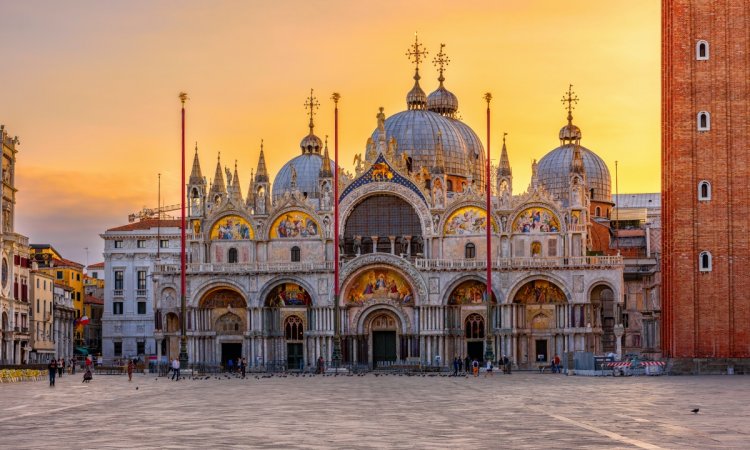
Whether you're on your own pilgrimage or merely interested in art and architecture, we take you through some of Italy's most famous cathedrals, splendid churches and breathtaking basilicas you must visit on your trip. Let's dive into some of the most important holy sites Italy has to offer.
St Mark's Basilica - Venice
Along with the Doge's Palace, St Mark's Basilica is one of Venice's must-see attractions and one of the most famous cathedrals in the world. Located in the center of the city in the Piazza San Marco and known as the "Church of Gold", this cathedral has splendid decorations that have been continually updated since the original construction in 1093. No reservations are required for holy masses, though you may want to check the Basilica's website in advance. Dress appropriately—most churches in Italy won't accept shorts or bare shoulders. The most famous piece of art in the church is the Triumphal Quadriga, a sculpture of four bronze horses that functions as the Basilica's symbol. With a storied history—including being looted by Napoleon—these sculptures date back to Roman times. Designed as part of the facade the horses sat for centuries on the loggia above the porch, but have since been moved inside for preservation purposes.
Milan Cathedral
This seat of an Archbishop, currently the 3rd largest in the world, took over 600 years to complete. A massive Gothic design in white marble, this famous cathedral is truly a sight to behold. There's a dedicated entrance if you're entering as a worshipper, though we recommend reviewing the timetable of services before your visit. The cathedral offers many options for regular tours for visitors. Climb the epic staircase for views of Milan, or, if you don't feel like taking the 250 steps, there is also an elevator. The architecture and rooftop views steal the show, so don't miss going to the top.
Less famous outside of Italy, Assisi is known within Italy as one of the icons of Italian Catholicism. It's also a popular spot for Italians to celebrate Christmas, so if you're in Italy to celebrate the holidays, add it to your itinerary! The city honors San Francesco, aka Saint Francis, who historically is thought to have invented 'presepe', nativity scenes in public. Not surprisingly, you'll find some incredible nativity scenes in Assisi's main square for the holidays.
Pisa Cathedral
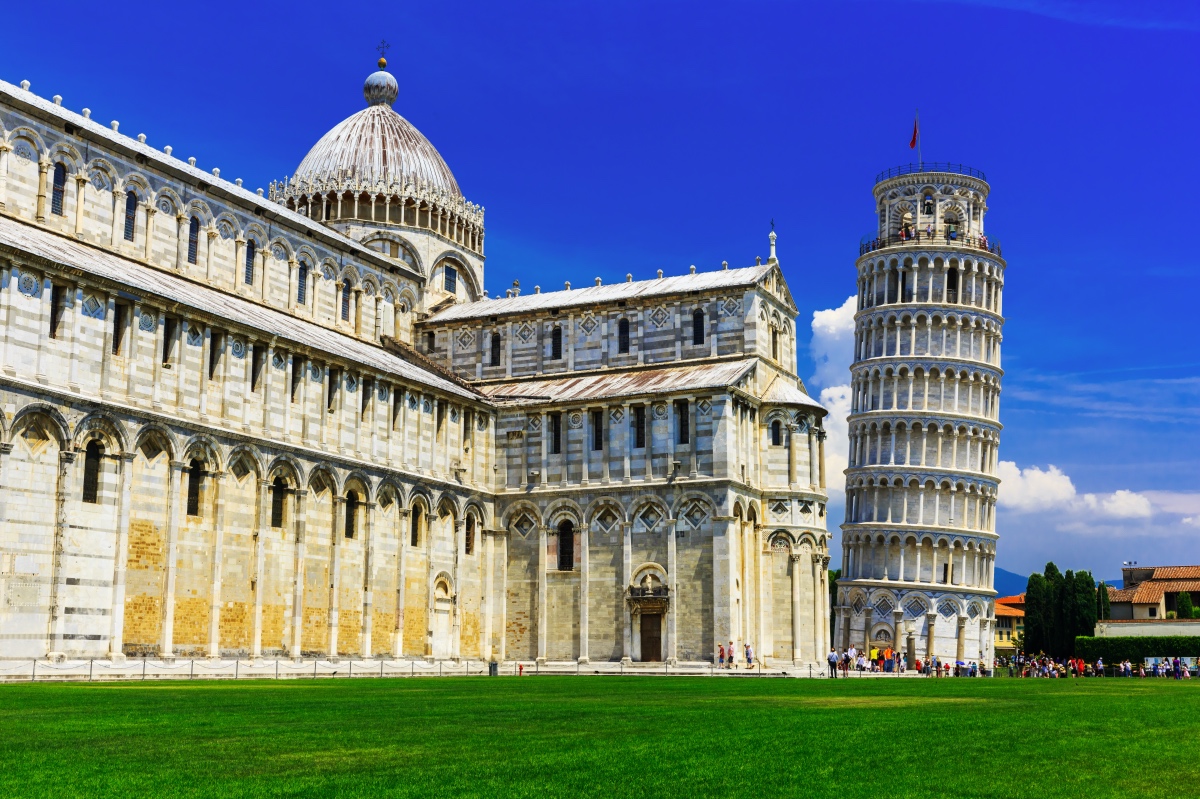
Adjacent to the infamous Leaning Tower , Pisa Cathedral, a classic example of Romanesque architecture, was built in 1118. Constructed with the wealth of the very cosmopolitan for the time Pisan merchants, the building contains Islamic, classical, and Byzantine elements. The cathedral has undergone major restorations over many periods, so it contains a wide variety of architectural styles. Famous in its own right, the Leaning Tower of Pisa is actually the cathedral's bell tower. You'll enjoy the bronze doors and finely worked marble alternating in black and white.
Santa Maria del Fiore - Florence
Known as 'Il Duomo', this famous cathedral is unmissable. The cathedral's epic octagonal dome designed by Brunelleschi, was one of the greatest feats of architecture of the Renaissance period and still serves as the symbol of Florence . At the time, the dome's size was considered impossible to build, but Brunelleschi was able to make it a success. Now it's a UNESCO World Heritage Site. Towering over the skyline of Florence, you'll spot the marble pink and green panels on the outside from afar. Liturgical services happen daily , while the confessional is also publicly available.
Vatican City - Rome
Technically not part of Italy, the Vatican is its own city-state (i.e. country) within Rome. The immense size of the place of worship can not be underestimated. The Vatican contains many churches, monuments, and museums, visiting all of which could take days. Michelangelo's Cappella Sistina (Sistine Chapel) is a must-visit, but there are a ton of things to do and see. We'd recommend doing a bit of research and planning so that you can make sure you catch the things you'd like to see. Not only is attending services at the Vatican possible, you may also be lucky enough to visit on a Papal audience day. Definitely, something not to miss!

All The Holy Pilgrimage Sites In Italy To Visit In 2024
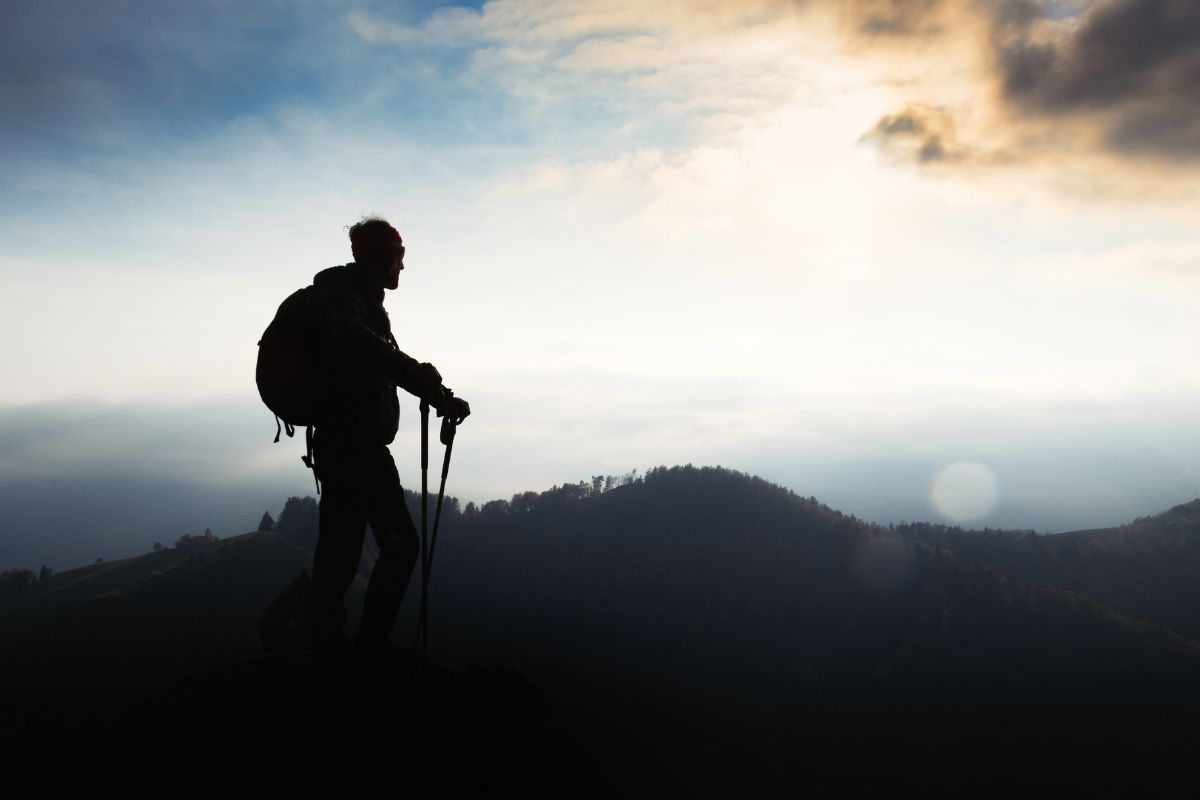
Published March 26, 2024
Italy, a realm of timeless beauty and profound spirituality, calls upon pilgrims worldwide to embark on a sacred journey. Its profound cultural legacy forms the backdrop of a spiritual quest that transcends the boundaries of time and place. As we explore the grand churches, shrines, and monasteries, we find art, history, and a path to enrich our faith.
A pilgrimage in Italy transforms into a journey of self-discovery and divine connection. In this article, we’ll uncover the journey’s essence. We’ll trace its ancient origins and reveal the spiritual gems. Several notable pilgrimage sites in Italy await those in search of profound faith.
The Importance Of Pilgrimage In Italy
Pilgrimages have played a significant role in Italy’s religious heritage for centuries. Since medieval times, devout Christians have traveled the Via Francigena and similar paths, which can be traced back to ancient Rome. They sought spiritual enrichment and enlightenment.
As for spiritual meaning, a pilgrimage is a deeply personal spiritual journey. It lets pilgrims form deeper connections with their faith. Each sacred site has its meaning. Many religious sites in Italy are associated with saints or miracles, offering pilgrims a chance for reflection, prayer, and spiritual growth.
Must-Visit Pilgrimage Sites In Italy For 2024
If you’re considering your first pilgrimage in Italy, here are several highly recommended options. They’ll let you explore the rich history. You can see the breathtaking architecture and spiritual significance of this beautiful country.
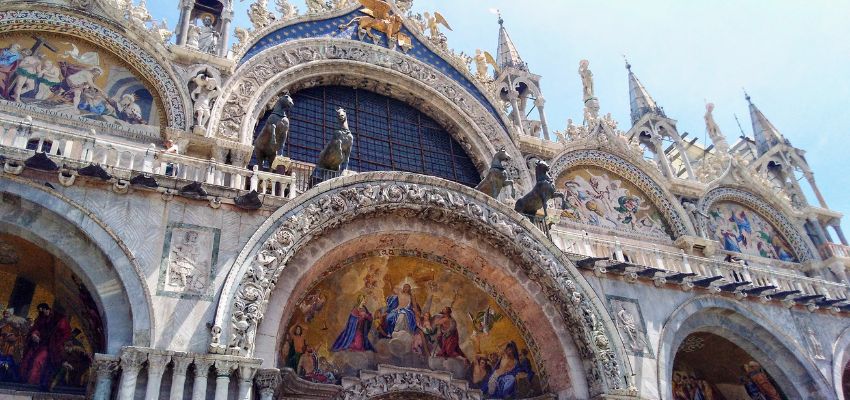
St. Mark’s Basilica, Venice
St. Mark’s Basilica is in Venice, Italy. It’s a revered pilgrimage destination famous for its mix of Byzantine architecture and historical importance. The basilica has intricate mosaics and majestic domes. They form a captivating sight, embodying a blend of art and spirituality.
It’s one of the world’s most famous cathedrals. It plays a crucial role in Christian pilgrimage, offering a glimpse into its great past and lasting importance. St. Mark’s Basilica attracts visitors annually, captivating them with its timeless elegance and cultural heritage.
Upon entering, guests see the elaborate facade adorned with detailed carvings that tell Venice’s rich history. Inside, a treasury of artistic wonders awaits. It has exquisite frescoes and ornate altars, each contributing to the basilica’s reputation as a masterpiece of religious art.
The ambiance exudes reverence and awe. Sunlight filters through stained-glass windows, adding to the spiritual aura. Visitors are taken through time, connecting with centuries of tradition and devotion that fill the surroundings.
The significance of the basilica surpasses its architectural grandeur; it encapsulates Venice’s cultural heritage and spiritual dedication. St. Mark’s Basilica’s elements tell a story, from the intricate mosaic designs to the soaring domes reaching toward the heavens. It’s a homage to the craftsmanship and faith of past epochs, a living testament to the enduring impact of art and spirituality.
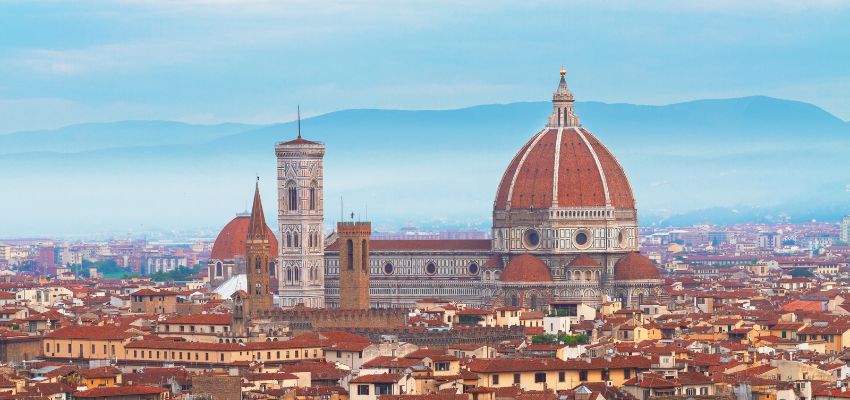
The Cathedral of Santa Maria del Fiore, Florence
The Cathedral of Santa Maria del Fiore in Florence, Italy, stands out as one of the country’s most iconic structures. It’s renowned for its grandeur and intricate design. The building is an architectural marvel and a testament to the brilliance of the Renaissance era.
Referred to as the Duomo, Filippo Brunelleschi’s impressive massive dome distinguishes this cathedral. This is the largest red-tiled dome made of brick and mortar in Florence. It dominates the skyline and provides breathtaking views of the city.
Stepping inside, visitors see great works of art. For example, they can glimpse the inner dome’s fresco “The Last Judgment” by Giorgio Vasari and Federico Zuccari. The cathedral boasts a stunning floor decorated with intricately designed mosaics, contributing to its charm.
The cathedral is a peaceful haven for spiritual reflection, allowing visitors to experience a sense of sacredness and spiritual connection. This experience is further enhanced by the magnificence of the Renaissance-style artwork and architecture surrounding them.
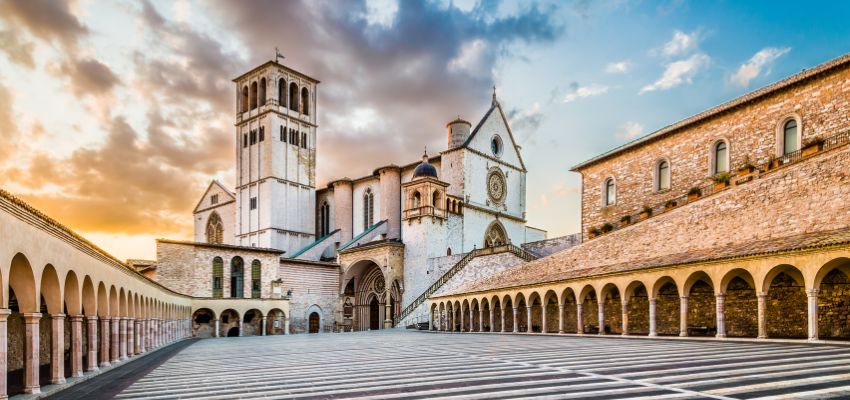
Basilica of St. Francis of Assisi—Assisi, Italy
The basilica is in the heart of Italy. It’s a revered pilgrimage site that draws millions of visitors each year. The basilica complex is dedicated to St. Francis of Assisi, the patron saint of Italy and the founder of the Franciscan Order. The complex has two churches—the Upper and Lower Church—and a crypt where the saint’s remains rest. Each component holds distinct spiritual value.
The Lower Church mirrors St. Francis’ humble life. The Upper Church showcases 28 captivating frescoes by Giotto. They illustrate his life and enrich the spiritual ambiance. The crypt is the holiest part of the basilica. It serves as St. Francis’ final resting place. It attracts pilgrims seeking solace and divine help.
Pilgrims can attend Holy Mass or explore the mesmerizing frescoes. A visit indeed guarantees a transformative spiritual voyage.
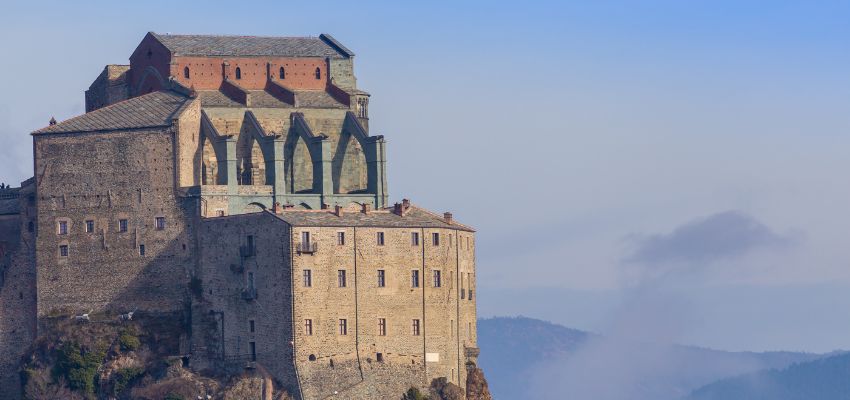
Sacra di San Michele—near Turin
Sacre di San Michele is located near Turin, Italy. It’s a captivating ancient Benedictine abbey meticulously built between 983 and 987. Perched on top of a majestic mountain, it offers panoramic views of the landscape and is a powerful symbol of its creators’ dedication.
Key features of the abbey encompass the impressive entrance staircase, known as The Stairway of the Dead, where the remains of past monks are solemnly entombed. Visitors also love the detailed Portal of the Zodiac and the beautiful fresco Triptych by Defendente Ferrari. Be sure not to overlook the breathtaking vistas of the Susa Valley from the outdoor walkways.
The abbey is devoted to the Archangel Michael. This fills the place with a spiritual aura. It attracts pilgrims and tourists to experience its rich history and culture. As visitors explore this sacred place, they’re surrounded by an ambiance that echoes centuries of faith, art, and reverence. It creates an unforgettable journey through time.
The Route of the Seven Churches, Rome
The Route of the Seven Churches, also known as “Le Sette Chiese,” traces back to the Middle Ages as a revered pilgrimage trail in Rome. This spiritual journey leads pilgrims to seven essential basilicas. They are St. Peter’s, St. Paul Outside the Walls, St. Mary Major, St. John Lateran, the Holy Cross in Jerusalem, St. Lawrence Outside the Walls, and the Sanctuary of Divine Love.
Initiated by St. Philip Neri in the 16th century, this pilgrimage aimed to foster community and religious devotion. Each of these churches holds profound historical and spiritual significance. For example, St. Peter’s Basilica is revered as the resting place of Saint Peter, and St. Paul Outside the Walls enshrines the remains of Saint Paul the Apostle.
What sets this journey apart is not just the churches. It’s a profound pilgrimage experience. Roaming the streets of Rome invites pilgrims to reflect on their faith. They can submerge in the city’s vibrant history.
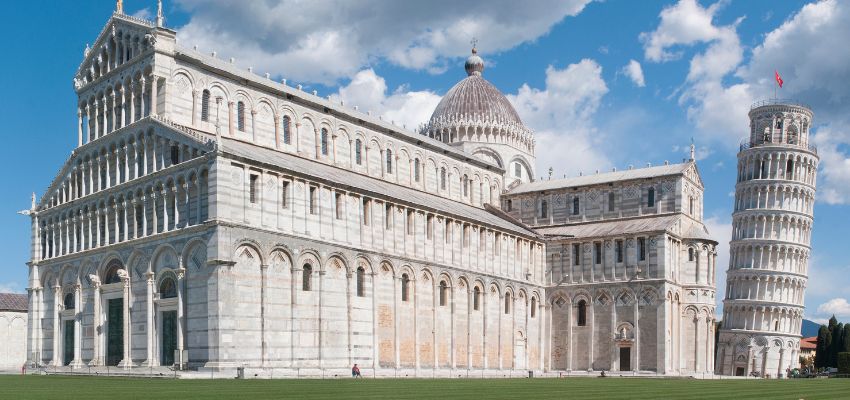
Pisa Cathedral
The Cathedral of Pisa, also known as the Cathedral of Santa Maria del Fiore, is in the picturesque city of Pisa, Italy. It’s a stunning example of Romanesque architecture. This historic masterpiece features intricate carvings and ornate details that showcase the artistic brilliance of its era.
The tower is famous for its lean. It’s a symbol of wonder and a puzzle of engineering. It has fascinated travelers and scholars for centuries. Beyond its religious importance, the cathedral honors the region’s cultural legacy and art. It draws curious minds worldwide to admire its timeless beauty and history.
Holy Shroud—Turin, Italy
The Holy Shroud of Turin, also known as the Shroud of Turin, is one of Christianity’s most revered and enigmatic relics. It’s housed in the Saint John the Baptist Cathedral in Turin, Italy. Many people believe it’s the burial cloth of Jesus Christ.
This linen shroud bears a faint image of a man with crucifixion wounds, mirroring the account of Jesus’ suffering in the New Testament. Discovered in 1898, the negative image, more distinct when viewed as a photo negative, continues to intrigue scholars. Debates about its origin and authenticity continue. The Shroud remains a profound symbol of faith for many believers. It serves as a spiritual anchor to Jesus Christ and draws pilgrims to its revered location.
The relic is present against the backdrop of the cathedral’s reverent ambiance, creating a space for thought, devotion, and deep connection with the divine.
The Via Francigena
The Via Francigena is a pilgrimage from Canterbury, England, to Rome, Italy. Pilgrims have traveled this route since the Middle Ages. Archbishop Sigeric detailed it in the 10th century as he walked from Canterbury to Rome.
The Via Francigena is 1,800 kilometers long. It leads pilgrims through the stunning lands of England, France, Switzerland, and Italy. It unveils rural fields, quaint villages, and bustling cities. The Italian stretch is a treasure trove of culture and history, boasting Siena’s medieval allure and Tuscany’s hilltop castles.
Long-distance walking is hard, but this trip is a unique way to immerse yourself in Europe’s culture and history.
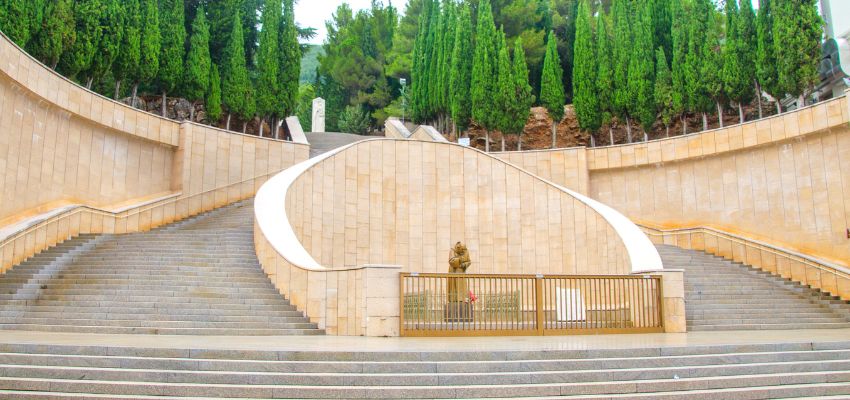
St. Padre Pio Shrine
The St. Padre Pio Shrine is a significant pilgrimage destination in San Giovanni Rotondo, Italy. This contemporary church, finalized in 2004, was crafted by the renowned Italian architect Renzo Piano. It’s devoted to Saint Padre Pio , a Capuchin priest known for his devoutness and kindness. He also bore wounds like those of Jesus.
He was the foremost stigmatist and most prominent mystic of the 20th century. Countless miracles have been ascribed to Padre Pio’s intercessions. During his life, the saint became a symbol of hope. Since his passing in 1968, he has continued to inspire people worldwide.
The shrine is also known as the Padre Pio Pilgrimage Church. It can seat 6,500 worshipers and has space for 30,000 more standing outside. Its construction aimed to serve the influx of pilgrims who journey there annually. Padre Pio’s body rests intact at the shrine. It welcomes around 6 million visitors annually, establishing it as one of the world’s most loved pilgrimage sites.
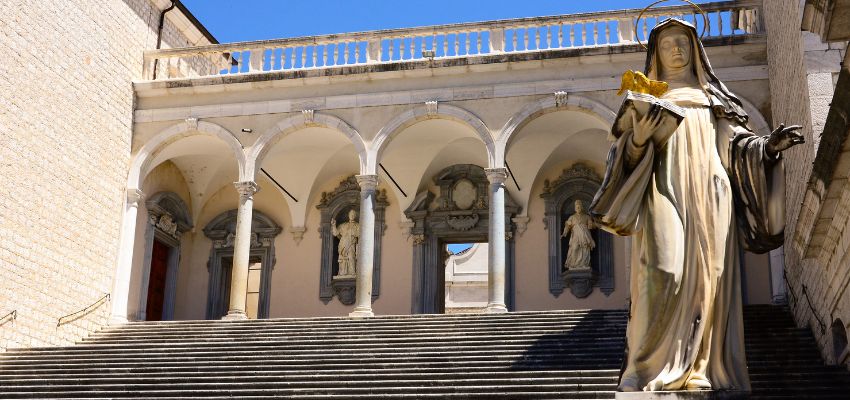
The Montecassino Abbey
The Montecassino Abbey in Italy is a remarkable pilgrimage site steeped in centuries of profound history. Founded by St. Benedict in the 6th century, this iconic abbey is one of the oldest monasteries globally. The abbey endured many adversities. It was destroyed and rebuilt four times. But, it has shown unparalleled resilience.
Its historical importance is woven into time. Montecassino Abbey captivates visitors with its rich past, stunning views, ancient chants, and tales of survival and revival. These make It an extraordinary place, embodying endurance and cultural heritage.
Sanctuary of Santa Rosalia
Nestled in a cave atop the picturesque Mount Pellegrino in Palermo, Sicily, the Sanctuary of Santa Rosalia is a tranquil pilgrimage site. It’s dedicated to Saint Rosalia, the revered patron saint of Palermo. The sanctuary offers a space for contemplation amid Sicily’s stunning landscape. Visitors are attracted to its spiritual significance and the scenic views of the surrounding area.
Ancient stone walls and intricate carvings mark the sanctuary’s architecture. It reflects Sicily’s rich history and cultural heritage. A peaceful ambiance envelops visitors, who wander along winding paths to hidden grottoes and prayer niches.
The interior is lit by candlelight and has a warm and inviting atmosphere that fosters reflection and spiritual connection. Each visit to the Sanctuary of Santa Rosalia promises a mix of history, spirituality, and natural beauty. It offers a memorable experience for all who pilgrimage to this sacred place.
San Luca Pilgrims’ Walk in Bologna
The San Luca Pilgrims’ Walk is in Bologna, Italy. It’s a remarkable pilgrimage path, winding through the region’s picturesque landscapes. It connects the lively city to the peaceful Sanctuary of the Madonna of San Luca.
As pilgrims embark on this spiritual journey, they’re welcomed by the breathtaking sight of the world’s longest-covered portico, a UNESCO World Heritage Site. It’s a tribute to the architectural wonders of the past and acts as a journey through time, inviting visitors to look into the area’s rich heritage.
The serene atmosphere and deep sense of spirituality that fill the path make it a significant destination for religious travelers seeking solace and a connection with the divine.
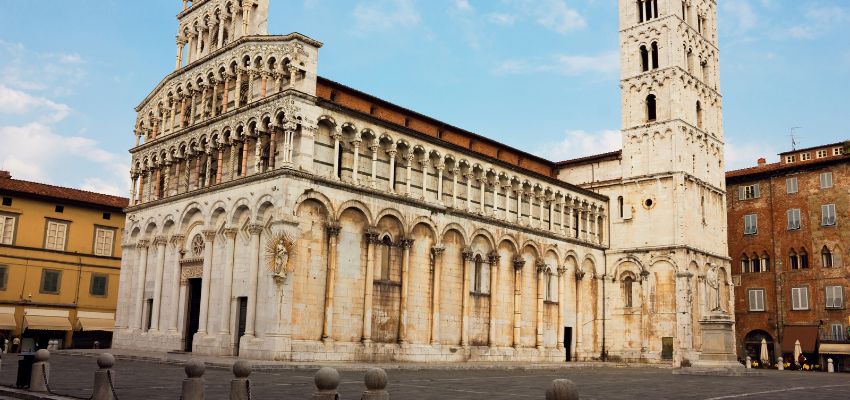
Lucca, Italy
Lucca, Italy, is in the picturesque heart of Tuscany. It captivates visitors with its exquisitely preserved Renaissance city walls. These historic fortifications encircle the city, honoring its rich history and cultural importance.
Lucca is a revered pilgrimage site. Its many grand churches and towering structures symbolize faith and great architecture. The cityscape has a mix of historical and religious landmarks. They blend harmoniously and create a charming atmosphere, mesmerizing tourists and pilgrims. This irresistible charm attracts curious travelers worldwide, immersing them in Lucca’s timeless beauty and historical heritage.
Sacre Monte di Orta
Monte di Orta, situated in the charming Piedmont region, stands out among Italy’s Sacred Mountains. This revered site has 20 intricately adorned chapels. Each vividly shows the life of St. Francis of Assisi . They do so through a captivating blend of art and sculpture.
Visitors who wander through this sacred space embark on a profound journey through history, art, and spirituality. They are immersed in the rich cultural heritage preserved within these architectural gems.
The chapels are full of art and deep meaning. They offer an immersive experience. It lets guests connect with the mountain’s deep legacy and artistic brilliance.
Unveiling The Soulful Tapestry Of Pilgrimage In Italy
A pilgrimage in Italy is more than a trip. It’s a cultural odyssey, a pursuit of spiritual awakening amid the whispers of bygone eras. Let the charm of Italy’s sacred grounds motivate you to commence your quest. People seek Italy’s hallowed spots for personal growth, historical understanding, or a deeper spiritual bond. They’re timeless gateways to a transformative journey. An Italy pilgrimage will take you into a realm where faith and heritage intertwine in an unforgettable waltz.
Seek a Deeper Connection with God and Join Lay Cistercians of South Florida
Lay Cistercians of South Florida , is a community of lay people who seeks to have a deeper connection with God by living a life inspired by the monks and nuns through Lay Monasticism . Learn more about what is a Lay Cistercian on our website. Anyone who aspires to do the same as us, and is a confirmed Catholic is welcome to join us! We meet every second Saturday of the month at Emmanuel Catholic Church in Delray Beach, Florida.

This Content Has Been Reviewed For Accuracy
This content has undergone comprehensive fact-checking by our dedicated team of experts. Discover additional information about the rigorous editorial standards we adhere to on our website.

About The Author
Hello there! I’m Corinne Grace . I believe in the power of storytelling to connect and educate, which is why I strive to bring each article to life with clarity and purpose. It’s not just about what’s written, it’s about making an impact on the reader.
Related Posts

Catholic , Christian Advice
How To Do A Prayer Walk As A Catholic
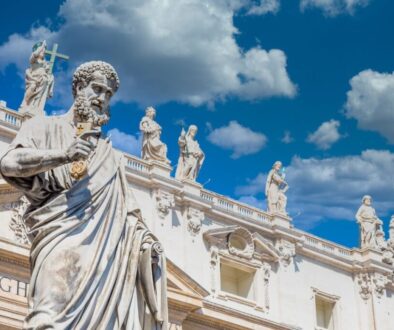
Inspirational Quotes From Saints For Young Catholics

5 Catholic Traditions Embraced by Millennials

Blog ✣ About ✣ Statutes
View Cistercian Publications
Helpful Resources
© Copyright LayCistercians.com 2024
View Our Privacy Policy
Web Design by Correct Digital

Hardcore Italians
is an Italian-American blog covering Italian culture, news, recipes, and more! © 2024 Hardcore Italians. All rights reserved.

7 Pilgrimage Sites You Must See in Italy
Italy and the Catholic Church have shared a long history. The country has been the seat of papal power for generations, and many religious events have taken place within their borders. Every year, thousands of people flock to Vatican City to receive a blessing or tour the magnificent city. However, there are many other pilgrimage sites across the country.
If you are looking to make your own religious journey, or are simply curious, here are seven of the best places to see.
We will start will Assisi, arguably one of the most well-known religious sites after Vatican City. This central Italian town was home to St Francis and St. Clare and where both saints established their holy orders.
Visitors should stop at the Basilica of Saint Francis of Assisi and the Basilica of Saint Clare to pray over the remains of each saint. The Basilica of Saint Mary of the Angels should also be on the list as it houses the tiny chapel St. Francis built per God’s request. Those are only three of about a dozen religious sites in Assisi. Anyone who visits will be able to explore every step of St. Francis’ life and ministry.
2. The Abbey of San Galgano in Chiusdino
Located in Chiusdino about 20 miles from Siena, The Abbey of San Galgano houses the sword in the stone. The story goes that Galgano was a wealthy lord who was visited by Saint Michael the Archangel. Michael told Galgano to give up his earthly possession and serve God. Galgano responded it would be easier to stab his sword into stone. He went to demonstrate, but instead of bouncing off, his sword slid right in. Galgano then devoted his life to the Lord and lived the rest of his days as a hermit. Four years after his death, he was canonized, and the Abbey of San Galgano was built around the sword and stone, where they remain today.
3.Our Lady of the Flowers in Bra

On a winter evening in 1336, a pregnant woman, named Egidia Mathis, walked past a pillar with the images of the Virgin Mary and baby Jesus. A little ways further, she came upon two soldiers who meant to harm Egidia. She rushed back to the pillar and prayed to the Mother for her intercession. Suddenly, a bright light shone, and Mary appeared before Egidia and the soldiers. Frightened, both men ran off, leaving Egidia unharmed. Meanwhile, the nearby bushes covered in snow and ice, burst into bloom.
Every year since these bushes have flowered between December 25 and January 15. Additionally, the flowering season has extended each time the Shroud of Turin has been on exhibition. The nearby church, The Sanctuary of Madonna dei Fiori, commemorates this miraculous appearance.
4. The Shroud of Turin
Housed in the Cathedral of San Giovanni Battista, this ancient linen cloth is believed to be Jesus’ burial shroud. The fabric features an imprint of a man’s face. There are also blood stains that correspond with Jesus’ crucifixion wounds, cuts from the crown of thorns, and lacerations to the back. The apostles reportedly found the shroud in the tomb after Jesus had risen. It is unknown what happened to it in the interim years, but it has been in the Cathedral since 1578.
5. The Incorrupt Body of Saint Angela Merici in Brescia

At the age of 15, Angela Merici began having visions. These visions told her one day she would lead other women to God. Up to this point, Angela had been a devout Christian, but the manifestations increased her devotions and eventually led her to join the Third Order of St. Francis. Fiver years later, she returned to her childhood home of Desenzo and found many of the local girls were uneducated and had little hope for the future. She began teaching the girls about the Catholic faith and had great success in leading them to a life devoted to Christ. Eventually, Angela received another vision, which instructed her to open an official institution for young women’s religious training. She would go on to establish the Institute of Saint Ursula.
Later in her life, Angela made a pilgrimage to the Holy Land, where she was suddenly struck blind. She continued with her journey, and upon her return, her sight was restored. Angela also used to pray at the tombs of the Brescian martyrs at the Church of St. Afra. Later, the Church was renamed, The Church of Saint Angela, after her uncorrupted remains were unearthed in the 1930s. Her remains are still currently preserved there.
6. The Spring of Our Lady of Sorrows

In 1888 in the countryside of Castelpetroso, two farmers were out looking for a missing sheep. They split up, and one of the men located the sheep outside a cave. As the farmer approached, he saw a light inside the cave and a vision of Our Lady of Sorrows at the Cross. When the other farmer arrived, he saw nothing. However, both men returned to the spot ten days later, and the vision appeared again.
Later that same year, after word had spread, the local Bishop visited the spot where he too saw Our Lady of Sorrows. Additionally, a spring appeared near the cave. Since then, thousands have visited the site, including Pope John Paul II and Pope Francis. There is also a nearby Basilica dedicated to this miracle.
7. The Shrine of Our Lady of Bonaria

Found on the island of Sardinia, this shrine is the country’s oldest. On March 25, 1370, a storm threatened to sink a merchant ship sailing from Spain. The crew started dumping the cargo overboard to save the ship. They unloaded the biggest crate last, and as soon as it hit the water, the storm stopped. The container eventually washed up on the shores of Bonaria, where the local fishermen attempted to open the crate. When their efforts failed, they called upon the Mercedarian Friars to come out. The friars had no issues with the cargo, and inside they found a statue of Mary holding baby Jesus and a lite candle. The statue now resides in the Basilica of Our Lady of Bonaria.
- The Basilica of Saint Mary of the Angels , Asissi , San Galgano , Our Lady of Flowers, Saint Angela, Our Lady of Sorrows [Catholic Travel Guide]
- Shroud of Turin [Britannica]
- The Shroud [Christianity]
- Feature Picture [Wikimedia]
Share this:

Leave a Reply Cancel reply
This site uses Akismet to reduce spam. Learn how your comment data is processed .
Discover more from Hardcore Italians
Subscribe now to keep reading and get access to the full archive.
Type your email…
Continue reading
Loreto, Italy: visit the cathedral and Holy House of Mary in Loreto

Visit Loreto
Loreto is an important hill town to the south of Ancona , and home to one of the most important pilgrimage sites in Italy. It is inland from the Adriatic coast in the Marches region of central Italy.
The main attraction for visitors to Loreto - pilgrims or otherwise - is the imposing basilica and fortress complex which also includes the museum and the Holy House of the Virgin Mary.
You will find similarities at Loreto with Lourdes in France, with the combination of religious conviction, coachloads of sick people, important religious monuments and outright commercialism being rather unseemly if not outright troubling.
Exploring: Loreto Cathedral and Piazza della Madonna
A visit to Loreto can start from the large 'Piazza della Madonna' and the impressive Loreto Basilica , built by Pope Paul II (1417-1471). The work began in 1469 to a plan which foresaw the building of a church-fortress, because in 1468 the area had become subject to Turkish raids along the Adriatic coast.
The most talented architects of the time were called upon to design Loreto Basilica, such as Baccio Pontelli (1450-1492), Francesco di Giorgio Martini (1439-1501) and Giuliano da Sangallo (1484-1546). It was created in the gothic style, but after intervention by Giuliano da Sangallo it also took on a Renaissance tone, especially with the dome that clearly incorporates the style of Filippo Brunelleschi (1377-1466), responsible for the dome on the duomo in Florence .

The Istrian stone façade of the church was begun in 1571 by Giovanni Boccalini and completed by Giovanni Battista Ghioldi (1587) while the three doors of the façade were made by the Recanati School of Sculpture (16th-17th century). The belltower was a later work, by Luigi Vanvitelli [1700-1773].
The church has a Latin cross form (which means that the arms of the church are the same size) and under the dome is the “Holy House” of the Virgin Mary (see further down).
The town attracts several million visitors each year, including four million pilgrims, because of the story that the house of Mary - the Santa Casa - was flown here from the Holy Land by a group of angels in 1293. From late spring until autumn trains packed with pilgrims, the sick and the needy arrive in Loreto to attend mass which is held both inside and outside the cathedral.

The interior of the basilica is very important because it is decorated by the works and frescos of the most renowned painters of the time. The “Holy House of Mary" is a work of immense artistic value as well as religious, being clad with white marble to a design by Bramante (1444-1514).
In the sacristy you can see frescoes by Melozzo da Forli (1438-1494) and Luca Signorelli (1445-1523), while in the dome we have the "Four Evangelists" by Cristoforo Roncalli, known as “Pomarancio” (1553 ca.-1626). There are also numerous chapels in the cathedral containing various artworks.
Advertisement
To the left of the Basilica in the centre of Loreto is the Apostolic Palace , a work by Bramante and Antonio da Sangallo.
Loreto Museum and Art Gallery
Inside the Apostolic Palace is the Museum and Art Gallery, which features eight paintings by Lorenzo Lotto (1480-1556) who lived in Loreto the last years of his life, as well as tapestries and sacred furnishings. As well as numerous paintings the museum also contains other works of great value, which were donated by illustrious Italian and European personages who visited the shrine, including valuable donations by the Medici of Florence and Christine of Lorraine.
One of the highlights of the museum is the silver and ebony crucifix, a gift from Joan of Austria (1535-1573), the wife of Grand Duke Francesco I of Tuscany. This crucifix rests on a base of finely carved ebony and was the work of Giambologna, active at the court of Francis I. He specialized in small articles of an absolute technical perfection to suit the refined taste of the Prince, who loved to donate these small objects to foreign sovereigns and churches, to demonstrate the munificence of the Medici court in Florence.
Another extraordinary work, which was a gift by Christine of Lorraine (1565-1637), is the hanging that covers the front of the altar. At Christmas in 1620 Christina of Lorraine, particularly devoted to the Virgin, "who some years before had performed a miracle on her predecessor, healing from paralysis" donated this silver cloth with embroidered flowers of polychrome silk and adorned at the centre by a gold cross, flanked by arms of the Medici and Lorraine.
History tells us that this was also beautifully presented in a frame with a base in white and red jasper from Sicily, which rested on four pillars in lapis lazuli with bases in yellow jasper from Cyprus, and supporting a cornice with a frieze of amethyst and jasper plan.
The Holy House of the Virgin Mary
Because of its importance to the town it is useful to have some knowledge of the Holy House of the Virgin Mary. Remember that legend tells us that, in December 1294, the stones of the "house of Nazareth” were transported here by angels in flight.
In reality, studies have shown that transport by sea in some ships operated by the Crusaders is a more likely possibility. After the Christians were expelled from the Holy Land by the Muslims the “Holy House” was first transported to Trsat in Croatia (1291), then to Ancona in 1293 and finally to Loreto in December 1294.

Studies on the stones of the "Holy House" confirm their Palestinian origin, because they use techniques that seem typical of the work of the Nabataeans. There are numerous graffiti on the rocks, similar to Judeo-Christian-II of the fifth century and found in the Holy Land, particularly in Nazareth.
Inside the "Holy House" the image of Our Lady, the "Black Madonna", is venerated and is a typical colour of old icons due to centuries of smoke from oil lamps and candles. The original statue, dating from the 14th century, was brought to France in the Napoleonic age but it was destroyed by a fire in 1921. The present image dates from 1922 and is a work by Leopoldo Celani using cedar wood of Lebanon from the Vatican gardens.
Other things of interest in and near Loreto
Moving from the Basilica and continuing along Corso Boccalini you reach Porta Romana and the city-walls, built around 1520. Designed by Antonio da Sangallo the Younger, this gateway it was completed with four bastions in the 17th century. Enthusiasts of the Italian poet Leopardi can also visit his home - he was born in Loreto in 1798.
Along the coast of the nearby Adriatic Sea there are several well equipped seaside resorts such as Porto Recanati.
Loreto traditions
Woodworking and traditional handicrafts are one of the strengths of Loreto, which still offer articles worked in silver, ceramics and wood of excellent value. Equally important here is the tradition of cooking which uses tasty products such as “vincisgrassi”, “stuffed olives” and “crescia sfogliata”.
You can find more local travel ideas in and the Marche guide .
See also Find Loreto hotels
Map of Loreto and places to visit
Loreto places to visit.

The hill town of Recanati is well known for the Leopardi Palace and the many artworks to be seen throughout the town

Conero peninsula
The Conero peninsula includes popular seaside resorts, traditional villages and historic monuments

In Macerata you will see numerous interesting medieval buildings in and around the Piazza della Liberta

If you have an hour to spare before your flight from Falconara airport you might enjoy a visit to Ancona...

Both the basilica in Tolentino itself and the nearby Abbey of Chiaravalle de Fiastra are unmissable highlights

As well as the historic centre you will also enjoy the views from Fermo across the surrounding countryside
...or see all our recommended places to visit in Marche
Select your language
Site search

Palatine Chapel

Montepulciano

Italy This Way - copyright 2009 - 2024 :: privacy policy

The Catholic Travel Guide
Venice, Italy:
The catholic shrines & places of interest in venice:.
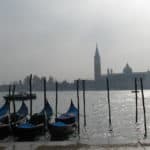
Most people associate this city with its winding canals and gondolas: Venice has about 150 canals, more than 400 bridges, and no cars, which means it is one of the worlds few pedestrian-only cities. Venice was at one time the most powerful nation-state in the region and traces of that still remain.
It is also home to some magnificent Catholic churches (well over 100 of them). Certainly the Basilica of Saint Mark and Saint Mark’s Square are some of its most recognizable sites, but there are others as well.
Basilica of Saint Mark
The tomb of Saint Mark
Basilica Santa Maria della Salute (Saint Mary of Health)
Probably the most recognizable of the churches in the city..built in honor for intercession during the plague of 1630-31.
Basilica Santa Maria Gloriosa dei Frari
Dedicated as well to the Blessed Virgin Mary this Basilica is known for its magnificent altar and works of art.
Church of Saint Germania (tomb of Saint Lucy)
Church of saint roch (chiesa di san rocco).
Tomb of Saint Roch…Patron Saint against plagues.
Traveling to Venice:
Venice has a major airport and is also easily accessable by train. For independent travelers who are flying and planning to hit the three most popular cities (Rome, Florence and Venice) we recommend an “open jaw” ticket: eg, fly into Rome and back out of Venice. That itinerary will give you more time in Italy since you can travel by train from Rome to Florence then on to Venice and fly back out of Venice rather than having to take the train back to Rome and then overnight in Rome before your flight home. It is like adding a full extra day to your stay without the extra cost.
Get train & bus schedules, see fares & buy tickets here .
Hotels in Venice are expensive , so if you are on a budget you might want to consider staying nearby in Mestre (5 miles away). It lacks the charm of Venice, but hotel prices are often half of what they are in Venice.
Another alternative is Padua . It is about 25 minutes away by train and, again, hotel prices are about half of what they are in Venice and there is frequent train service throughout the day. You can find train schedules here .
Click here to find restaurants and hotels in Venice, compare prices, and read what other travelers have to say at TripAdvisor
Click here for hotels in nearby Mestre, compare prices, and read what other travelers have to say at TripAdvisor
⇐ Back to Catholic shrines and places of interest in Italy
Leave a comment cancel reply.
You must be logged in to post a comment.

***Some of the links below are affiliate links, meaning that at no additional cost to you, I will receive a commission if you click through and make a purchase.***
Italy Pilgrimage – Top Sites For The Catholic Pilgrimage To Italy
Table of Contents:
Although Vatican city is a separate state, it’s enclaved within Rome. The home of Pope, the leader of all the Catholics around the world makes a pilgrimage to Italy a must-do for every follower of Jesus.
Although Rome and Holy See are full of important catholic sites, there are many more amazing places that you should visit during your Italy pilgrimage.
From the final resting places of the Saints to churches and sanctuaries- with help of our blogging friends, we’ve covered it all! Keep on reading to discover the absolute best Italy pilgrimage sites.
Here’s the map of the catholic places in Italy that you can find in this post:
Vatican City
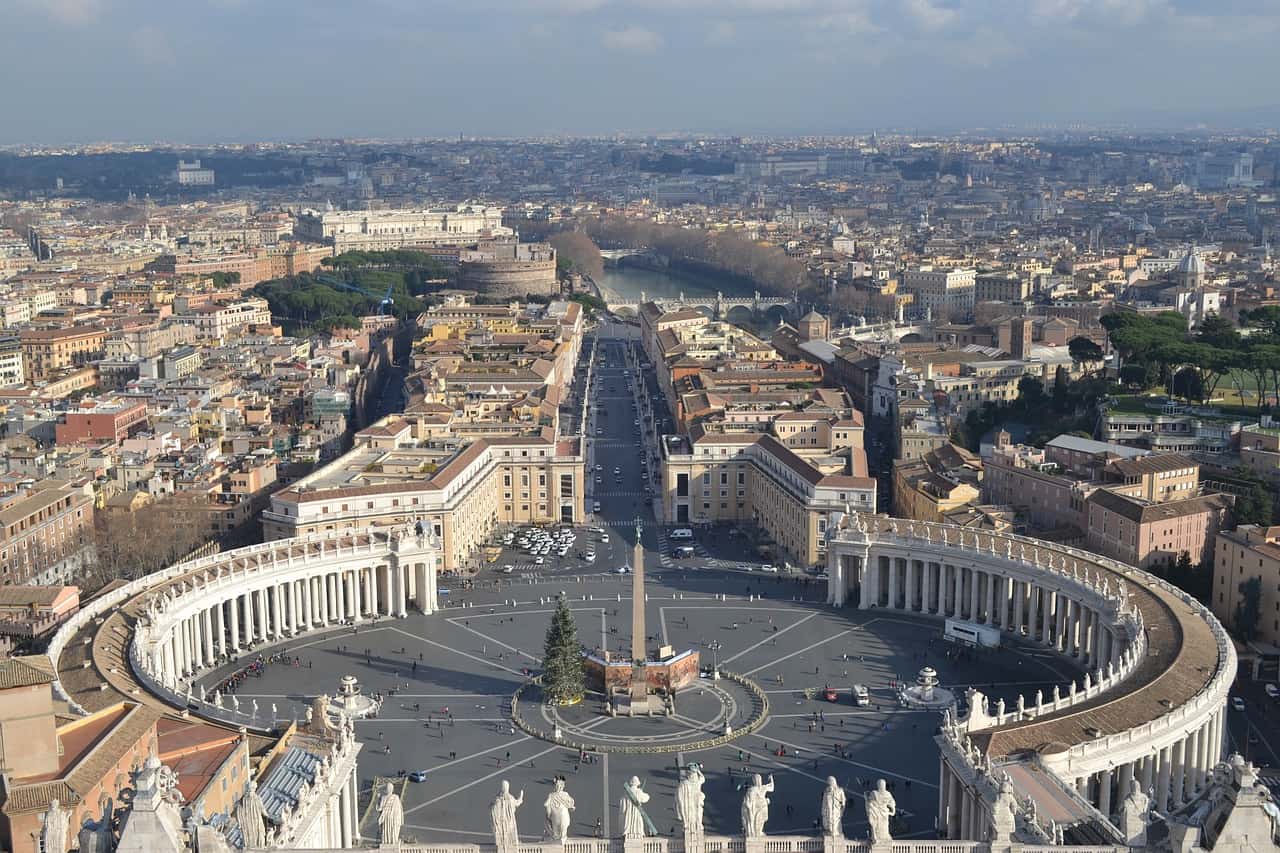
Basilica di San Pietro, also known as Saint Peter’s Church is one of the most iconic churches in the world, visited by millions of people every year. It is actually located in the Vatican which is fully enclosed by Italy , and it’s a popular stop for visitors to Rome in Italy. The basilica is one of the holiest Catholic churches in the world, and also the seat of the pope himself. Furthermore, it’s named after Petrus, who is said to be buried under the church.
Some points of interest include Grotte Vaticane, The pillars and the gigantic obelisk, Necropolis (where Petrus is said to be buried), La Pieta (sculpture by Michelangelo) and Cathedra Petri. In total, there are no less than 44 altars, 395 sculptures, 778 pillars and 135 mosaics in Saint Peter’s Church in the Vatican. It’s also one of the largest churches in the world with a spectacular dome with fine details and paintings.
The entrance is free, so if you come here in the morning, the lines will be relatively short. It’s the security check that takes time when all the tourist crowds arrive. There is also the possibility to buy a so-called skip the line ticket.
Additionally, as this is a holy site that is highly religious and very much still active, visitors must cover themselves and wear appropriate clothes with no bare shoulders. Both women and men should wear long pants as the dress code is very strict.
San Giovanni Rotondo
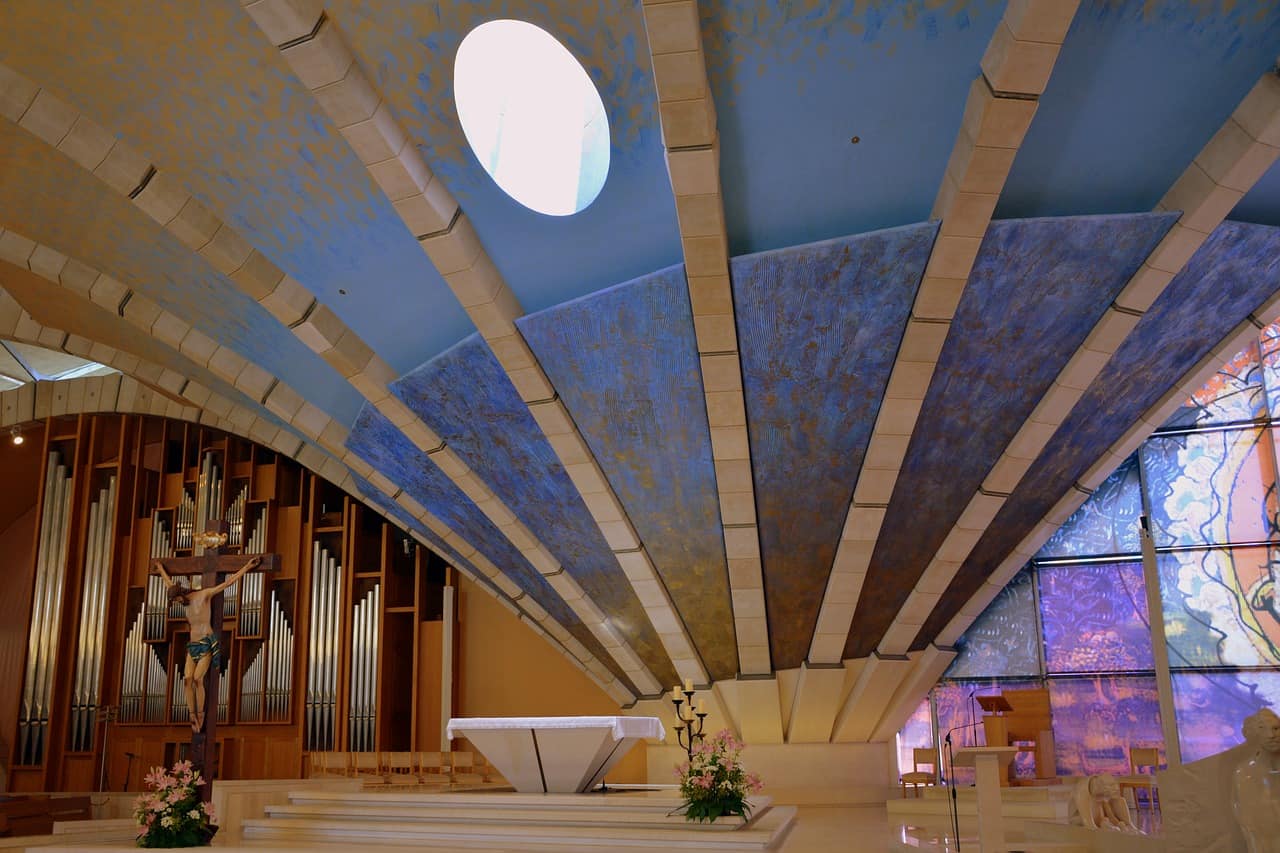
Why it’s one of the best Italy pilgrimage sites? San Giovanni Rotondo is a place where Padre Pio, one of the most famous Christians of the 20th century, has been living.
Padre Pio has been talking with God since he was a little boy. He has received the stigmata similar to the wounds of Christ, he was supposed to appear in the two distinct places at the same time (bilocation). Some say that he knew the sinners’ sins during the confession.
It’s believed that when Karol Wojtyla , a cardinal from Poland came visit him, he received the prophecy to become a pope one day. It became true after Padre Pio died. Karol Wojtyla has become John Paul II in 1978.
Hundreds of thousands of pilgrims are visiting San Giovanni Rotondo to this day only to visit the tomb of Padre Pio that is located in the Sanctuary of Saint Pio of Pietrelcina.
Santa Croce
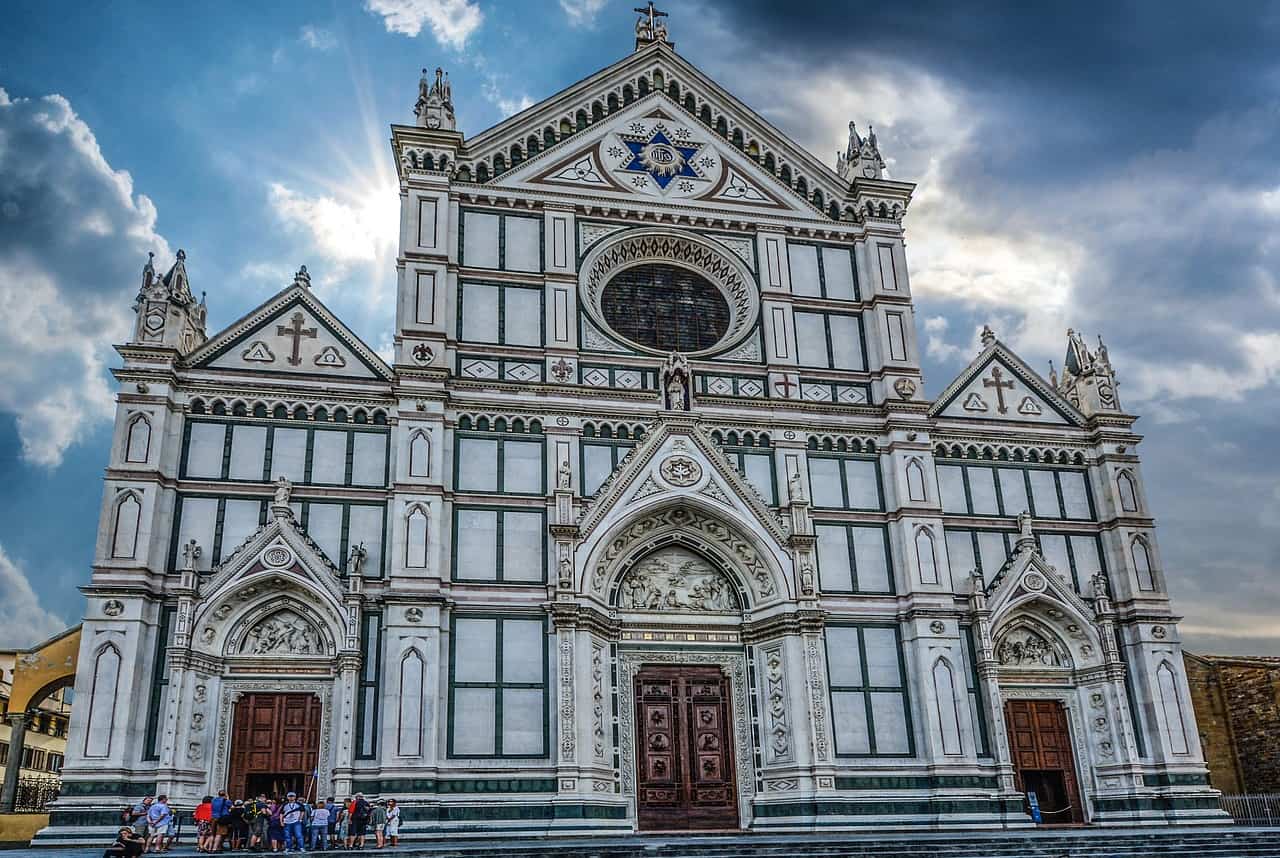
The Basilica of Santa Croce is the principal Franciscan church in Florence and arguably the largest in the world. Located only 850m or an easy 10-minute walk from the Cathedral of Santa Maria del Fiore, it is a church well worth visiting.
Whilst the Duomo is stunning and the main place of worship to visit, Santa Croce possesses greater cultural and religious significance.
Designed by Arnolfo di Cambio between 1294 and 1385, Santa Croce is famous as the burial place of illustrious writers, painters, architects, and composers such as Rossini, Machiavelli, Galilei, Ghiberti and none other than the great Michelangelo. For Dante lovers, he was once buried there but no longer.
His sarcophagus is empty and a memorial was erected instead. Hence, this place is also known as “The Temple of Italian Glories”. Whilst most people visit Santa Croce to pay homage to these tombs, it is actually the frescoes by Giotto in the chapels to the right of the altar that should command our attention.
Of the 16 chapels found in the basilica, the Peruzzi chapel covering the stories of the Saints John the Baptist and John the Evangelist and the Bardi family chapel which he painted seven episodes from the life of St. Francis, that is most magnificent.
The compound also possesses 3 cloisters, designed for silent contemplation, prayer, and meditation. You may walk around this area freely as you explore the magnificence of this church.
Basilica di San Nicola in Bari
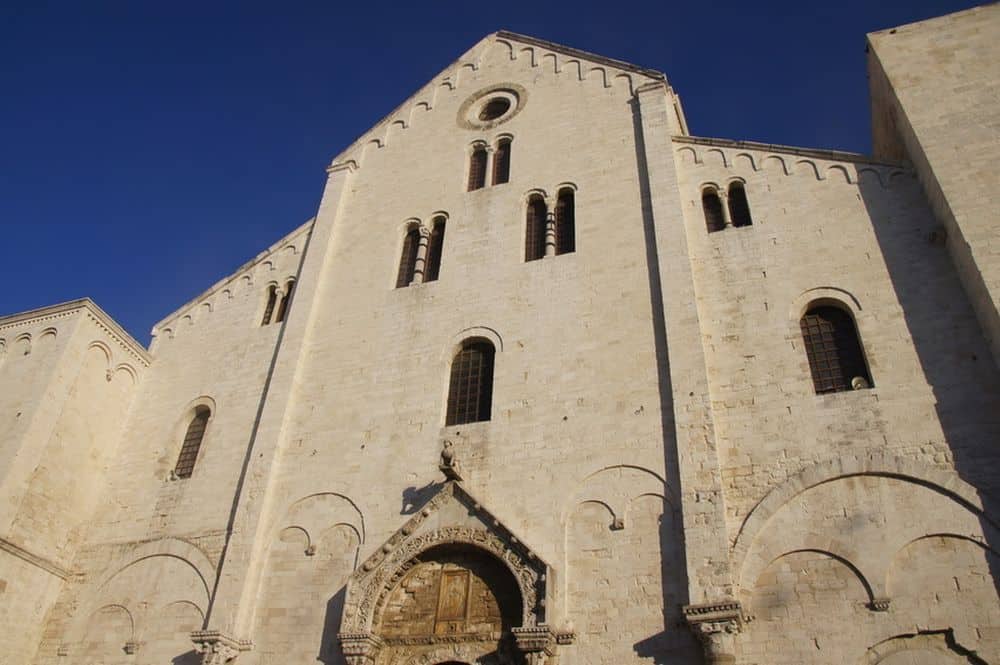
Bari , the capital of the Puglia region , is largely overlooked by tourists, who use the city mostly as a jumping-off point from which to catch a ferry elsewhere in the Mediterranean. But for Christian pilgrims, both Catholic and Orthodox alike, it’s a very important pilgrimage destination.
This is because Bari is the resting place of San Nicola, or St. Nicholas as he’s known in English. And yes, we’re talking about the same St. Nick who’s also known as Santa Claus !
Though the saint was originally from Turkey , in the 11th century a group of merchants from Bari stole his body and brought it back here with them, fearing that it would be desecrated by the Seljuq Turks if it stayed in Turkey. The Basilica di San Nicola was built shortly thereafter, and his body has been kept in the underground crypt ever since. From the outside, it looks more like a castle than a church. And indeed, it has been used as a castle several times over the course of its long history.
While there are some festivities on December 6, the official day of St. Nicholas according to the Catholic calendar, in Bari an even larger celebration of the saint takes place from 6 to 8 May. Events include a large fireworks display and historical reenactments. And of course, Christmas Day is also a wonderful time to come to Bari and pay homage to St. Nicholas!
The Sanctuary of Castelmonte
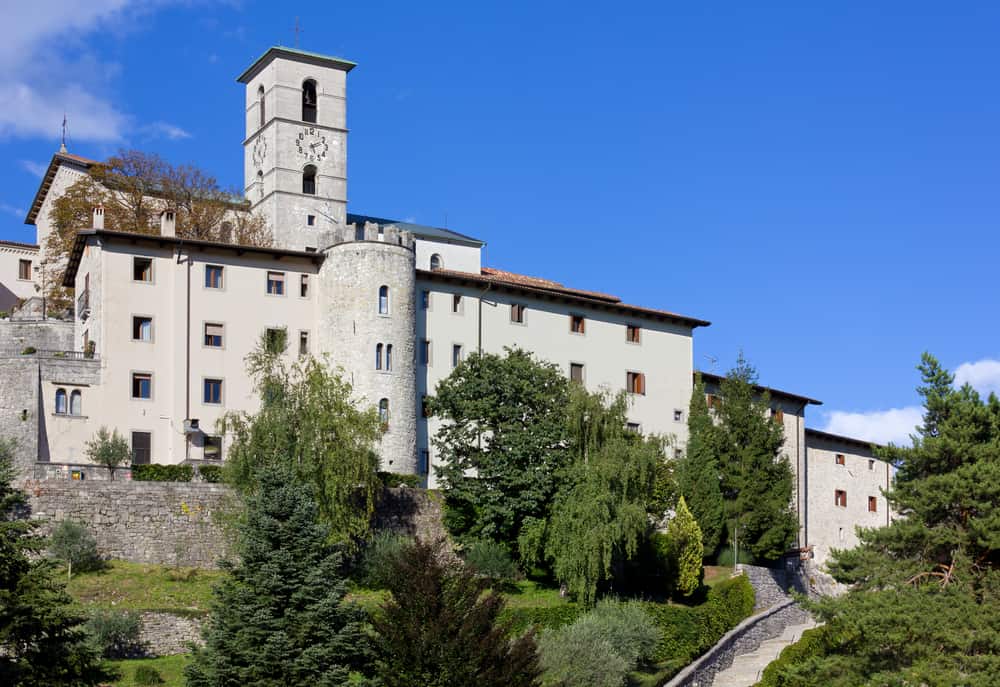
San Domenico Basilica in Siena
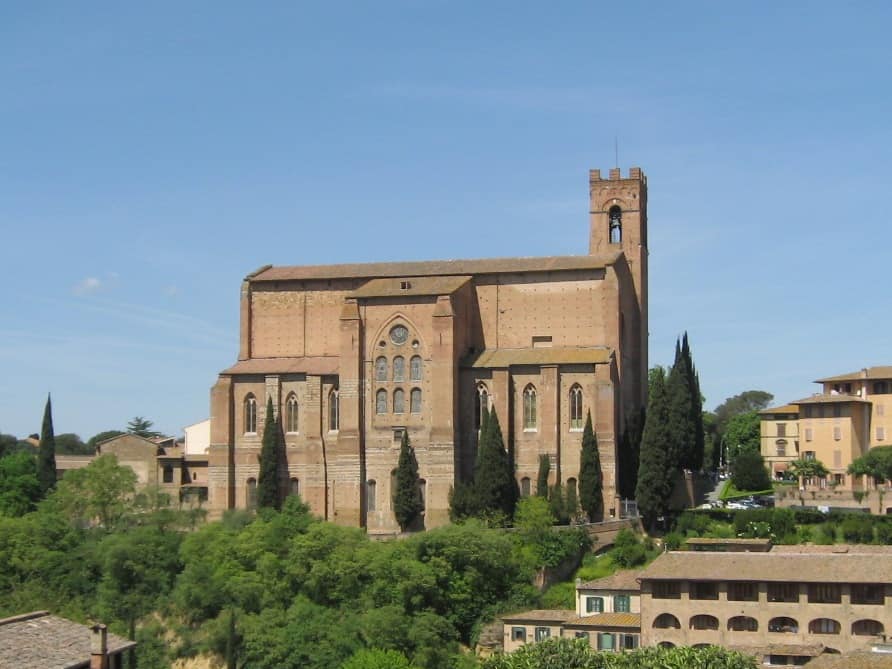
Siena is home to one of the Patrons Saint of Italy, Saint Catherine. Catherine was a local woman who devoted herself to the church. She was a mystic and advisor to many popes, princes, and cardinals.
Her reputation within the church was so strong that even as a woman, she was sent on missions and negotiated peace on behalf of the pope. After her death, devotion to her rose rapidly.
Catherine was buried in the cemetery of Santa Maria Sopra Minerva which lies near the Pantheon in Rome and later moved inside the Basilica, where she lies to this day.
However, as she was born in Siena, this created great unrest in her home city. Rumour has it that some of the people of Siena tried to smuggle her whole body out of Rome and instead decided to take only her head which they placed in a bag. When they were stopped by Roman guards, they prayed to Catherine to help them, confident that she would rather have her body (or at least part of it) in Siena. When they opened the bag to show the guards, it was full of rose petals.
Wherever the truth lies, Saint Catherine’s head is now on display and rests in The Chapel of Saint Catherine, in San Domenico Basilica, Siena. Rather a gruesome tale, however, Catherine is still considered one of the most prominent spiritual writers and someone with great boldness as women were not influencers of politics or history at this point in time.
To find San Domenico Basilica, head to the top of the hill Camporegio where you will see a huge Gothic red brick building. This is the resting place of Saint Catherine in Siena and has wonderful views over the city.
The St. Francis Basilica in Assisi

The St. Francis Basilica is one of the best destinations for the pilgrimage to Italy and to Europe in general. It is an incredible jewel in the crown of spiritual buildings in the city built in the 13th century in honor of St. Francis.
Assisi has been a UNESCO Site since 2000 and it attracts 5.5 million pilgrims, art lovers, and tourists from all over the world. Having been completed in 1253, the Basilica di San Francesco is the oldest Gothic church in Italy.
In fact, the basilica contains two churches, the upper one and the lower one. Since the church was designated as the headquarters of the Franciscan order the interior is beyond any comprehension.
The Upper Basilica has a different architectural style compared to the Lower Basilica. The Lower Basilica was built in the Romanesque style while the Upper Basilica is built in the Gothic style.
The interior of the Upper Church is a fine early example of the Gothic style in the country. Both churches are decorated with stunning frescoes by various late medieval painters. There is also a burial place of St. Francis near the Lower Basilica of Assisi.
While here, you can take a guided tour of the Basilica to learn about St. Francis and marvel at the magnificent frescoes. Given its significance as well as grandeur, the St. Francis Basilica is definitely a place to stop by. It’s a perfect spot to sit and watch the world pass you by.
The Basilica Duomo di San Vigilio in Trento
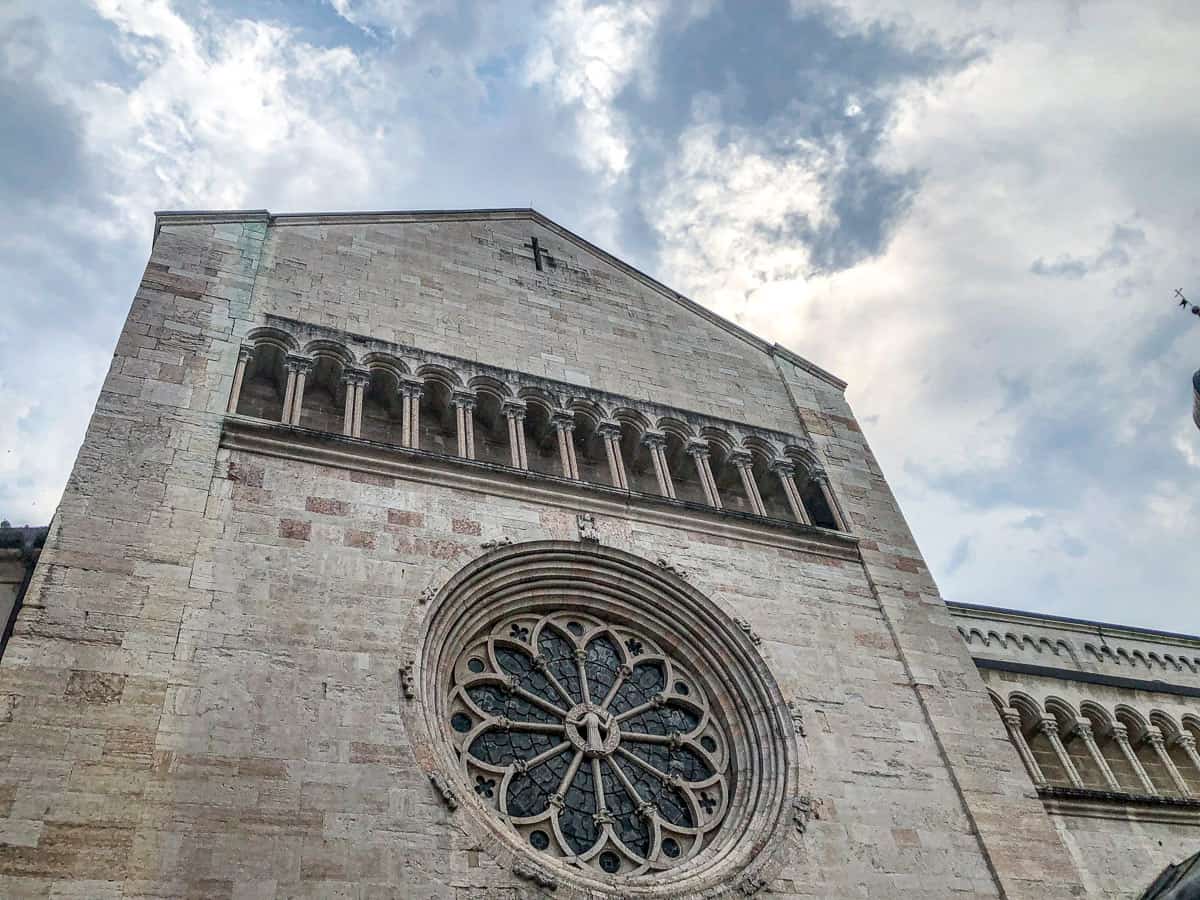
The Basilica Duomo di San Vigilio in Trento, Italy is a gorgeous example of a Romanesque Basilica and an important Pilgrimage site in Italy.
The Basilica is dedicated to San Vigilio, whose tomb you can visit in the crypt of the church. Saint Vigilius or San Vigilio lived in the 4th century and was said to have brought Christianity throughout the North of Italy, and was eventually martyred for doing so.
Connected to the Trento Basilica is the Cammino San Vili, a pilgrimage route through the surrounding towns passing many beautiful painted churches. You can follow the Cammino San Vili , or the San Vili Path, away from Trento to commemorate the route San Vigilio followed as he spread Christianity, or from Madonna di Campiglio back to Trento to commemorate the route taken when his body was carried back to Trento.
Whether for religious motivation or not, the San Vili Path offers gorgeous scenery through the Dolomites and passes through lovely small Italian towns. The city of Trento itself offers a castle to tour, a cable car to stunning views, a Diocesan Museum filled with relics and treasures from the Cathedral.
Call the Painted City, Trento is home to many famous and unique murals painted to commemorate the Council of Trent in 1545.
You can easily reach Trento within a few hours via train from Milan or Verona, and the city makes an excellent day-trip from Verona or Padova if you are looking for a cool, mountainous escape.
The Holy Face in Lucca
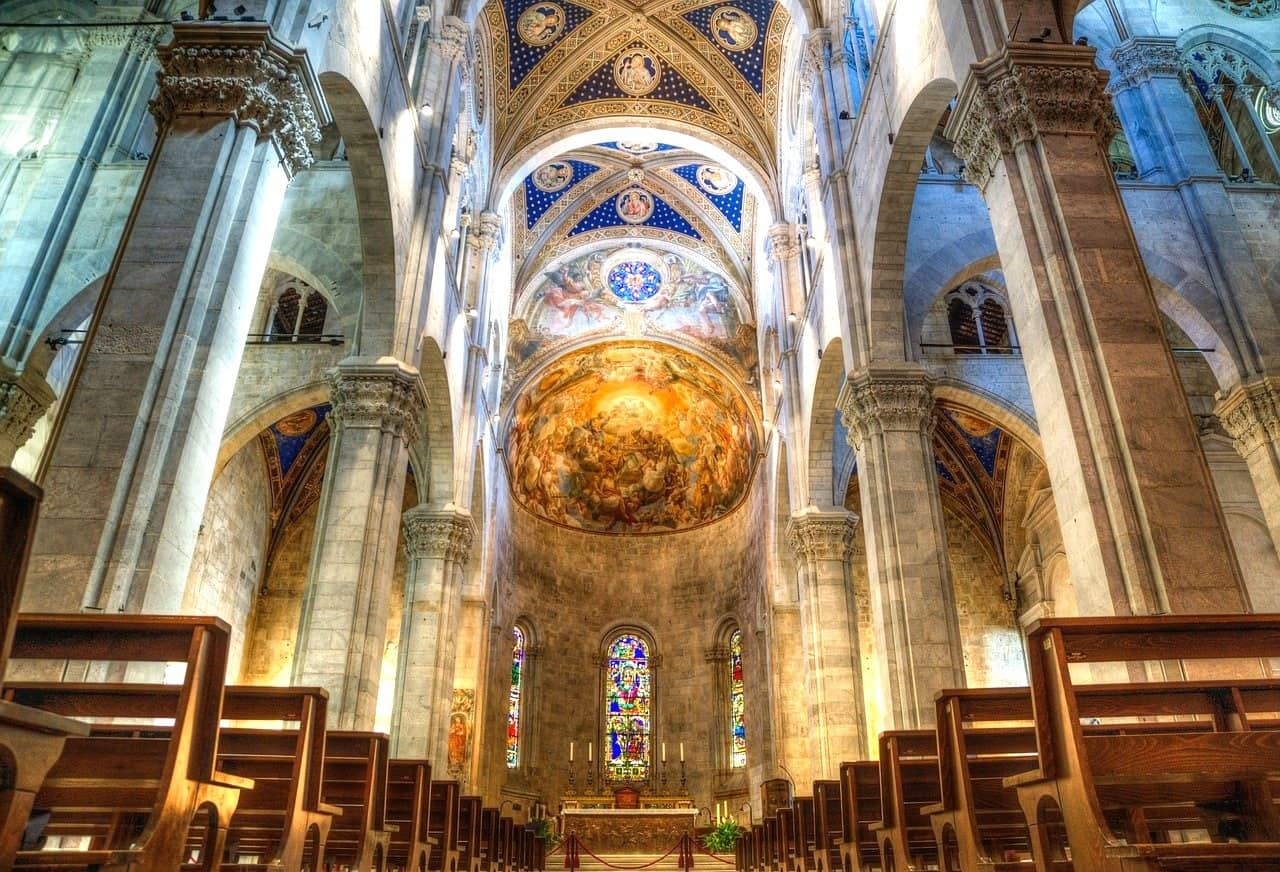
The Volto Santo (Holy Face) is a wooden relic housed in the St. Martin’s Cathedral in Lucca, one of the prettiest towns in Tuscany.
According to the legend the Holy Face was carved out of nut wood by Nicodemo after Jesus Christ’s death and resurrection to represent his real features, in fact, the details of the face, in particular, are really impressive.
The statue is said to have reached the port of Luni by a crew-less boat driven by the Divine Providence and then transported to the city of Lucca in 842.
Since then it has drawn the attention of pilgrims from all over Europe walking the medieval route from Canterbury to Rome known as the Via Francigena.
The Holy Face is still today one of the most mystic and worshipped symbols of Christianity in Italy and has contributed to creating its own alternative pilgrimage route called “Via del Volto Santo”, stretching for almost 200 km from Pontremoli in Lunigiana (historic area in Northern Tuscany) to Lucca.
Following the ancient pilgrims’ footsteps, you walk past picturesque medieval villages that seem suspended in time and across mesmerizing landscapes of the Apennine range.
Walking this route is a once-in-a-lifetime experience and an opportunity for an inner journey too.
You will find the mysterious symbol of a labyrinth both at the departing town of Pontremoli (kept inside St. Peter’s Church) and at the arrival point, where it is carved on a marble column at the entrance of St. Martyn’s Cathedral, to remind you of all the challenges you have to face in life to find your way and find yourself.
Colosseum in Rome
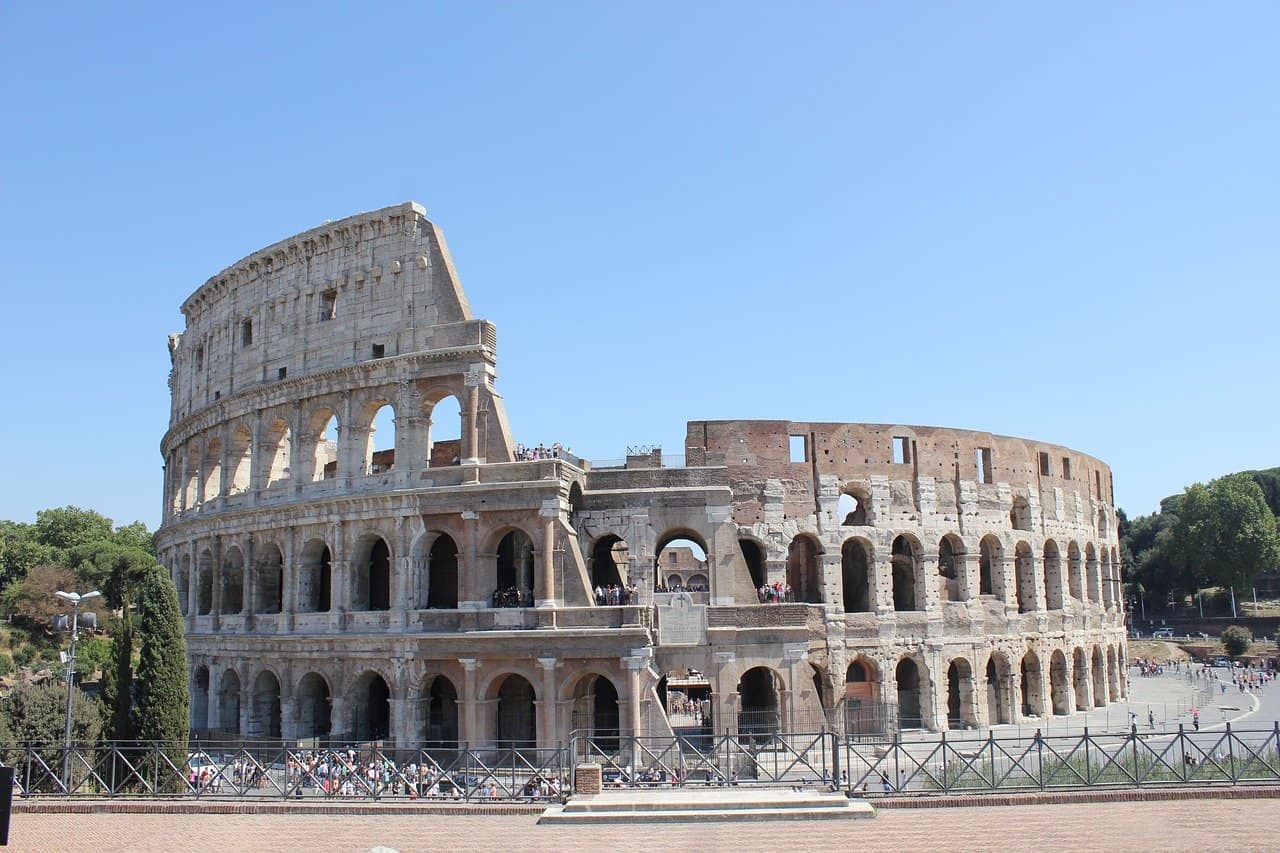
The Colosseum in Rome is an ancient amphitheater where games used to take place. Fights between animals, between humans and animals and between humans were common.
In addition to the bloody fights, there were also performances by acrobats, flute players, and other artists. The bloody games were forbidden in AD 404. by Emperor Honorius.
Today the Colosseum is one of the most famous sights in Rome and is known far beyond the country’s borders. It is a truly stately monument that belongs to the new seven wonders of the world.
What many people don’t know is that the Colosseum is also known by many as the site of the deaths of early martyrs. It is visited by many of the faith because early Christians are said to have been martyred there.
While it is not approved by all historians, Pope Benedict XIV consecrated the Colosseum in the 18th century as a sacred and holy place.
Also, popes still conduct the Stations of the Cross there every Good Friday. Although it is a pilgrimage site, you pay admission.
The regular admission price for the Colosseum is currently 12 euros. Visitors who come from an EU country and are between 18 and 25 years old pay only 7.50 € admission. You can be sure that it’s totally worth it.
Cammino di Sant’Efisio
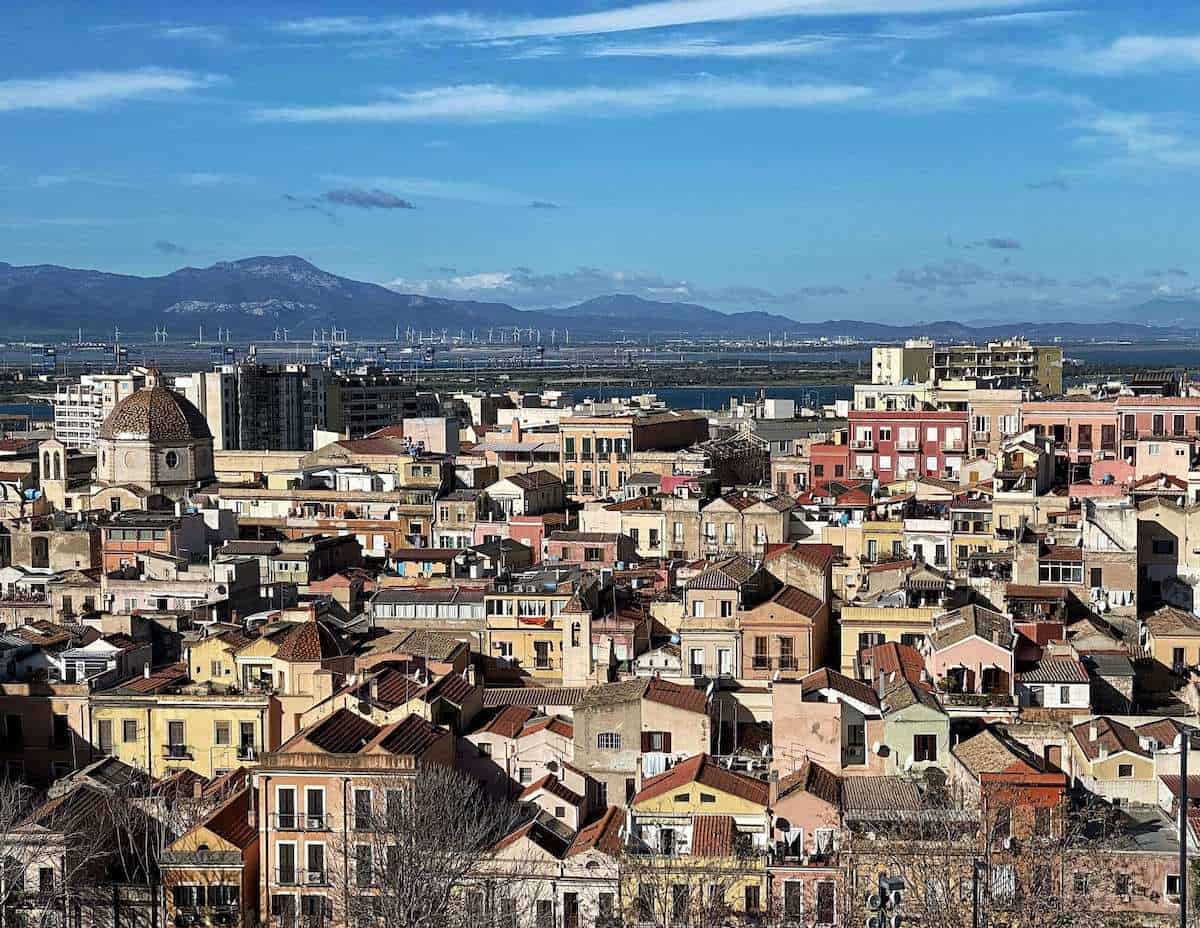
One of the most interesting pilgrimages in Italy is the Cammino di Sant’Efisio, which takes place each year between the Cagliari (the capital of Sardinia ) and a small church in Nora, at about 50 km from town. The pilgrimage was first celebrated in 1656 to honor the saint who helped defeat the plague which had affected the island for more than 10 years.
People believe in Sant’Efisio power so much that they are invoking him to help us fight the current virus. As the celebrations occur between 1 and 4 May each year, it is likely that the pilgrimage won’t occur in 2020.
The pilgrimage starts in Cagliari’s quarter of Stampace, in Sant’Efisio church. Representatives of a number of villages in Sardinia, all dressed in traditional clothes, walk down to the area of the harbor and then all the way to a small church in Nora.
The statue of the saint leaves the church at around 1:00 pm on a traditional carriage pulled by beautifully adorned bulls. Traditional music plays throughout the pilgrimage.
From Nora, the statue of Sant’Efisio is taken back to the church where it normally sits in Cagliari, where it arrives on 4 May, amidst massive celebrations.
Each year thousands of locals and tourists alike crowd the streets of Cagliari for the traditional parade.
Basilica di San Marco in Venice
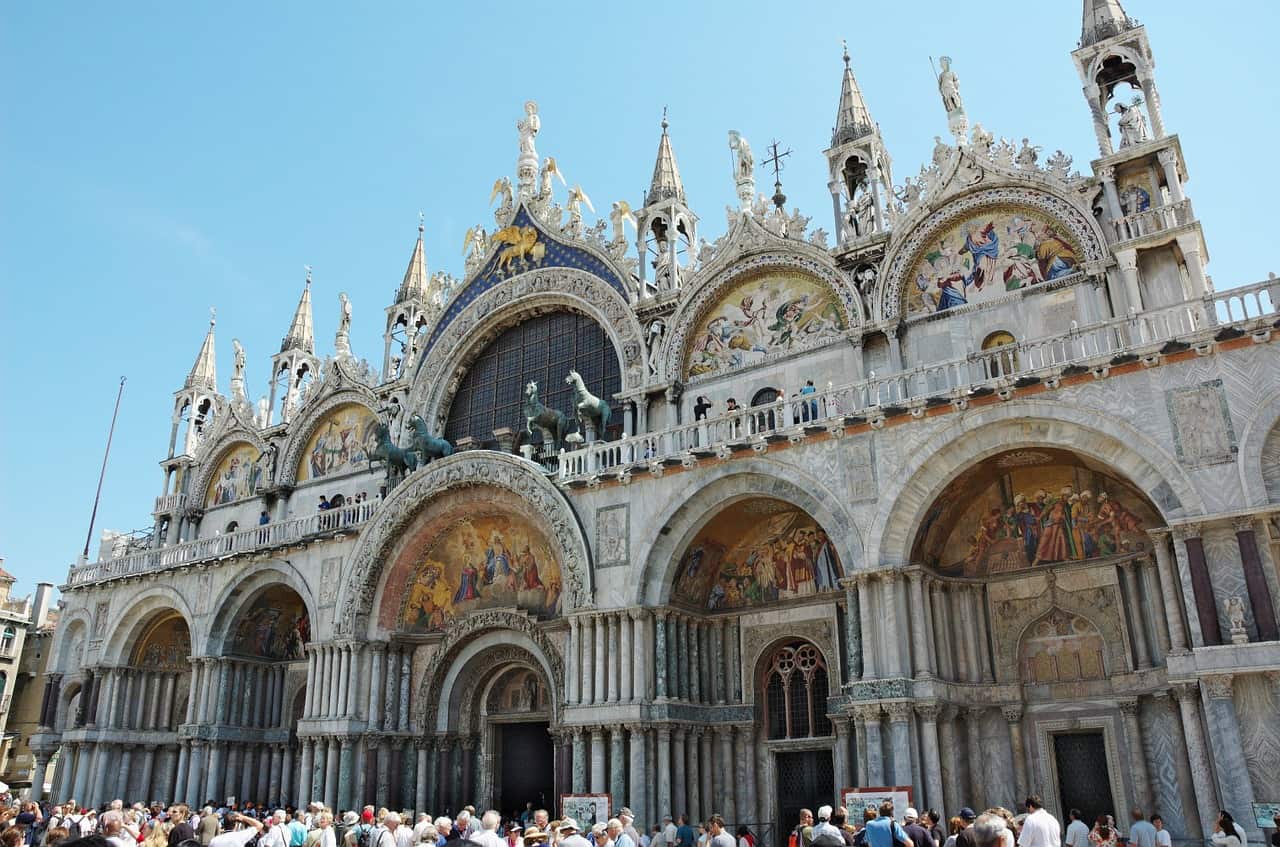
If you are looking for religious places in Italy, you cannot afford to miss Basilica di San Marco, commonly known as Saint Mark ’ s Basilica. Italy is not a cheap European country but visiting this year-old church is completely FREE. This cathedral church is one of the most famous churches in Italy located at the eastern end of the Piazza San Marco. Though Venice has a number of churches, but this old church attracts thousands of pilgrims for its gorgeous Italo-Byzantine architecture.
This historic church was built in 828 and it was connected to the Doge ’ s Palace, another popular tourist attraction in San Marco. The palace was originally built to be the private chapel of the Doge (the chief magistrate of the former Republic of Venice). At present this site is a preeminent example of Venetian-Gothic architecture and houses an art museum.
The main highlight of this church building is the golden mosaics, of which over 8000 square meters are covering the walls, ceilings and domes. Admire the beauty of its outstanding interior of gilded walls, marble floors and an enormous collection of works of art.
Before you leave this place, visit the famous Harry ’ s Bar, a truly expatriate experience and try two Italian treats that were invented here, the Bellini prosecco cocktail and the carpaccio meat dish.
Tips : Please wear an appropriate dress, and try to keep your voice down so as not to disturb worshipers. The use of photo and movie cameras is forbidden inside the church.
Lipari Island and Volcano
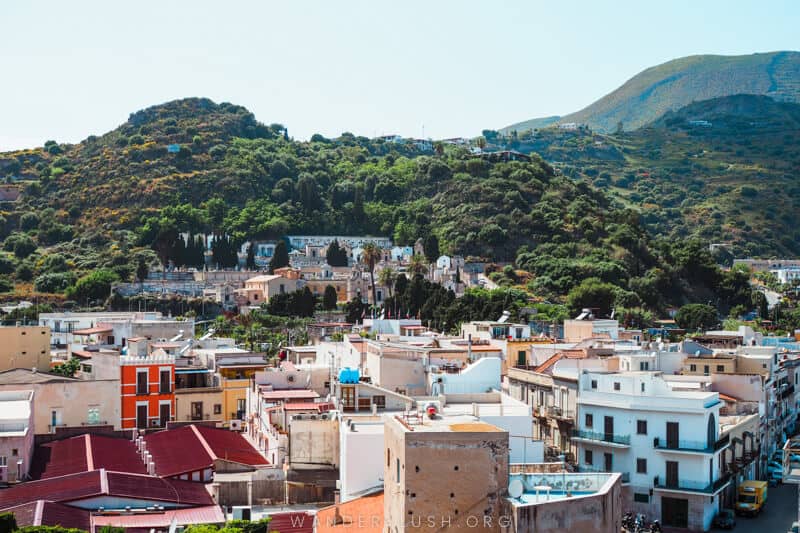
Lipari island off the coast of north-western Sicily is home to one of Italy’s more curious pilgrimage sites.
The largest of the seven volcanic islands that make up the Aeolian Archipelago , Lipari has been venerated by Catholics since the Middle Ages. In medieval times, worshippers descended on the volcano, believing that the crater was the mouth of hell. Even though the volcano is dormant and hasn’t erupted since the year 1230, it has a menacing presence and continues to be venerated.
Today, visitors who arrive on Lipari by hydrofoil from Milazzo or Messina come in search of heavenly rather than hellish landscapes. Driving or hiking around the coast reveals breathtaking scenery, including pumice stone cliffs and black-sand beaches.
Modern-day Catholic pilgrims still descend on Lipari every August to join the island’s residents for the annual Feast of St. Bartholomew.
The most important event on the Aeolian Islands’ calendar, it commemorates their patron saint, Bartholomew, one of the 12 Apostles and the founder of the Armenian Church. His relics are kept inside the Basilica Cathedral of St. Bartholomew, a 16th-century church in Lipari’s fortified Old Town.
The week-long celebrations involve fireworks, processions, markets, and concerts in the Marina Corta square.
Duomo in Naples

There are so many things to do in Naples , Italy, but at least one should always be on your itinerary if you want to understand how Neapolitans deal with religion.
The oldest part of the city is, in fact, a labyrinth of narrow “vicoli”, filled with niches with religious statues and modern wall art, usually representing San Gennaro (Saint Januarius, translated from Italian).
Neapolitans love their patron saint and visit his Duomo whenever they feel troubled or in need of help. According to the local folklore, San Gennaro has always protected Naples from Mount Vesuvius. The legends say he stopped the lava, saving the city more than once.
Inside the Duomo there’s a small ampoule where the blood of San Gennaro has been stored. Three times per year, people from all over the world plan a pilgrimage to the Naples Cathedral to see a “miracle”.
The blood, usually dry and solid, suddenly liquefies. The whole city of Naples breathes a sigh of relief when that happens: it means that San Gennaro isn’t mad and that he’ll keep on protecting the city. According to the local legends, in fact, if the blood stays solid, a horrible tragedy will befall Naples.
The Basilica of Saint Anthony of Padua
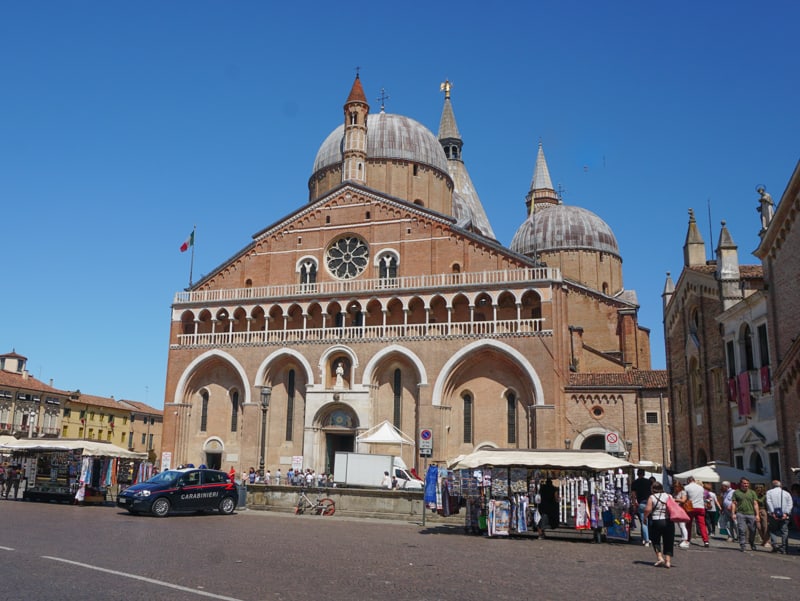
The Basilica of Saint Anthony of Padua is one of the most visited pilgrimage shrines in Italy. Saint Anthony was an important disciple of Saint Francis of Assisi, and eventually surpassed him in popularity. He is buried in the basilica.
Saint Anthony was born in Lisbon , Portugal , and joined the Franciscan Order at a young age. He helped expand the Order into France and eventually became an envoy to the Pope. He sadly died in his mid 30s while on his way to Padua, and canonized less than a year from the day he died.
One of the largest churches built in Italy during medieval times, the Basilica of Saint Anthony is a complex that includes the small church where the saint is buried. Known simply as “Il Santo,” the church is one of eight international pilgrimage sites recognized by the Holy See.
Visiting the Basilica of Saint Anthony, with its magnificent domes reminiscent of Saint Mark’s Basilica in Venice, is one of the top things to do in Padua . The brick facade is largely Romanesque, and the interior holds a number of funerary monuments. Ornate chapels feature beautiful religious art.
The relics of Saint Anthony are in the beautiful Baroque Treasury Chapel. The saint’s chin, and tongue, are on display. Each year, on June 13 , the birthday of the saint, large numbers of pilgrims visit the Basilica of Saint Anthony to pay their respects.
Pin For Later:
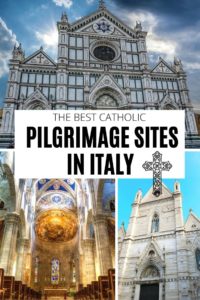
Did you enjoy reading this post about the best Italy pilgrimage sites? Share your thoughts in comments!
One Response
Great tour of places of pilgrimage. Visited many major ones. Including Frances of Assisi before the earth quake.
Leave a Reply Cancel reply
Your email address will not be published. Required fields are marked *

We are Karolina, Patryk, and Mia, the lazy traveling family. After spending 5 years as digital nomads, and living in many countries in the world, we decided to make Poland our base.
Our mission is to show you safe and interesting destinations where you can travel with your family.
Join our Facebook Group
Join the Poland Travel Support Group , a group to help you plan your trip to Poland!
Subscribe and Get Updates

- Travel Blog Cooperation
- Destinations
- Privacy Policy
- Affiliate Disclosure
- Terms of Service
- Powered By:
- www.HotelMarketingBlackBook.com -
- Hotel Marketing Agency

Meaningful and Spiritual Travel Experiences Worldwide

Pilgrimage in Italy: The Cammino San Vili in Trentino
Last Updated on: 7th August 2020, 12:04 pm
PILGRIMAGE IN ITALY: Cammino San Vili
There are a number of incredible Pilgrimage routes throughout Italy, including the Via Francigena and visiting the Shrine of St. Francis of Asissi. Lesser known, but no less meaningful and beautiful, is the Cammino San Vili or the Way of St. Vigilio that passes through the North of Italy. The Cammino San Vili is one of the best pilgrimages in Italy.
While there are so many pilgrimage routes in Europe , Italy is a top choice for pilgrimage , with so many incredible saints of the Catholic Church and other traditions originating there.
I spend a few days this June walking various parts of the San Vili Pilgrimage throughout the Trentino region in the North of Italy.
It was an amazing spiritual experience AND it was super fun! The path is absolutely gorgeous and dotted with some of the most beautiful and unique painted churches all along the way.
Here’s how you can plan your Italian pilgrimage and hike the Cammino San Vili yourself!

The Way of San Vili: An Italian Pilgrimage Route
The pilgrimage path I took in Italy goes by a few different names:
The Way of San Vigilio
The San Vili Path
and, in Italian, the Cammino San Vili.
The path follows the route of the Italian saint San Vigilio, who carried Christianity into the mountains from his home base a Bishop of Trento – the capital city of the region of Trentino. The main cathedral in Trento is dedicated to San Vigilio, and he is buried there underneath the main altar.
One of the coolest parts of the San Vili Path is that you can walk it in either direction or both – from Trento to Madonna di Campiglio or from Madonna di Campiglio to Trento. Both directions have spiritual significance: Hiking from Trento traces the path that San Vigilio took as he sought evangelize the people in the mountains, and hiking to Trento traces the path his coffin was carried after he was Martyred.
We walked from Madonna di Campiglio to Trento because that way is considered a bit easier as the gradient is downhill!

What was San Vigilio of Trentino?
San Vigilio, or properly in English Saint Vigilius, was a Roman patrician who became the Bishop of Trent in the year 380 AD.
Apparently he had two brother who also became Saints! So that’s a pretty holy family if you ask me!
At the time, a lot of people in the area were either pagan or Arian – which is a form of Christianity quite disliked in the day that didn’t believe in a trinity of Father, Son, and Holy Spirit as Nicene or more traditional, Catholic Christianity did. San Vigilio made it his mission to convert Arian Christians and Pagans in the surrounding regions.
San Vigilio had three companions with him on his mission to evangelize in the mountain. Sadly, all three were killed by the local population. Legend holds that San Vigilio forgave his friends’ killers and continued on his mission.
Of course – we know that the story doesn’t exactly end well – and, although there are different legends with slightly different details, we know San Vigilio was killed near the Redena Valley where the Sarca River flows in Trentino. Apparently he was trying to destroy a statue of the Roman god Saturn when the population turned on him.
….so you can understand perhaps how ironic it is that in Trento, Italy in front of the Cathedral of San Vigilio, there’s a giant statue of the Roman God Neptune. Oh well!

Why Walk the San Vili Path?
1. It’s absolutely, stunningly beautiful. If you’ve never been to the Dolomites in Italy they are a world of their own – the peaks of the Brenta Dolomites are sharp and jutting, often covered in snow, and surround the San Vili path. There are some truly stunning vistas along the path as well.
2. You will pass through lots of quaint Northern Italian villages.
3. There are so many beautiful, painted churches along the way that provide peaceful places to pray (and a cooling stop in the summers!)
4. There are amazing activities you can participate in along the way such as yoga and wellness activities – or visiting an outdoor sculpture museum.
5. A walking holiday is a fabulous way to both rest & recharge, while staying active. Walking is a totally different pace and is super healthy for your brain as well as your body!

When to Walk the Cammino San Vili
Despite being in the far North of Italy and in the Mountains – I was surprised how hot it was in Trentino in June!
I think May – June, or Sept-October would be perfect times to hike the San Vili Path.
These are also the “off season” for Tourists in this area since it is primarily known as an area for excellent skiing in the Dolomites! There are a lot of advantages to traveling in the off season – and a big advantage to off season travel is accommodation that is easily available and not as expensive!
This means that you can be flexible on your Pilgrimage, and you may not have to have all of your accommodation booked far in advance.
Where is the Cammino San Vili?
The Cammino San Vili is located in Trentino Italy. It’s very easy to get there from Milan or Verona by train in just a few hours. I love both Milan and Verona and definitely recommend you spend at least one day in Milan before starting you Italian pilgrimage.
I recommend starting your Italian pilgrimage in the city of Trento .
It’s easy to get to Trento from almost anywhere in Northern Italy! The nearest town with an international airport and train station is Verona. I flew into Verona directly from my adventures in Armenia the month before . The Verona airport was easy to navigate. You take a bus to the train station (you can buy tickets just outside of baggage claim in the airport) and from the train station – you can easily get to Trento in just a few hours.
If you are wondering how to take the train from Verona to Trento – it’s very easy. Beware though: There are two different types of ticket machines in Verona (and many other Italian train stations). You do NOT really need the much more expensive
You want the Trenitalia machines – the logo looks like an F with red and green around it. You do NOT want the Italo or Frecciargento.
Basically: if your ticket costs much more than 8 Euro you are at the wrong machine!
You do not have to book a ticket ahead of time! Trains run nearly every hour between Verona and Trento.
You can also try Flixbus. I used Flixbus to travel directly from Trento to Venice Marco Polo Airport (it stops in Venice proper, too) and it was very smooth and easy.

Starting your Pilgrimage in Italy
There is a LOT to do in Trento! I recommend spending at least 2-3 days there. Trento is one of those “hidden gems” that are rare now in Italy.
It’s easy to find hotels in Trento ! One of the things I most loved about this area was that it didn’t feel overtaken by tourists, and it was always easy to find accommodation or make dinner reservations anywhere I wanted! Airbnb homes are also available – I really enjoyed where we stayed , though it was a bit of a walk when the buses weren’t running.
It’s also a particularly incredible place for Spiritual and Religious Travelers. Why?
Have you heard of the Council of Trent ? This was a monumental meeting of leaders of the Catholic Church to decide how best to respond to the ongoing Protestant Reformation. A lot of Roman Catholic doctrine was decided at this meeting – and it happened right in Trento, and moreso – most of the meetings occurred inside of the Cathedral of San Vigilio!
If you walk around Trento you will see a lot of beautiful frescoes and paintings all over the buildings (it’s not called the painted city for nothing!). Many of these were commissioned as the city prepared to host the Council of Trent and are a fascinating reflection of the theology and sensibility of the time.
As you start your Pilgrimage, the most important thing to see is the Cathedral of San Vigilio itself. And you will not miss it: it rises over the main town square and is a major landmark of the city.
( Fun fact: The tower near the Cathedral isn’t actually a part of the Cathedral itself – it was a prison tower attached to the residences that now house the Museo Diocesano of Trento – the museum of religious art and history.)
The most important site in the Cathedral of San Vigilio (and perhaps the least auspicious) is the Tomb of San Vigilio himself. This is located on the lower level and requires a small entrance fee to see. You can ender behind the main altar: when you are facing it, walk left, and you will see a door. This is part of the Museo Diocesano so if you have bought a ticket there, you can enter here. Alternately – you can use your Trentino Card which is a FABULOUS card gaining you free public transportation, tons of free entrances to museums and attractions, and a whole lot more throughout the Trentino region.
You’ll find the Tomb of San Vigilio in the second room. There’s also a very cool Virtual Reality program here (look for the headsets by the next door) where you can see what the Church was like in different centuries.
Attending Mass at the Cathedral of San Vigilio in Treno is a really magical experience. As I am not Roman Catholic I sat in the back, but just to sit there and pray was a very moving experience — thinking of all that had occured within the walls of the Church, all of the people who have prayed inside and perhaps come back to praise God for prayers answered. Whatever your religious tradition, or even if you don’t identify as religious, taking some moments of silence in the Cathedral is a perfect way to start your pilgrimage.
Buy your Trentino Card ahead of your trip, or pick one up at the conveniently located Trentino Tourism office on Dante Square in Trento.

Getting to Madonna Di Campiglio in Trentino
Whichever way you decide to hike the San Vili Path, you will need to either get to Madonna Di Campiglio or from Madonna Di Campiglio back to Trento!
Good news! There’s a bus! AND – even better news – there is a lot of public transportation between all of the villages on the San Vili Trek, so you are able to hike the entire trek, or take it in pieces!
There are a number of morning buses that will take you from Trento to Madonna di Campiglio to start your pilgrimage. You can check the Trentino Trasporti website, or speak to someone in the tourism office!
Where to Stay On the San Vili Trek
Because this is an area very popular with skiers in the winter – there are no shortage of wonderful places to stay along the San Vili Path!
We stayed at three different hotels along the path – all of which I enjoyed and would recommend!
A great hotel (or “Garni”) to start your pilgrimage is the Garni La Soldanella . This is in Madonna di Campiglio and has absolutely beautiful views of the Dolomite Mountains, and a lovely green valley below. The room I stayed it had a balcony and was very spacious. This hotel also had one of the best breakfasts ever!
Once you’ve made it a little further on your pilgrimage, I enjoyed my stay in Spiazzo (see map below!) where we stayed at the Casa Marosc . It was pretty rainy and late when we got to this hotel, so I didn’t get to see what to do nearby – but I had a great dinner in their restaurant!
My favorite hotel of our trip was the Garni Lilly in what I think must be one of the cutest towns in all of Italy: San Lorenzo. This hotel is a little way off from the San Vili Trek itself, but I still highly recommend it as a stop on your pilgrimage for the views & the gorgeous town around it. Garni Lilly also offers packed lunches for your pilgrimage and hiking day! They had a great breakfast, too!

How to Hike the Cammino San Vili
In many ways – this part is up to you. Fast or slow. Through-hiking, or hiking pieces of the trail. I don’t personally believe there’s a right or wrong way to make a pilgrimage. Whatever works for you and is spiritually significant for you is the right choice!
I enjoyed hiking the San Vili Path in pieces – and I can also see what a challenge and accomplishment it would be to hike the entire path. I walked with a group, which was great fun and wonderful fellowship, but I can also imagine it might have been easier to pray and meditate on the walk were I walking alone or with just one or two others.
There are only two main things to remember:
- The signs marking the San Vili Trail are Red and White! They should look like variations of the below:

2. There are boxes along the way where you can stamp your journal or personal “passport” along the way. Or your hand, if you are me! You can also leave notes for others in many of these stops!
Along the way you will also notice that many sections of the trail have little stands or building with the Stations of the Cross – these memorialize the last moments before Jesus was crucified. I found these absolutely beautiful – and there were also a number of picturesque churches and chapels along the way.
Below is a map with details of how to hike the trail and each town you will pass through if you hike the full trail or give you an idea of sections you might like to walk!
Must-See Churches Along the San Vili Way

For me, the highlight of walking the San Vili Pathway was the many beautiful, painted churches along or not far from the trail. I can never get enough of Painted churches, like the Cathedral of St. John the Baptist in Savannah where my Mom grew up.
In the 15th and 16th centuries in Trentino a family of painters from Bergamo, the Baschenis family, painted many churches in the area. Their paintings are not necessarily the most complex from a standpoint of design and perspective – but they are hugely colorful, which I just adored. As you go from church to church on the San Vili Trek, you will start to see paintings that look similar to each other – those are the Bachenis family paintings!
There were so many churches we stopped at on the way. In many of them I took a moment to say a prayer and light a candle – something I love doing in churches when traveling, connecting the prayers of others to my own.
My three favorite churches were all painted in some way by the Bascenis family.
The Chiesa S. Vigilio (sound familiar?) near Pinzolo has an amazing example of the rather macabre but certainly affecting “Dance of Death” by the Baschenis on its outward facade. This motif, painted on many churches in the area, is a reminder that even the rich and powerful are headed for the grave and only Jesus can save.
San Stefano is a very famous church just off of the San Vili path – but it is well worth the extra walking! The interior of the church is an explosion of color and frescoes. Sadly, this is no longer a working church. When I visited there was a beautiful art installation of Venetian glass that re-made one of the famous frescoes inside – that of the last supper.
The last church I visited was in the town of San Lorenzo itself. The San Roco church was built in the 15th century and has one of the best church interiors I’ve ever seen. It’s small but packs a punch in terms of paintings – with an amazing Christ on the Throne as well as a fresco of the crucifixion.

Tips for Hiking the Cammino San Vili
- The weather in this part of Italy can change quite quickly. Do make sure to carry rain gear with you – even if it looks clear outside when you set out!
- Do wear sturdy shoes. I also recommend a hiking pole.
- Some of the most beautiful parts of the trail we walked were also quite high and there were cliff edges. Consider this if you have a significant fear of heights. I thought the views were worth it – but it’s a consideration.
- Don’t miss out on trying some local Trentino wine. The best wine in Trentino is Trentodoc – a lightly sparkling wine, with a lot of minerality from the mountains, that I drank, and drank, and drank….oops, I shouldn’t admit that. But it was so good!
- Do speak with your Garni or Many hotels offer amenities like packed lunches and will certainly be able to offer you advice on the trek itself as well as what to do in the region! I found the people of Trentino very friendly and helpful!
- If you are traveling with kids, these trails are – for the most part – not at all stroller friendly. The trail is baby-wearing friendly! This sign made my baby-wearing foster-mama heart chuckle:

Are you ready to plan your Pilgrimage in Italy along the Cammino San Vili?
I loved my first pilgrimage and cannot wait for another walking holiday or spiritual pilgrimage! Italy is truly the perfect place for a pilgrimage – with incredible routes in Trentino, as well as around Rome and in the South. And it didn’t hurt that I got to end each day of walking with delicious homemade pasta and Trentodoc wine! The churches in this area of unique, colorful, and peaceful. The nature is pristine. The views of the mountains are unspeakable. Trento turned out to be one of my favorite cities ever not just in Italy! What’s not to love?!

[ I was hosted for this Pilgrimage by the tourism boards of Visit Trentino & Visit Comano, through the wonderful Traverse Events. As always, all opinions are my own.]
Follow Sacred Wanderings on Social Media!

Why Visit Armenia: Why I Went & You Should Too

The Best Hotel in Armenia: A Review of the Silk Road Hotel, Yerevan
You may also like.

The 14 Most Beautiful Churches in Paris You Must Visit

Top 23 Must-See Churches in Armenia and Monasteries in Armenia

Pilgrimage sites in Mexico: The Best Cathedrals, Shrines, and Temples You Must See
21 comments, kristi @ way beyond the norm.
Awesome post! Looks like a great pilgrimage. I’d love to see all of those beautiful churches.
I loved this. I’ve always wanted to hike the dolomites….and you made it better by throwing some wine time in with it. I’ve pinned for when I plan this trip.
Cate Michelle
The churches really are stunning – and unique! I’ve never seen anything like them!
Thank you for sharing this. We’ve always loved trekking holidays and wanted to do more, particularly in Europe. It’s nice to hear about one with the meaning and significance behind it too.
It’s a really lovely trek – and there are so many amenities and things to do along the way! Plus Italian food is just the best, isn’t it!?
I’ve never even heard of this trail! It does look absolutely beautiful the whole way. I gotta get in better shape to do a trekking holiday!
I hadn’t heard of it, too! But I am so grateful I got to walk it & really think it must be one of the best Treks in Europe!
Sabrina Williams
Curious about this pilgrimage is there an established map for the trail.
There is! You can get information in any of the Tourism Offices in Trentino! There are also clearly marked signs along the trail showing you are on the Way of San Vili!
Thank you for creating this post. This looks like a really great tour. The details and photos bring Trentino to life on the page. I will need to get my walking boots dusted off!
Trentino is an amazing region! I really think more people should prioritize it! So glad you enjoyed 🙂
This looks like an amazing journey! My catechism teacher always talked about pilgrimages and I never quite understood what it was. Saving in my Pinterest bucket list.
This looks amazing. I really enjoyed reading this post and seeing all the stunning photos. Many of the little cottages remind be of being in Switzerland. I love your niche with your blog too. Very creative 🙂
Menchit Ordoveza
May I ask how many days should I alot for doing this trail?
Hi Menchit! I would recommend 6-7 days to walk the full trail (one way). And a full 2 weeks to walk both ways, if not a little more!
I remember visiting the Cathedral of Saint Vigilio when I was in Trento last year. Such a beautiful cathedral. I wish I had taken more time to explore the rest of the area and seen more churches.
Hi I love this blog and all the info you share! I am visiting the area and would love your opinion as to doing this trail alone? Im nervous about that but also excited! Thank you for how you make this so easy to understand!
Want to see and learn more!
Angie Osborne
This sounds like a beauitful pilgrimage. I’m so excited to experience the trek in April 2024. Thank you for sharing this. Angie
Leave a Reply Cancel reply
Your email address will not be published. Required fields are marked *
Pin It on Pinterest
The Most Popular Catholic Pilgrimage Sites In Italy

Italy has a long history of being at the very center of Catholicism and is home to many of the most awe-inspiring Christian sites in the world. Every Italian town and city has its own churches and cathedrals, as well as museums, local shrines and other Catholic sites of importance. This means that no matter where you go in Italy you’ll never be far from a local Catholic site of interest.
But if you truly want to understand the incredible heritage that Catholicism has bestowed on global culture, there are certain sites in Italy that you simply must see. To get started in your explorations of Italy’s premier Catholic sites, we’ve compiled some of the very finest examples to help you plan your trip.
As a general rule, you should always wear modest clothing when visiting any Catholic site in Italy. Women should wear clothes that cover their shoulders and knees while men should wear long sleeves and trousers. You should also wear smart footwear – so avoid wearing flip-flops or excessively high-heels and stick to a pair of leather shoes or sandals instead.
While a strict dress code is not universally enforced, it is polite and shows respect to dress modestly when you visit any Catholic site. With that said, in some locations, such as the Vatican, the dress code is quite strictly enforced and you may be turned away if you are dressed inappropriately.
The Vatican City.
Technically the Vatican City is a country of its own and not part of Italy. Practically speaking, it is a small neighborhood of Rome, which is the capital of Italy. The Vatican City is the center of the Roman Catholic religious community and is the official residence of the Pope, the spiritual leader of the Catholic faith. As the spiritual heart of Catholicism, few places in the Christian world are as popular to visit as the Vatican City in Rome.
Catholicism has played a central role in Italy for centuries, but very few people realize that the Vatican City was only established in its current form, as an independent sovereign city-state, in 1929 following the signing of the Lateran Pacts. Even so, the main buildings that make up the Vatican are much older, including the Sistine Chapel which was built in the 1470s under the instruction of Pope Sixtus IV and St Peter’s Basilica which was built between 1506 and 1615.
Indeed, no trip to Rome would be complete without visiting the Vatican. The spectacular artwork on the ceiling of the Sistine Chapel will leave you absolutely awestruck while the Vatican museums house many of Christondom’s most valuable works of art, sculptures and Christian relics. Saint Peter’s Basilica is one of the world’s largest churches and has more than 390 sculptures, 44 altars, 135 mosaics and almost 800 pillars!
It’s free for visitors to enter Saint Peter’s Basilica although if you don’t arrive early the lines can be quite long. If you’d like to learn all about the history and significance of the basilica and the artworks on display, you can join a guided walking tour of Saint Peter’s Basilica, the Sistine Chapel and the Vatican Museums.
The Basilica Di Santa Croce, Florence.
Located in the historic center of Florence, the Basilica di Santo Croce is a Franciscan neo-Gothic church that was designed by Arnolfo di Cambio and built between 1294 and 1385. The beautifully elegant church has a distinctive white marble façade and is the burial place of Michelangelo, Machiavelli and Rossini, among other famous Italians.
The Basilica di Santa Croce is one of the biggest Franciscan churches in the world and is made up of 16 chapels and 3 cloisters, including one designed by Brunelleschi and others that are decorated with stunning frescoes by the master artist Giotto. In the Saint John the Baptist and John the Evangelist Chapel Giotto also painted magnificent scenes from the life of Saint Francis, the founder of the Franciscan church. It also includes a lovely gilded altarpiece, many Renaissance paintings and heavenly stained glass windows.
When you visit the Basilica di Santa Croce you buy a ticket in advance and skip the line to enter, or join a private guided tour to really immerse yourself in the history and art of this remarkable Catholic site. Your ticket to the basilica includes access to the cloisters, the baptistery, the crypt and the nearby Museo dell’Opera.
The Cathedral Duomo Di San Vigilio, Trento.
Dedicated to Saint Vigilio, the basilica, also known as Trento Cathedral, is a beautiful example of Romanesque architecture at its very finest and is a significant site of Catholic pilgrimage. Saint Vigilio was born in the 4th Century and is credited with bringing Christianity to the Northern Italian regions. Sadly, he was martyred for his faith and this picturesque basilica stands as a testament to his religious devotion and life’s work in bringing Christianity to new communities.
The Cathedral Duomo di San Vigilio is a part of the traditional pilgrimage routes and is connected to the Cammino San Vili which follows many of the routes that San Vigilio himself walked as he spread Christianity in Northern Italy. Surrounded by the spectacular scenery of the Dolomites, the Cathedral Duomo di San Vigilio is one of Italy’s most popular sites of pilgrimage and remains an important site for Catholics.
The Cathedral Of Saint Martin, Lucca.
The Holy Face of Lucca, known locally as the ‘Volto Santo’, is one of the most unique relics in Christendom. The Holy Face is a wooden carving that was created by Nicodemo, who helped Joseph of Arimathea to place Jesus in the tomb after his crucifixion. The remarkable carving is said to accurately represent the actual features of Christ himself. This allows visitors to see a true representation of the face of the Savior and marvel at the excellent craftsmanship of the impressive carving.
The Holy Face is housed in a marble chapel that was erected in 1484 by Matteo Civitali to keep the sculpture safe within the Cathedral of Saint Martin complex. This sacred relic is one of the most unusual Italian Catholic sites and is a fascinating place to see. The town of Lucca is also a beautiful Renaissance town in Tuscany that is well known for its cobblestone streets and the Renaissance walls that encircle the city’s historic center. If you’d like to explore the town of Lucca and visit the Cathedral of Saint Martin with a local expert, you can join a guided walking tour.
The Holy Face has been a popular site of Catholic pilgrimage since it arrived in Lucca in the 9th Century. In fact, as one of the most mystical relics in Christendom, pilgrims have walked from as far away as Canterbury in England to visit the Holy Face for hundreds of years. The town of Lucca is also located on the Via del Volto Santo, a 200 km pilgrimage route that leads to Pontremoli in Lunigiana and takes you through some of the most iconic scenery in the province.
Saint Francis Basilica, Assisi.
Saint Francis founded the Franciscan domination of Catholicism and is famous for rejecting the trappings of his wealthy merchant family and living an austere life in the woods to better dedicate himself to the church. The enormous Saint Francis Basilica attracts millions of tourists and pilgrims each year and is considered by many to be one of the most important spiritual centers in Europe.
Built in the 13th Century, it’s the oldest Gothic Basilica in Italy and contains two churches, known as the Upper and Lower Basilicas. The Lower Basilica is designed in a Romanesque style while the Upper Basilica is an excellent example of the Gothic architecture that swept Europe in the coming centuries. The basilica is filled with amazing frescoes, important relics and has astounding views across the valleys below.
There are numerous small towns and villages in the surrounding countryside where you can stay amongst the rural idyll of Tuscany. If you’d like to learn all about the history of the UNESCO-listed Saint Francis Basilica you can join a guided tour.
The Turin Shroud, Turin.
As one of Christianity’s best-known relics, the Turin Shroud is a remarkable piece of cloth that was placed over the face of Jesus in the tomb. By a miracle, the shroud was left with an exact imprint of the face of Jesus and is still one of the most venerated and mysterious relics in Catholicism. In fact, for centuries, pilgrims have traveled from all over the globe to visit the Turin Shroud which is housed in the Chapel of the Holy Shroud in the Cathedral of Saint John the Baptist in the city of Turin.
The original shroud is not always displayed to the public anymore but a perfect copy is exhibited above the altar in the chapel. However, pilgrims and tourists are able to stay close to where the true Holy Shroud of Turin is kept and on certain occasions during the year the real shroud is brought out for public viewings. While you are visiting the Turin Shroud, you can also stop off at the Museum of the Shroud which is located about 10 minutes walk from the cathedral.
Lipari Island, Sicily.
Lipari island is situated off the Northwestern coast of Sicily and boasts one of Italy’s strangest sites of Catholic pilgrimage. Lipari island is home to a large volcano that has been venerated since Medieval times by Catholics because it was believed that the volcano’s crater was the actual mouth of hell. Despite the fact that the volcano hasn’t erupted for almost 800 years, it still attracts Catholic pilgrims to celebrate the Feast of Saint Bartholomew in August each year.
In modern times it’s easy to reach Lipari, by hydrofoil from Messina or Milazzo to enjoy the beautiful landscapes, have lunch at a local restaurant and take part in the festivities of the Feast of Saint Bartholomew if you visit in August. While you’re on Lipari island you can also visit the 16th Century Cathedral of Saint Bartholomew where relics related to his life are exhibited.
The Route Of Seven Churches.
This 16-mile pilgrimage is one of Italy’s most popular Catholic experiences and involves visiting the seven major pilgrim basilicas of the Eternal City. The pilgrimage is originally connected to the medieval custom of visiting the tombs of Saint Peter and Paul as well as the seven jubilee basilicas of Rome.
During the walk, pilgrims and tourists visit the churches of San Pietro, San Paolo Fuori le Mura, San Sebastiano, San Giovanni in Laterano, Santa Croce in Gerusalemme, San Lorenzo Fuori le Mura and Santa Maria Maggiore. For anyone who wants to experience a relatively short pilgrimage while visiting some of the most significant Catholic basilicas in the world, the Route of Seven Churches begins on Maundy Thursday each year.
The event usually takes 2 days to complete and incorporates time for prayer and free time to relax along the way. This means that anyone who is reasonably fit can complete the route alongside pilgrims, tourists and religious figures from the Catholic church.
Italy Has A Spectacular Catholic Heritage.
Any visitor to Italy will instantly notice that Italy’s Catholic heritage is deeply entwined into the life of every town and city. What’s more, according to Church statistics, around 95% of Italians are baptized as Catholics making Italy one of the most Catholic nations in the world.
But despite the near ubiquity of Catholicism in Italy, the Italians are extremely open-minded, welcoming and friendly, and do not discriminate against other religious groups. So nobody should feel out of place while exploring the fascinating Catholic heritage of Italy, even if you are not a Catholic or practice a different faith.
The Most Popular Beaches Of Sardinia

The Best Lesser-Known Attractions In Palermo

The Best Arab-Norman Monuments In Palermo

The Best Tours And Guided Activities In Palermo Italy

The Best Coworking Spaces In Milan For Digital Nomads

The Best Coworking Spaces In Rome For Digital Nomads


The Most Popular Italian Towns Along The Adriatic Coast

The Most Popular Towns In Lombardy Italy

Mistakes Indians Make When Traveling To Italy
Please comment cancel reply.
Weekly Newsletter From Italy With Love
From Italy With Love
Subscribe to our weekly newsletter.
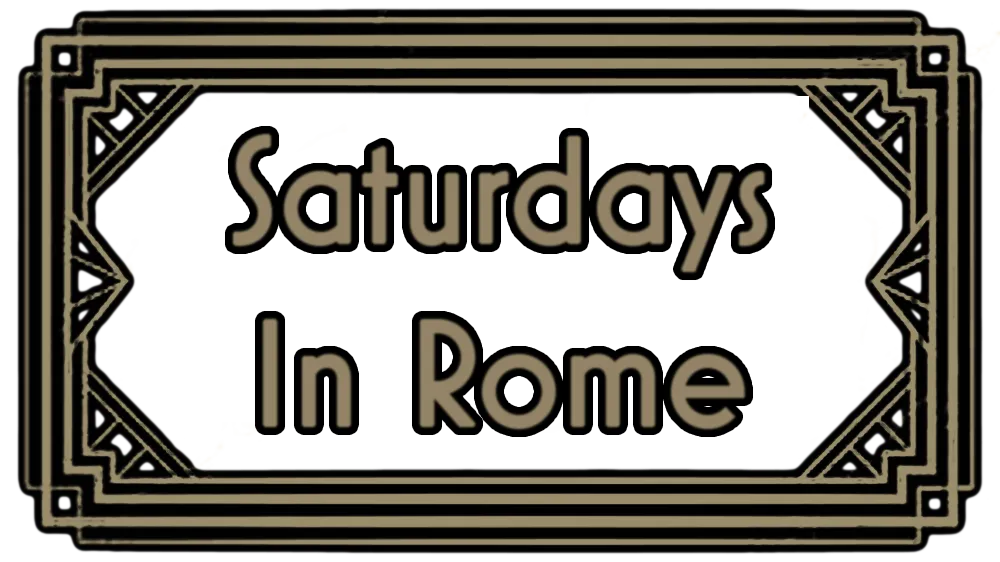
9 Amazing Religious Sites In Rome For Everyone To See
There is no shortage of religious sites in Rome, which is obvious considering its history, but if you aren’t sure where to begin, this should be your guide.
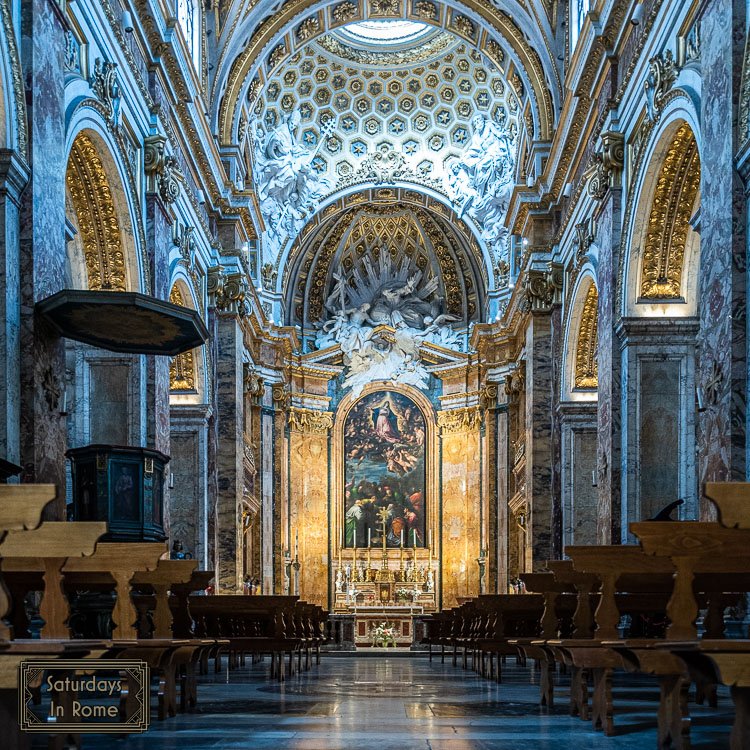
The staggering number of religious sites in Rome is deeply rooted in its historical and cultural evolution. The city served as the epicenter of the ancient Roman Empire, where the collection and acceptance of diverse belief systems was a hallmark. With the advent of Christianity, Rome emerged as a focal point for the burgeoning faith, hosting religiously significant events in its early history.
The layers of religious history, from ancient pagan temples in the Roman Forum to Renaissance masterpieces, create an amazing mosaic of faiths that continues to draw visitors and pilgrims alike. Rome’s religious sites are not just architectural marvels but living monuments to the city’s enduring spiritual legacy.
What Is The Most Religious Site In Rome?
I would find it hard to believe that anyone would disagree with me that the more religious site in Rome is Vatican City . It is the seat of the Catholic Church and Vatican City, which is an independent country within the city of Rome, is central to Catholics around the world.
9 Amazing Religious Sites In Rome
My list of 9 of my favorite religious sites in Rome is just that, my opinion. They aren’t all religiously significant, like the Vatican, but some are and others are places I visited that I found interesting and unique to my experiences. Also, while I have no doubt there are sites in Rome that are significant to other faiths, like the Great Synagogue of Rome’s Jewish Quarter , which I found historically important, my tastes in architecture and history are a little bit different. When you visit Rome, consider adding these religious sites to your list of sites to visit.
The Vatican And St. Peter’s Basilica
The Vatican And St. Peter’s Basilica are the smallest independent and sovereign country and the largest church in the world that you need to see. The Vatican City State is an ecclesiastical monarchy ruled by the Pope, who is the bishop of Rome and head of the Catholic Church. The beauty and importance can not be overstated, which is why it is first on my list.
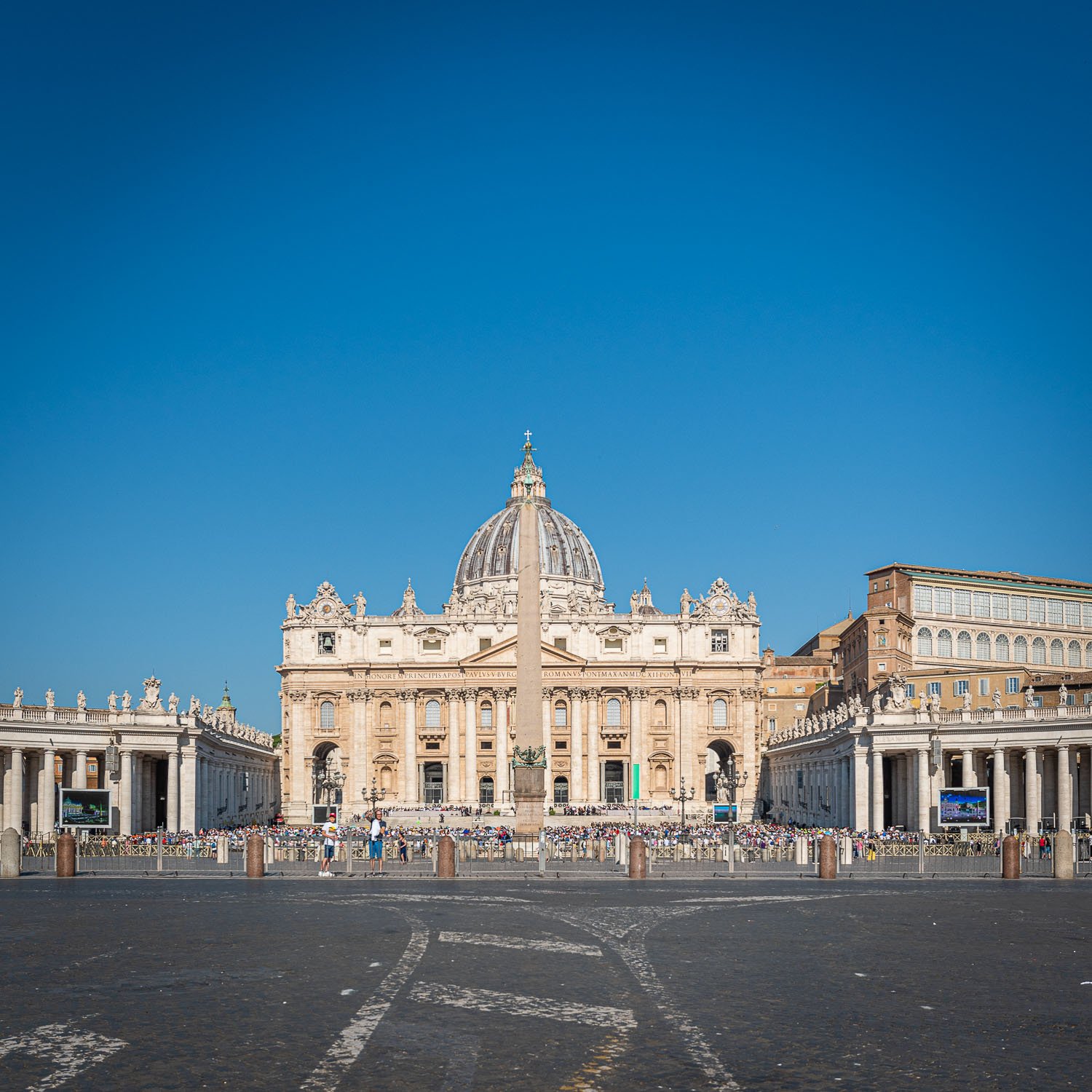
St. Peter’s Basilica
In addition, St. Peter’s Basilica is one of the 7 Pilgrim Churches of Rome and I would say it is the most important. The tradition of visiting all seven churches was started back in the 16th century in order to combine conviviality and the sharing of a common religious experience through the discovery of the history of the early Saints. Other pilgrim churches are on the list as well.
The Basilica of St. John Lateran
The Basilica of Saint John in Lateran, which is part of the Diocese of Rome, serves as the seat of the bishop of Rome, also known as The Pope. The San Giovanni church is outside of Vatican City, however, as properties of the Vatican, the church and its offices have a unique status from Italy, pursuant to the terms of the Lateran Treaty of 1929 . It is also one of the 7 Pilgrim Churches of Rome.
In addition to the beauty and being the home of the Bishop of Rome (a.k.a. The Pope), this 1700 year old church also provides more current value to the community as the home of the annual Workers’ Day (or May Day or Labor Day) concert and celebration held on its front lawn every year. The concert is organized by the Italian trade unions, so it is also used as a platform to promote workers’ rights.
The Basilica of St. Lawrence Outside The Walls
The Basilica of Saint Lawrence Outside The Walls is one of Rome’s minor papal basilicas, as well as being one of the 7 Pilgrim Churches of Rome. It is next to one of Rome’s largest and historic Verano Cemetery ( Cimitero del Verano ) and is a shrine to its namesake, San Lorenzo.
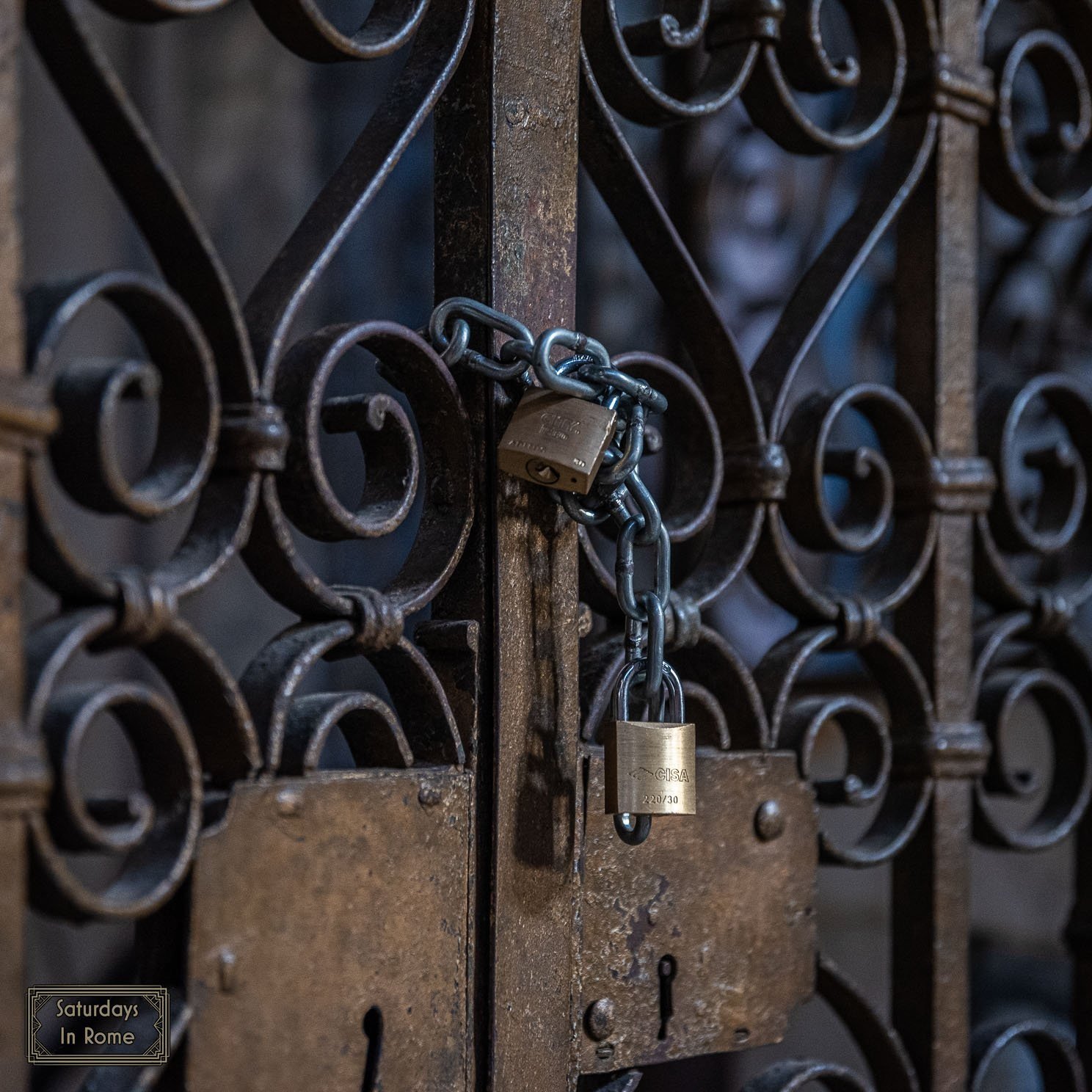
St. Lawrence Basilica
One interesting story about this basilica is why St. Lawrence is the Patron Saint of Chefs and Comedians. St. Lawrence was strapped to the top of an iron grill over a slow fire that roasted him alive. The legend is that God gave him so much strength that Saint Lawrence was able to joke with his captors while he died.
Climbing The Scala Sancta
The Holy Stairs ( Scala Santa in Italian and Scala Sancta in Latin) are a major part of the Pilgrims Trail and they are right across the street from the Basilica of Saint John in Lateran . These are believed to be the 28 steps that make up the staircase are exactly the same ones that Jesus climbed several times on the day of his death sentence in the palace of Pontius Pilate. Hence the name of Scala Pilati or Scala Sancta.
Inside The Pantheon
Inside the Pantheon is one of the most beautiful and well preserved ancient sites in Rome and it took three tries to build it in the Piazza della Rotonda. The first version of the Pantheon, which was started in 27 BC and completed in 17 BC, burned to ground. The exact form of the Pantheon is debated because of the destruction of everything except for the façade. It was rebuilt under Emperor Domitian in 80 AD, but it burned down a second time in 110 AD. The third version of this temple was built in 127 AD under the reign of Hadrian. The structure of the building was wood, which is why it was able to burn down repeatedly.
Three Generations Of San Clemente In Rome
The Basilica of Saint Clement near the Colosseum is worth experiencing because of the three levels of the complex that contains the cathedral. The top level is the Roman basilica of San Clemente and it was built in the year 1100 AD. The next level down, on which the basilica was built, is a 4th century basilica built in a home that had previously been a church as well. This had been built on top of a villa from the times of the Roman Republic that had been destroyed during the Great Fire of Rome that occurred in 64 AD.
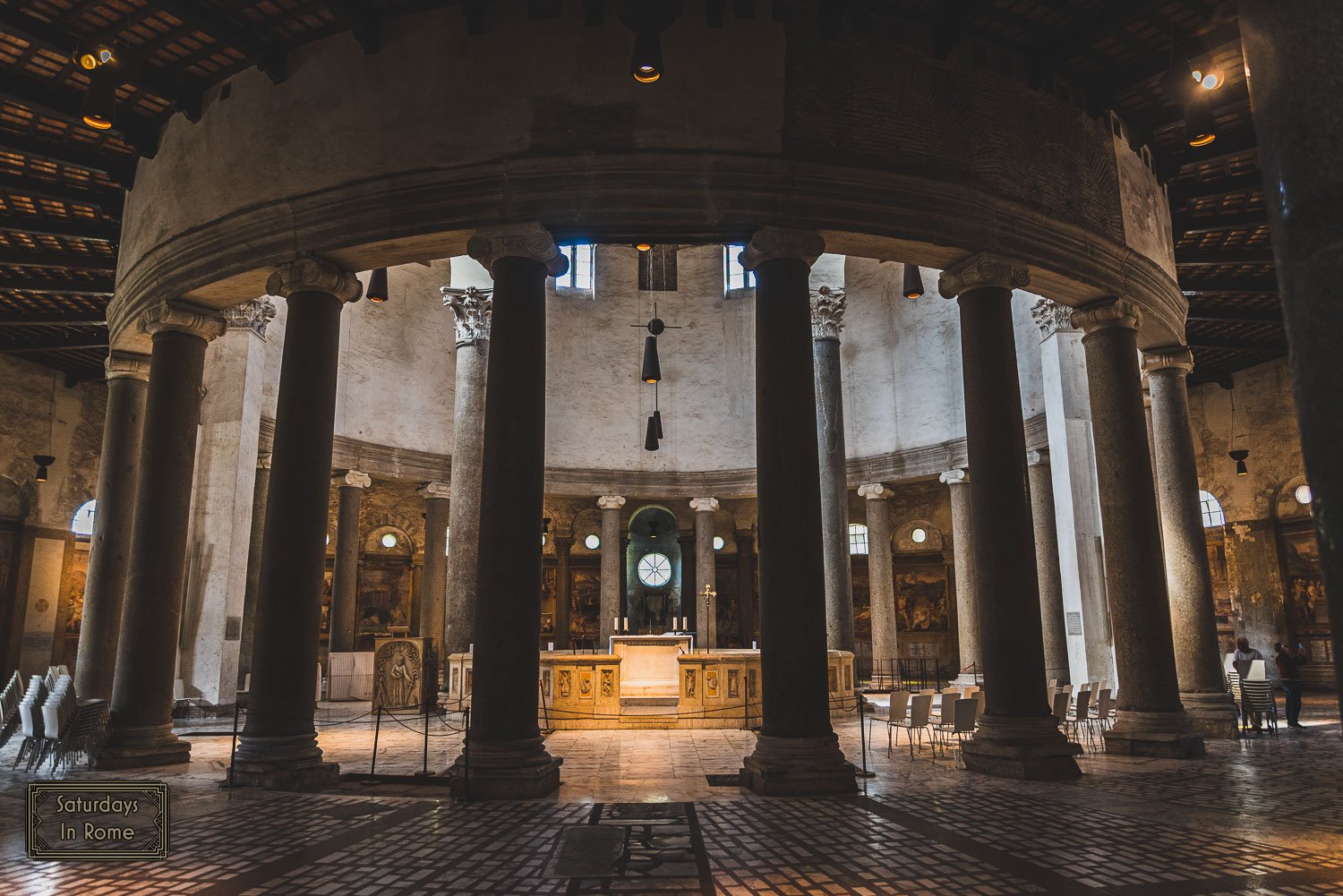
The Round Church
The Unique Experience Of San Stefano Rotondo
The Basilica of Santo Stefano Rotondo is a Catholic basilica in the Celio district of Rome, Italy. It was built in the 5th century, it has changed names over the centuries and since its construction it has been the headquarters of the namesake Cardinal. It is unique because of the circular plan that consisted of three concentric circles. This round church also has some amazing frescoes that are also worth a visit.
Caravaggio Paintings In Rome At Waiting For You At Church
The most famous Caravaggio artwork can be found in Rome and this French church offers an amazing experience at no cost for the budget traveler. My favorite of his works on display in Rome is the cycle of Saint Matthew in the Church of San Luigi dei Francesi . These three paintings, which I believe are considered to be a triptych, are tucked away in the corner chapel of the church and definitely worth visiting. Best of all, admission to the church is free, and if you don’t want to spend €2 to turn on the lights for viewing, just wait a few minutes and someone will do it for you.
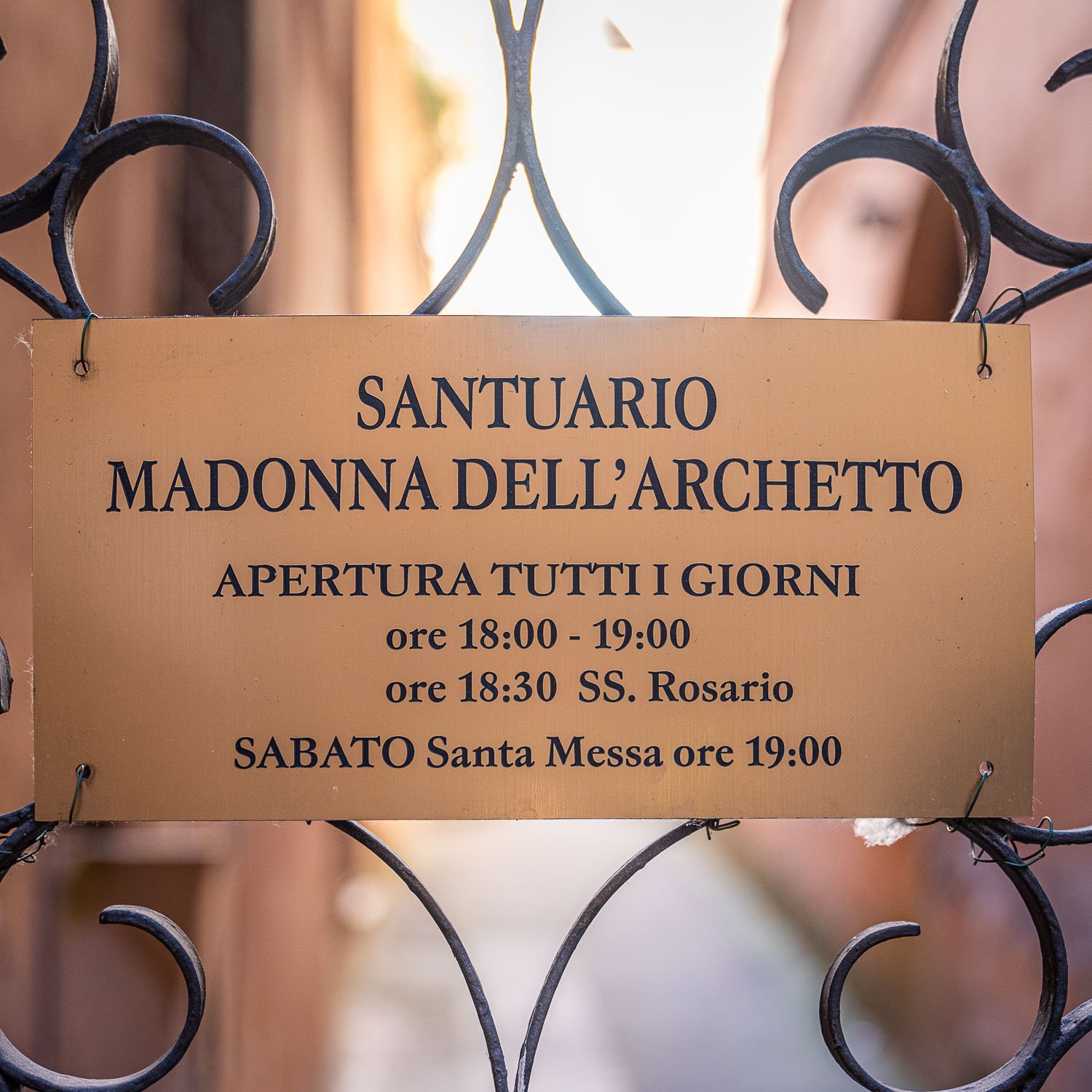
Small Church
The Beauty Of A Small Church In Rome Must Be Experienced
The Madonna dell’Archetto is the smallest church in Rome and was built in the 19th century and is an amazing contrast to the grand basilicas all around the city. The small church is in the Trevi district and near Piazza Venezia ( Via di San Marcello 41b ). The official name of the church is “The Church of Santa Maria Causa Nostrae Laetitiae”. For those of us that don’t know Latin, Causa Nostrae Laetitiae means: “ The Cause of our Joy ”.
Other Religious Sites In Rome, and Beyond
I have only highlighted my favorite religious sites in Rome, but there is so much more. If you enjoyed this selection, here are a list of other sites in Rome and beyond that you might also find interesting:
- The Papal Basilica of St. Mary Major .
- The Basilica of The Holy Cross in Jerusalem .
- The Sanctuary of the Madonna of the Divine Love .
- The Basilica of St. Paul Outside the Walls .
- Bari, Italy: What To Do If You Only Have A Weekend To Visit.
- The Monumental Cemetery of Verano Is Another Hidden Gem In Rome.
- The Palatine Hill In Rome , Italy: This Is Your Guide.
- The Madonna di Loreto (Caravaggio) Doesn’t Travel At All.
Similar Posts
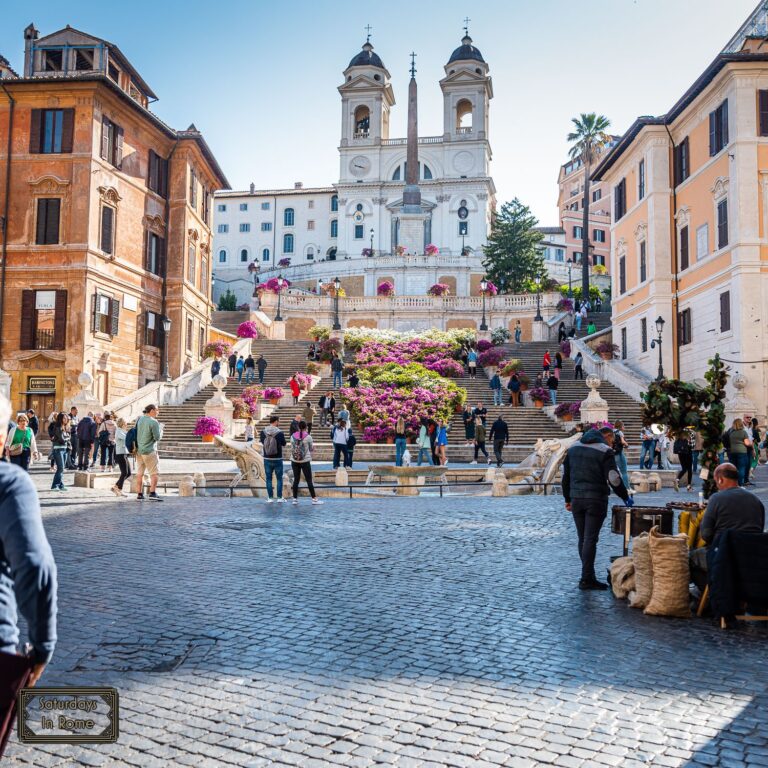
Piazza di Spagna, Rome and the Spanish Steps Are Beautiful!
Piazza di Spagna, Rome and the Spanish Steps are a beautiful spot to enjoy any time of the year, but especially in the spring you really shouldn’t miss them.
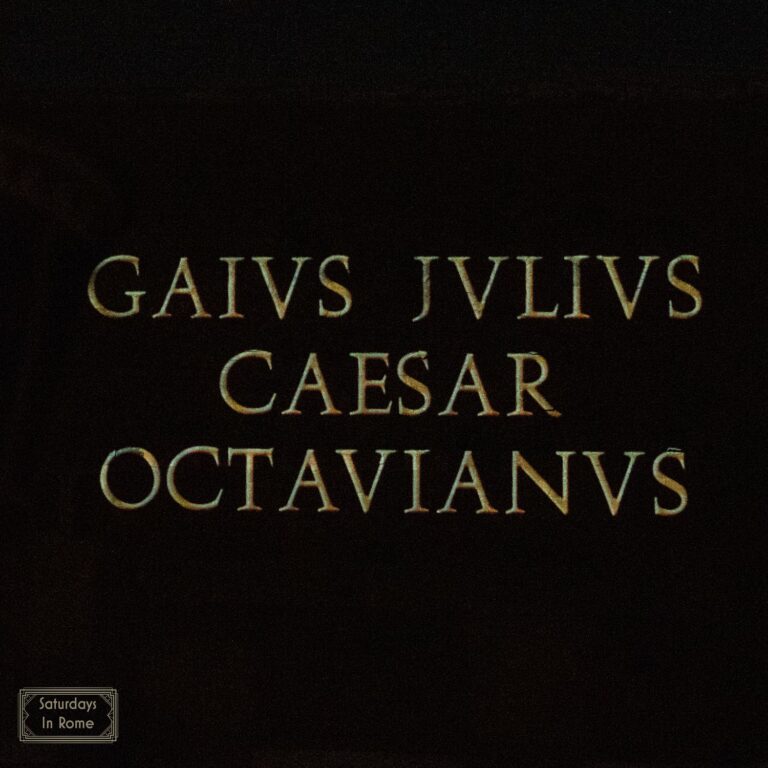
The Forum of Augustus
The Forum of Augustus is one of the imperial forums in the center of historic Rome and this guide will share the history and describe a great nighttime tour.
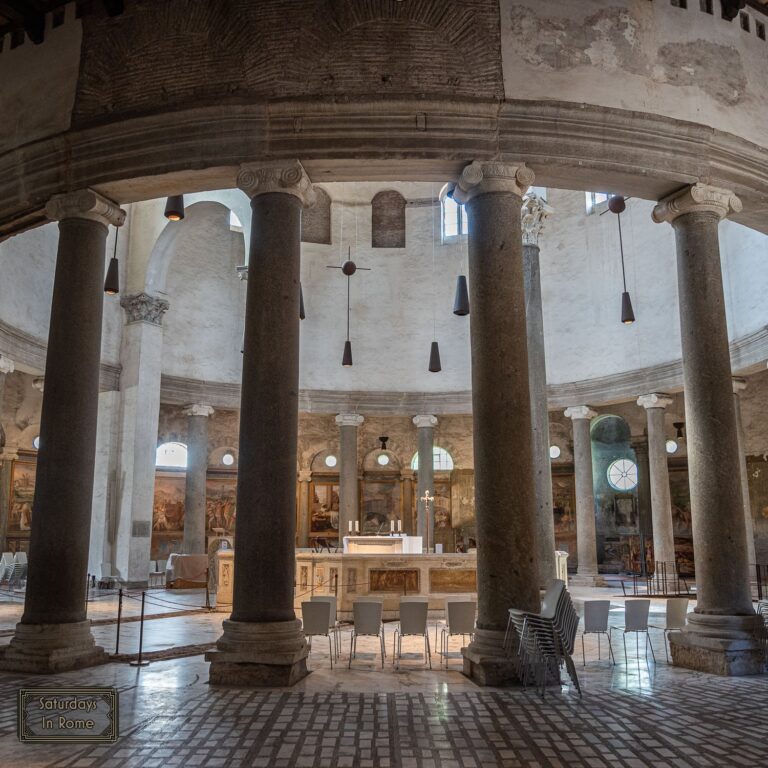
The Santo Stefano Rotondo Church In Rome Must Be Seen
The Santo Stefano Rotondo church in Rome is only a few steps from the Colosseum and worth a visit to see the amazing architecture and the dramatic frescoes.
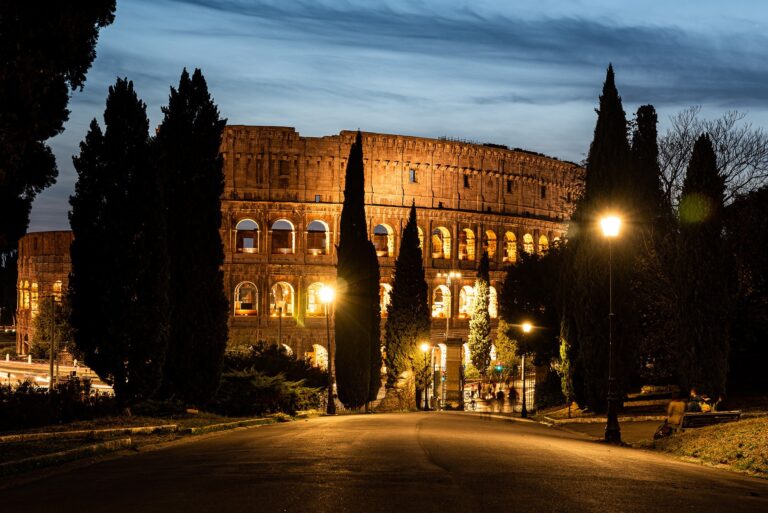
A Rome Travel Itinerary For Amazing Vacation Memories
This Rome travel itinerary for your first visit to the Eternal City is important so that you have a great vacation full of memories to take with you back home.
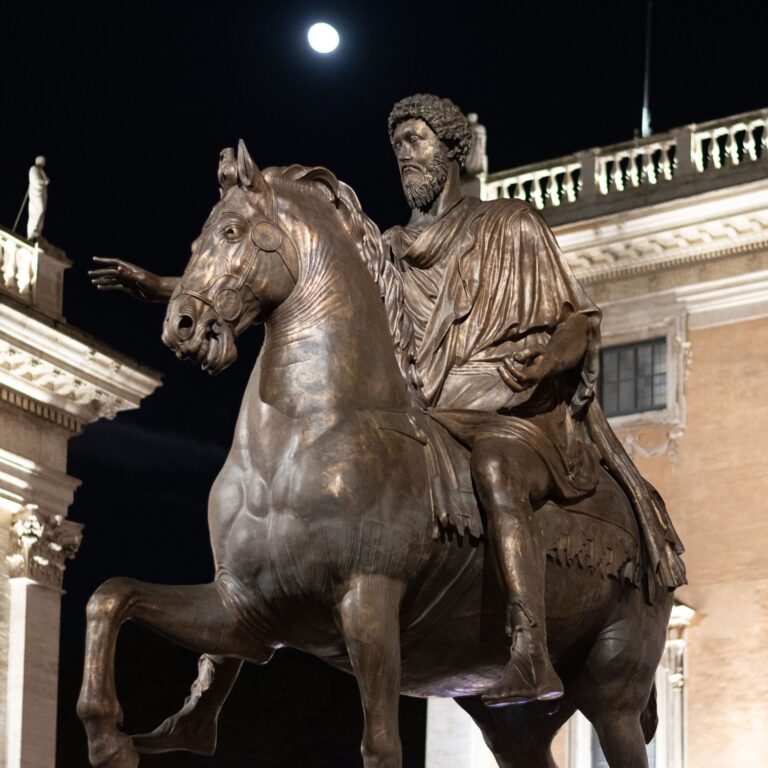
Your Second Time In Rome Still Needs An Itinerary
A second time in Rome still needs an itinerary for the amazing things that remain to do during another 3 days in Italy and to make another visit memorable.
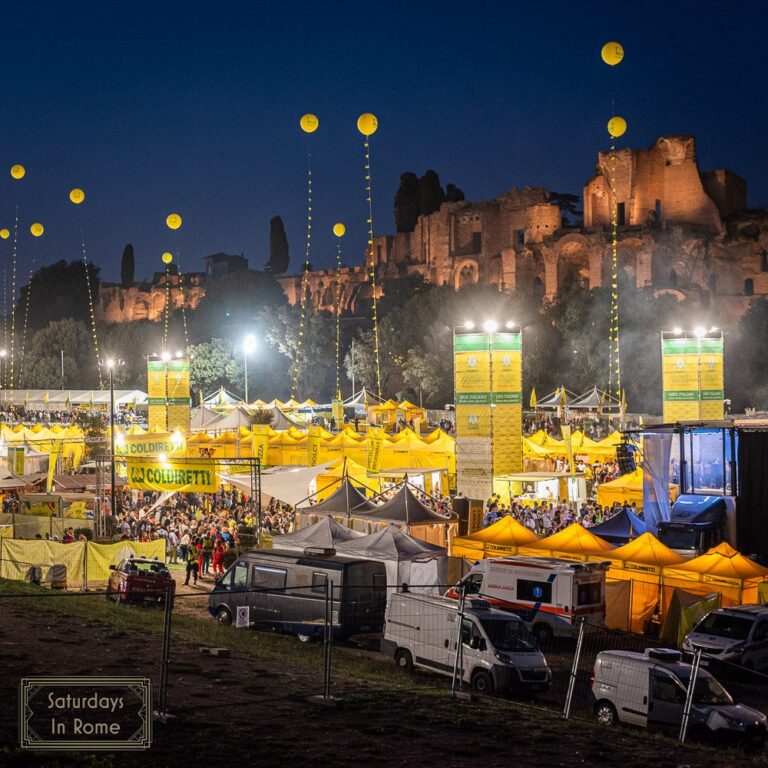
The Best Farmers Market In Rome And Around Italy
The best farmers market in Rome is the annual Coldiretti Village, an amazing farmers market that celebrates the best Italian cuisine directly from the farmers.
Monasteries to Visit in Italy
:max_bytes(150000):strip_icc():format(webp)/martha_bio-56a3c8865f9b58b7d0d3b5fe.jpg)
Italy has many interesting monasteries and abbeys that can be visited, ranging from evocative ruins to monasteries still in use today where you can take a tour, have lunch, or sometimes even spend the night. They're often in a very beautiful setting, too. Here are the ten best monasteries to visit in Italy.
La Sacra di San Michele, Piemonte
La Sacra di San Michele , or Saint Michael, is a stunning Abbey and monastic complex sitting atop a hill in Piemonte's Susa Valley, about midway between Mont San Michel in France and San Michele Sanctuary in Puglia . Dating from 983, it became one of Europe's most famous Benedictine monasteries from the 11th - 14th centuries. A visit includes seeing the restored frescoes, the newer monastery from the 12th - 15th centuries, and museum of daily life. The abbey was the inspiration for the book, The Name of the Rose .
Montecassino Abbey, South of Rome
Originally founded in 529 by Saint Benedict, Montecassino is one of Europe's oldest monasteries. It sits atop Monte Cassino with magnificent views of the surrounding area. Monte Cassino is famous as the scene of World War II battle in which the abbey was completely destroyed in the bombing, but it has since been rebuilt. It's still a working monastery but is open to visitors. Allow a couple of hours as there is a lot to see.
La Verna Sanctuary and Monastic Complex, Tuscany
TripSavvy / Christopher Larson
La Verna is one of the sites in Italy associated with Saint Francis , where he is said to have received the stigmata. Saint Francis founded a small church in this beautiful spot, perched on a rocky promontory, in 1216. Later a Franciscan monastery and larger church were developed but you can still see the original church, the cave where he slept, and the chapel built on the spot where he received the stigmata.
Monastery of Santa Croce at Fonte Avellana, Le Marche
The Benedictine Monastery of Santa Croce, in central Italy's le Marche region, offers one-hour guided tours of the monastery (call in advance for an English tour). If you book ahead you can also eat lunch in the monastery. There's a shop selling products made by the monks and a bar serving herbal teas and the monastery's special liquor. Founded in 980, it's now home to the Camaldolese monks.
Just across the border into Eastern Umbria , there are several ancient monasteries and abbeys to see in Monte Cucco National Park.
Saint Benedict's Monastery in Catania, Sicily
The Monastero di San Benedetto , was established in 1334 but the Benedictine sisters moved to the monastery's current location in 1355 in what was the home of the Count of Adrano, built above the ruins of a Roman temple. A visit includes excavations of a Roman house found within the monastery, the Baroque frescoes in Saint Benedict's Church, and the 18th century Parlor of the Cloistered Convent, still home to 28 nuns.
Saint Onofrio Cloister, Rome
A peaceful spot on the Janiculum Hill, Saint Onofrio Cloister dates from the 15th century. In the cloister are frescos with scenes from the life of the hermit Onofrio. Renaissance Poet Torquato Tasso lived in the monastery and died there on April 25, 1595. His elaborate tomb is in a chapel at the monastery and there's also a museum with manuscripts and editions of his work. The Franciscan Friars of the Atonement still live at the monastery.
Also in Rome is the Santa Croce in Gerusalemme Church and Monastery complex with a monastic garden that can sometimes be visited on request. Behind the garden are remains of the ancient Roman Castrense Amphitheater .
For a more macabre monastery experience in Rome, head to the Capuchin Crypt , near Piazza Barberini, where bones of more than 4000 deceased monks are artistically displayed in a series of chapels in the convent's crypt.
Santa Chiara Monastery Complex, Naples
Santa Chiara Church and Monastery were built in the 14th century and the original church was the largest Clarissan church ever built. The majolica tiled columns and benches and 17th-century frescoes in the cloister are beautiful and the peaceful courtyard makes a good contrast to the bustling center of Naples. The visit includes the archeological area with an excavation of a Roman bath, a museum with religious and archeological relics, Christmas cribs, tombs, and relics of Saint Louis of Toulouse, including his brain.
Pomposa Abbey, Emilia Romagna
Pomposa Abbey, a Benedictine Monastery near Ferrara , dates from the 9th century and was once one of the most important monasteries in northern Italy as it was a center of culture. Its library was famous for its manuscripts and our system of musical notation was developed here in the 11th century. Inside the Romanesque Church are frescoes and inlaid mosaic pavement.
San Marco Monastery Museum, Florence
The San Marco Museum is housed in the monastery cloisters and is famous for its frescoes and artworks created by the monk and Renaissance artist, Fra Angelico. Its also important as the monastery where Savonarola, the 15th-century Dominican monk who preached against art and literature, lived, and visitors can see his cell. The museum also contains other important Renaissance artworks.
Romanesque Cloister at Torri, Tuscany
Near Siena, the Church of the Holy Trinity at Torri is an off the beaten track place rarely visited by tourists, with limited visiting hours. It's said to be the only example of a Romanesque cloister still standing in Tuscany. The cloister has beautiful marble columns topped with interesting carved capitals. The monastery was first mentioned in 1070 and remodeled in the 13th century.
Stay in a Monastery or Convent
Some monasteries and convents rent out rooms for overnight guests. Accommodations may be basic and some have a shared bathroom down the hall but they can be economical and are usually clean, safe, and quiet.
Visiting Montecassino Abbey
Italy UNESCO World Heritage Sites: Central Italy
Infiorata - Flower Art Festivals
Capri Italy Guide: Planning Your Visit
Italy's Best Museums
Seeing Mummies and Skeletons in Italy
Exploring World War II Sites in Italy
The Most Beautiful Castles in Italy
May Festivals in Italy
Northern Italy's UNESCO World Heritage Sites and Cities
Umbria Travel Map and Places to Visit in Italy's Green Heart
Top 10 Cathedrals to See in Italy
The 15 Best Cities in Italy
Palio of Siena Festival
Top Places to Go in Puglia, Southern Italy
March Festivals and Holiday Events in Italy
- Travel Tips
- Attractions
- Things to do
- Food & Wine
Art & Culture

Rest of the world
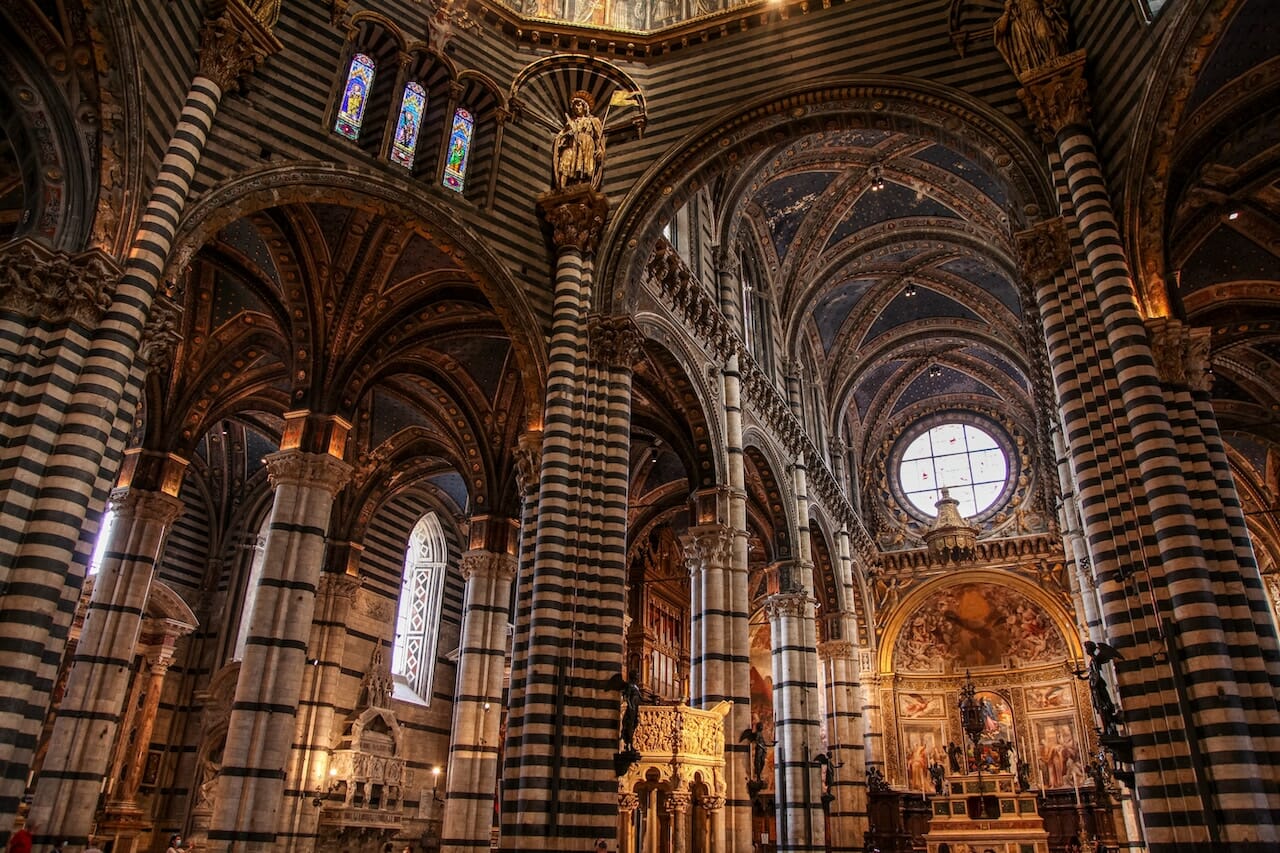
20 Amazing Churches In Italy You Have To Visit On Your Next Trip
October 25, 2023
We have never met someone who visited Italy without stepping inside at least one church to marvel at the art and architecture on display. Churches in Italy are among the world’s most impressive buildings. Their interiors and exteriors embody the history of Italy and remain some of the most jaw-dropping monuments in the country.
Though there are thousands of Cathedrals, churches, and chapels in Rome alone, let alone all of Italy, some stand out above the rest based on their size, their art, the elegance of their design or their ability to awe and inspire those who step through their doors.
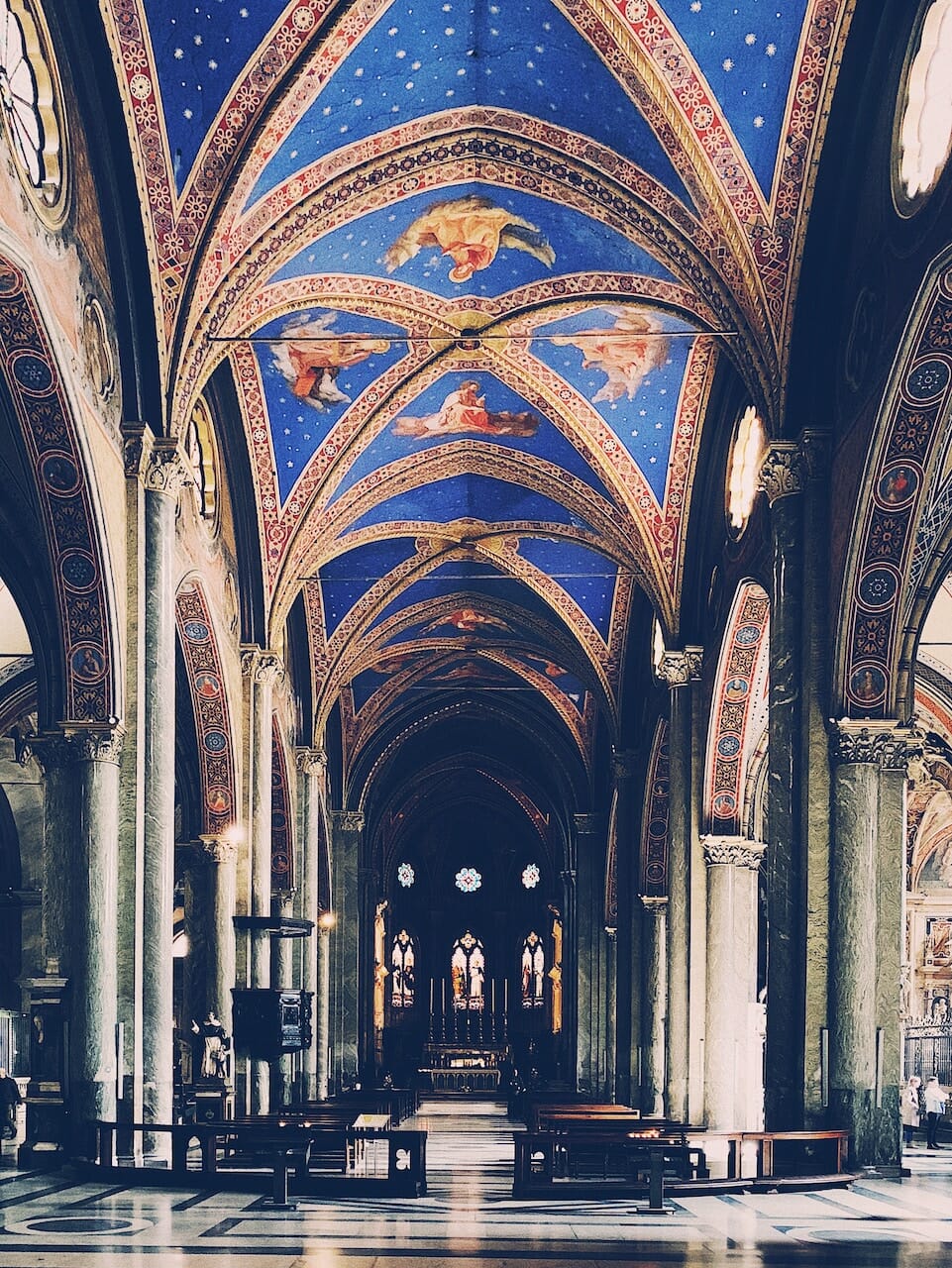
From Assisi’s Basilica of St. Francis to Rome’s Santa Maria sopra Minerva (pictured here), Italy has no shortage of amazing churches. Photo credit: Sergei Wing
Table of Contents
20 Must-See Churches in Italy
Santa maria assunta (duomo di siena), siena.
Santa Maria Assunta is another massive Duomo dedicated to Saint Mary of the Assumption, but it has a few features that really make it stand out. For one, Siena’s cathedral has our vote for the most all-around beautiful church in Italy inside and out.
While the facade drips with beautiful stonework, the inside is a treasure trove of frescoes, paintings, and gothic/Romanesque architecture. Don’t forget to look down: the floor is inlaid with intricate marble mosaics that are among the best of there kind anywhere in the world. If these things aren’t enough, the cathedral also contains the the Piccolomini Library (packed with illuminated choir books and frescoes), a crypt, a baptistry and a museum, all of which merit visits.
Interested in climbing to the top of Siena’s Duomo? Then the best way to see this church is the “ Gate of Heaven ” tour to see both the inside and outside from a birds-eye-view!

Siena’s majestic cathedral dates to the 12th century. Photo credit: Mario La Pergola
Santa Maria del Fiore, Florence
Like most cathedrals in Italian cities, Florence’s main cathedral is more often called, simply, the “Duomo.” Unlike most cathedrals in Italy, however, the actual Dome of this Duomo is a historical and architectural wonder!
Though construction on the Cathedral started in 1296, the structure’s dome wasn’t begun until the 15th century, some 200 years later. The problem was that no one on earth in the 13th century knew how to build a dome large to fill the space left for it, which ran 150 feet wide and 180 feet off the ground. The winning solution came from a goldsmith – and boy genius – Filippo Brunelleschi. The artist suggested building two domes, one inside the other to make up for not only how large the space was, but also the pressure inherent in such a large structure.
Brunelleschi began work on the project in 1420, and today the magnificent outcome stands proud in the center of Florence, an enormous brick masterpiece, visible from nearly every corner of the Renaissance city. Along with Rome’s Pantheon and St. Peter’s Basilica, Santa Maria del Fiore can rightly be considered a building that changed the course of architectural history.
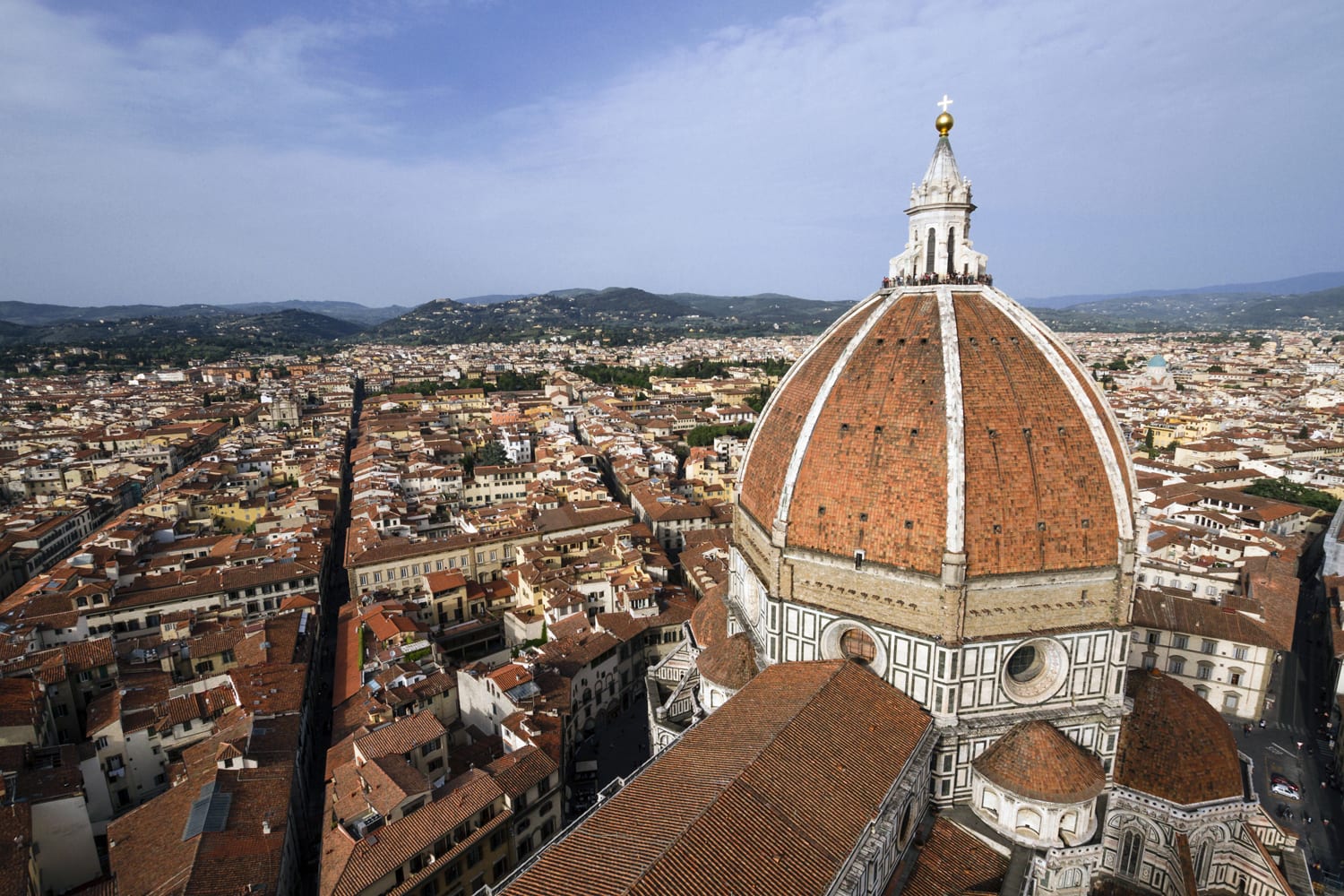
The Florence Duomo is one of the greatest works of architecture in the world.
St. Peter’s Basilica, Vatican City
Though technically in the Vatican City, the tiny city-state that shares the riverbanks with Rome, St. Peter’s Basilica is one Cathedral you absolutely can’t miss. The biggest cathedral in the world and the heart of the Catholic Church , St. Peter’s is the superman of churches, and impressive enough to awe any villain.
Supposedly built on the tomb of St. Peter’s, an original Apostle of the Catholic Church, the Basilica that you see today is actually the second church to occupy the site, but far more remarkable than the first, with a dome designed by Michelangelo, a colonnade and baldachin designed by Bernini and decorations from a Pantheon of Great Italian artists.
When you step inside, “awe” only begins to describe what you feel. Every major Catholic feast day is celebrated here by the Pope himself.
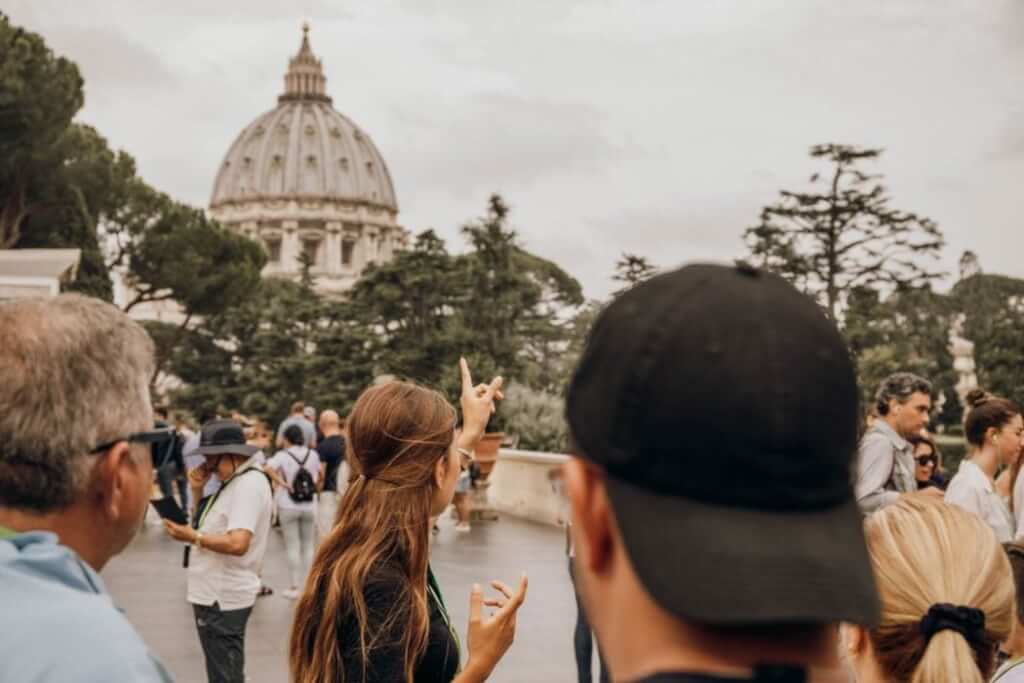
The site of the impressive St. Peter’s Basilica welcomes visitors to the Vatican City.
Santa Maria Nascente, Milan
The behemoth Duomo of Milan , as it’s nearly always called, is the fourth biggest Catholic Church in the world and definitely one of the most Gothic.
Though its style changed over the course of its 600-year construction, the gargoyles, spires and spikes decorating its white marble façade place it squarely among Italy’s most Gothic churches. Its also one of Italy’s biggest, taking up an entire city block!
Tour inside to see the massive pillars supporting the stained glass arches, then head up the stairs (or the conveniently placed elevator) to the Duomo’s terrazza , the cathedral’s roof, where you can view the gargoyles up close and look out over Milan clear to the Alps beyond.
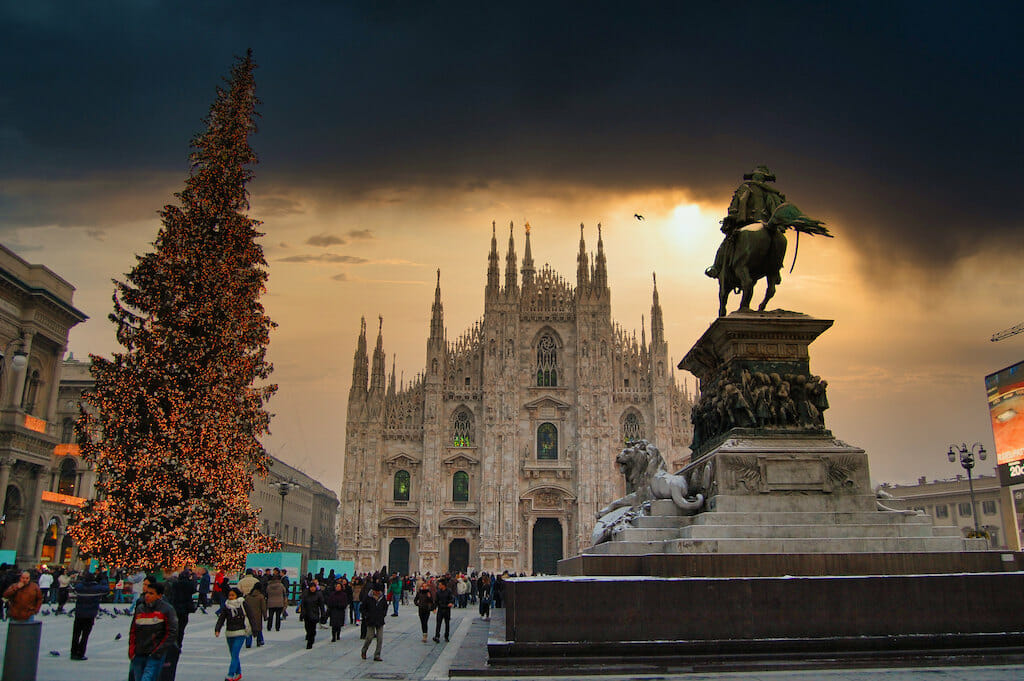
Love it or hate it, Milan’s Duomo is a sight to behold! Photo credit: Drew de F Fawkes
Santa Maria sopra Minerva, Rome
If Milan’s Duomo holds the title for most impressive Gothic facade in Italy, Santa Maria sopra Minerva has the most impressive Gothic-style interior.
One of the few Gothic churches in Rome, whose style tends toward Baroque, the 13th century church has some of the most stunning vaulted ceilings of any church in Italy. It’s covered in a luminous ultramarine and flecked with golden stars, as if the most vibrant night sky was directly above you.
It’s said the Basilica is built atop the ruins of a temple for Minerva (where it gets its name), one for the Egyptian goddess Isis and one for the Greco-Egyptian god Serapis but today it is one of Rome’s most important Basilica’s and even houses the tomb of St. Catherine of Siena, a patron saint of Italy.
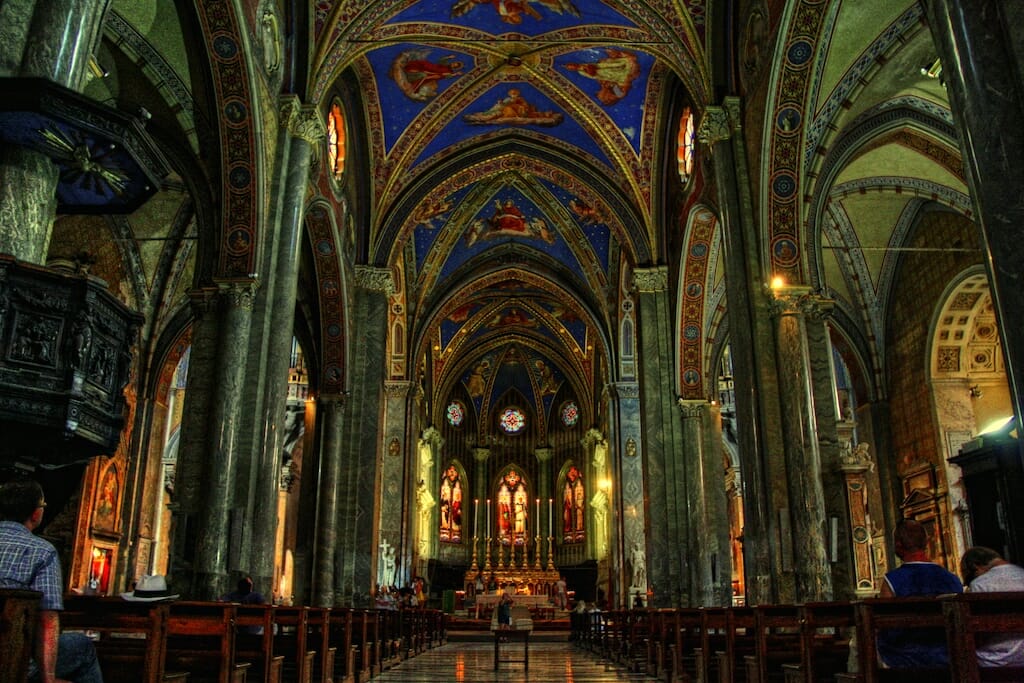
Rome’s Santa Maria sopra Minerva is a church, a treasure trove, and an art gallery all in one. Photo credit: Michiel Jelijs
The Pantheon, Rome
The Pantheon was originally built by the Romans in AD 124 as a temple to the citizens various gods. It was only converted into a Christian church in AD 609, but the austere architecture and eerie symmetry still give the building an unmistakably pagan air.
This incredible structure has been studied by just about every serious architect since the Renaissance, making it one of the most influential buildings in the entire world. To this day, it boasts the largest unreinforced concrete dome on earth. Consider that for a second – unknown builders working nearly 2,000 years ago created a dome that has not been bettered, ever. This testament to the genius of ancient Roman builders (and the fickleness of Roman religious observances), is also the best-preserved ancient Roman building in all of Rome !
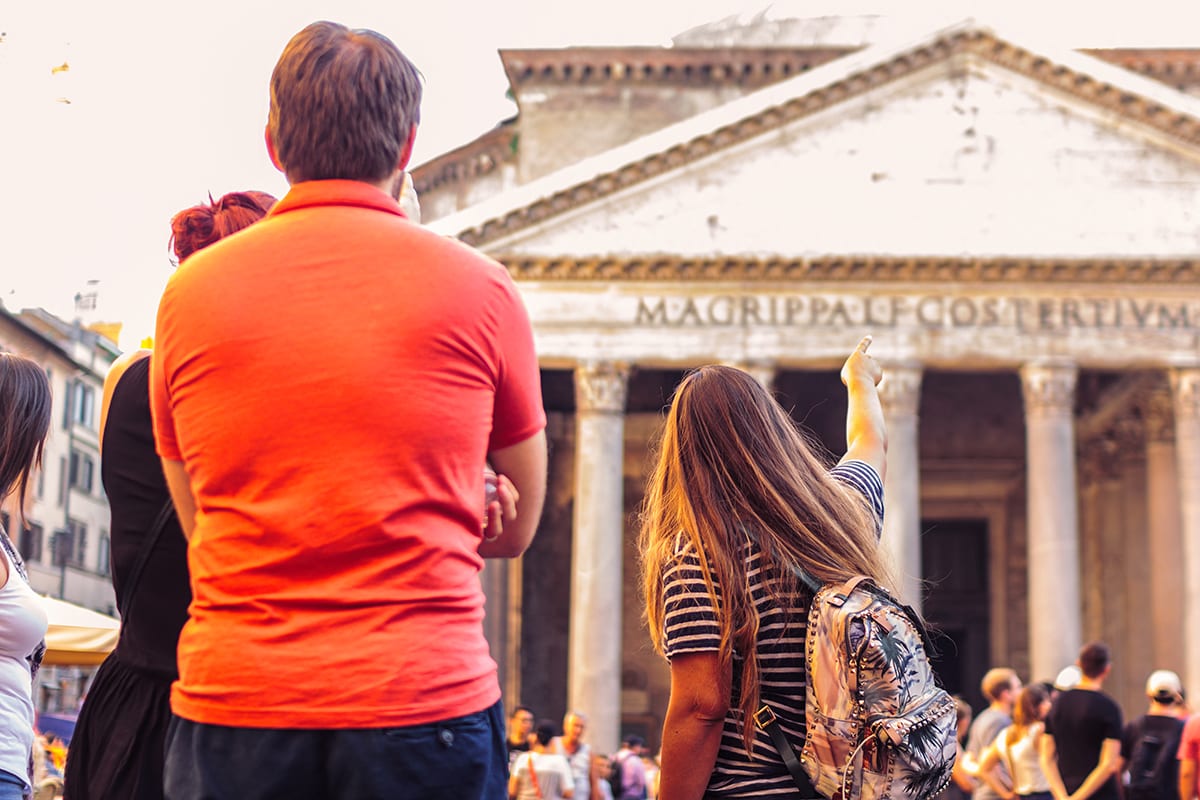
As an incredibly well-preserved building, you can experience the Pantheon much as the ancient Romans did.
St. Mark’s Basilica, Venice
In a country full of Medieval, Renaissance, and Baroque churches, St. Mark’s is a uniquely Byzantine masterpiece.
This style of art originated in the Eastern Roman Empire, which counted Constantinople as its capital, and exerted political and social influence over much of Eastern Europe and the Near East. No other Cathedral in Italy has as much well-preserved Byzantine influence as St. Mark’s ; consequently the church sports over 85,000 feet of golden mosaics.
The 11th-century Basilica stands as a tribute to St. Mark, an apostle and Venice’s patron saint. Under his aegis, Venice was instrumental in the sacking of Constantinople in 1204 – a foray which filled their coffers with loot and contributed a lot of gold and art you see in the church today. Perhaps no other church in Italy represents the history and culture of its City as well as this magnifiscent Basilica.
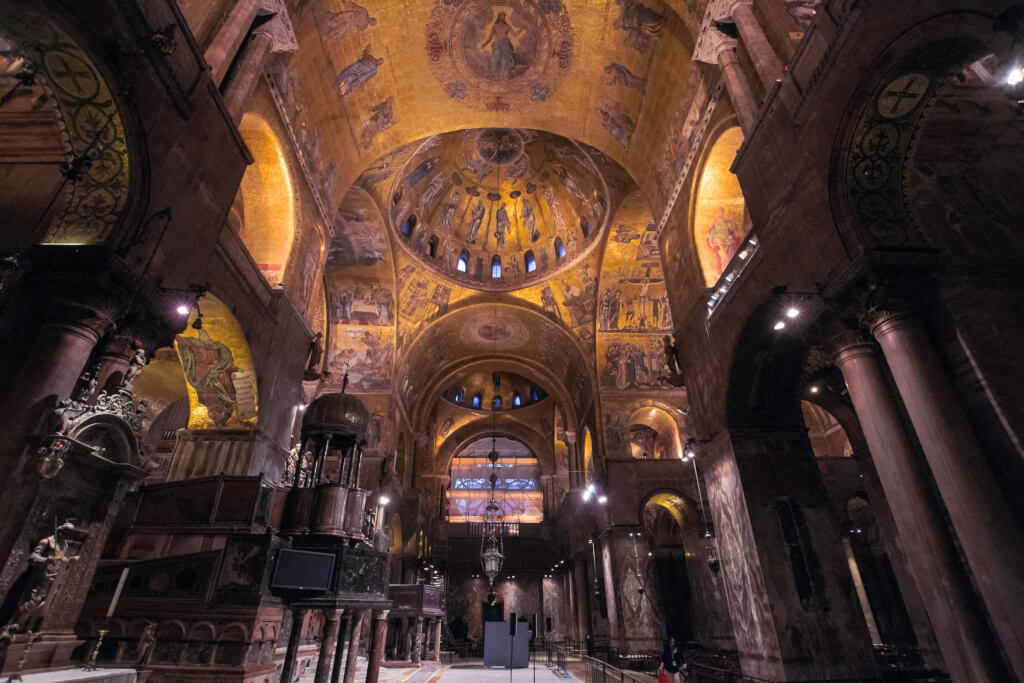
The glittering, overwhelming gold mosaics have given the Basilica the nickname Chiesa d’Oro (Church of Gold).
Cattolica di Stilo, Stilo
St. Mark’s Cathedral may be the best-known Byzantine church in Italy , but its not the only one. the Cattolica di Stilo is perhaps the best example of Byzantine-Catholic architecture in the south.
Located in Calabria, right on the toe of the Italian peninsula, the 9th century church was built when the Byzantine empire still controlled Southern Italy. While St. Mark’s is full of Venetian Opulence, this gem is one of the best surviving examples of the austere Eastern monastic tradition.
Though the church is tiny and the façade unassuming, its diverse history – mixing byzantine, Roman Catholic, and arabic influences – is truly unique. Perched on the side of a mountain, its red and brown brick towers nearly blend into the slope, but the views it offer over the town, valleys and sea below are second to none.
St. Antonio Trullo Church, Alberobello
When in Rome, do as the Romans do, and when in Alberobello, do as the Alberobellians – and by that we mean visit a trulli church!
Alberobello is a small town and UNESCO World Heritage Site in Puglia made famous by its traditional trulli houses, or ancient cone-shaped peasant houses. Naturally, the town’s churches are constructed in the same style. Though it’s a relatively young candidate on this list (it was finished in 1927) the St. Antonio (St. Anthony) Church is a perfect mix of Puglia’s ancient construction techniques and modern-day conservation sensibilities. It’s also a beautiful example of the cultural importance of Alberobello’s unusual architecture.
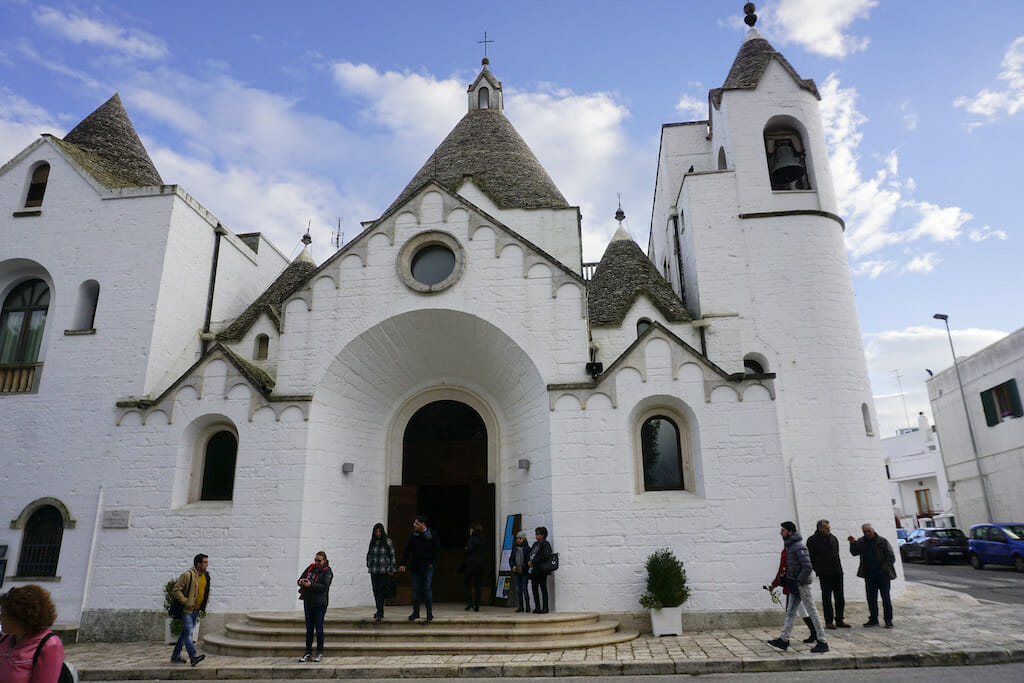
Alberobello’s Church of St. Anthony is one of the most unique churches in all of Italy. Photo credit: Boris Kasimov
The Church of Curon, South Tyrol
This church in South Tyrol is located in Lake Resia. No, no overlooking it – its actually submerged in the lake! Today, only the 14th-century bell tower of the Church at Curon is still visible or visitable . The rest is under water.
The town, located on the border of Italy and Austria, was flooded to create a lake and the only visible remnant of it is the beautiful bell tower poking up through the surface of the placid lake. Depending on the water level you can also see a part of the semi-submerged church at times. Of course you won’t be attending a mass here anytime soon, but visitors in the winter can walk out to the bell tower when the lake freezes and the strange sight remains surprisingly beautiful, year round.
Santa Maria d’Idris, Matera
This church is located in Matera, a UNESCO World Heritage Site renowned for its unique dwellings literally cut into caves in the side of a mountain.
Like many of the buildings in Matera , Santa Maria d’Idris is located in a small cave on top of a cliff. The atmosphere is certainly unique, if not a bit eerie. The ancient rock city actually has dozens of caves carved throughout it, many of which are used as churches. This one, in particular, overlooks the canyon of Matera and contains gorgeously frescoed “meditation chambers” that are a testament to the monastic lifestyle once lived within the bare stone walls.
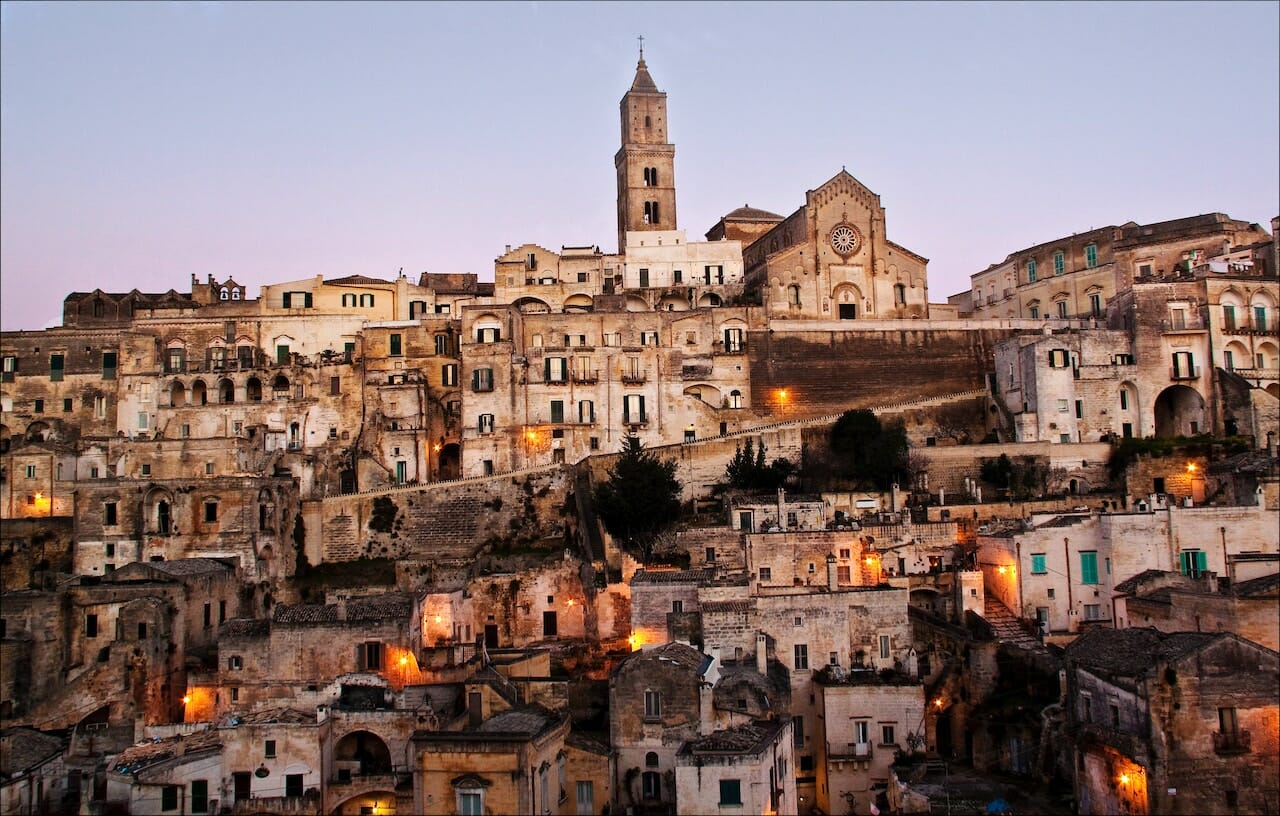
This unique church in Matera is built directly into the rocks! Photo credit: Sterlinglanier Lanier
Basilica di San Vitale, Ravenna
Ravenna is renowned for the magnificent Byzantine mosaics scattered throughout the city. And the best of these mosaics can be found in the Basilica di San Viale .
Originally composed in the 6th-century, these incredible works of what is now considered a dying art, are without parallel in their skill and execution. The walls and ceilings are absolutely covered in glittering gold scenes and incredibly detailed motifs. Given the honorary title of “basilica” for its historical and religious importance, San Vitale is also one of several UNESCO World Heritage Sites in Ravenna to visit!
Basilica di Santo Stefano, Bologna
The beauty and mystery of of Santo Stefano is that it’s actually many churches combined into one. Locals refer to as the sette chiese , or “seven churches” because of its original layout comprised (an estimated) seven churches, each built at a different time between the 4th and 13th centuries.
Catholic tradition has it that the complex sits atop a temple of the Egyptian goddess Isis. An even harder to prove legend states that the seven churches were each meant to represent locations of the Passion of Christ. After significant restoration projects over the years, only four distinct churches are visible today, but the Basilica is still one of the most interesting of Bologna’s religious buildings.
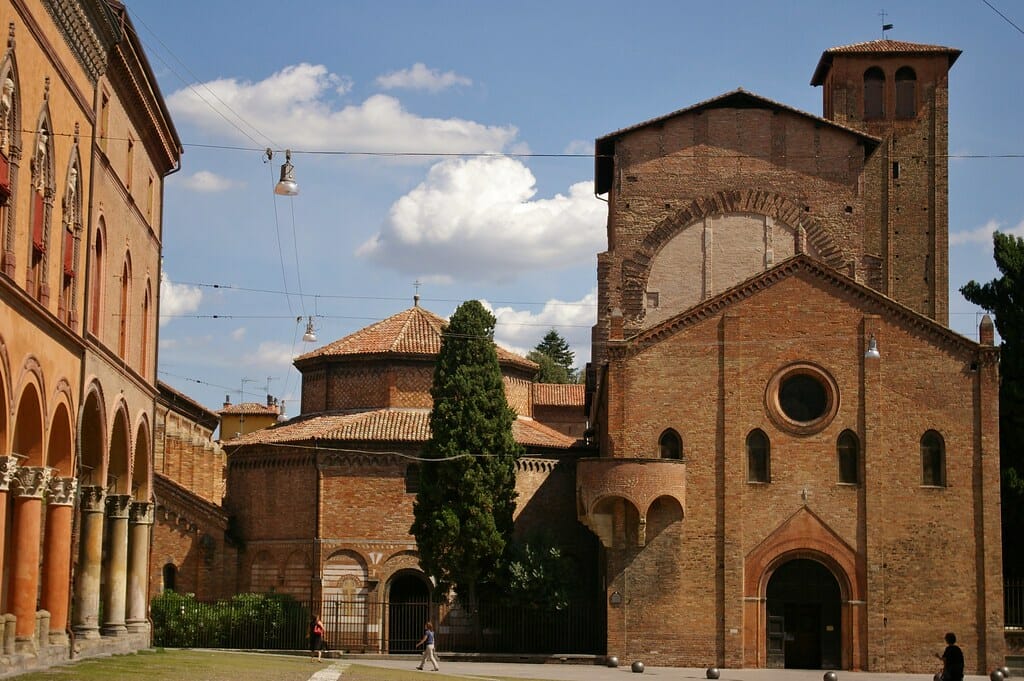
With its mysterious origins, frescoes, crypts and ancient graves, Santo Stefano is a mecca for history buffs, conspiracy theorists and legend lovers. Photo credit: Pablo Cabezos
Church of Domine Quo Vadis (Santa Maria delle Piante) , Rome
This 9th century church is located right on the Via Appia, or Appian Way, Rome’s famous ancient highway and another must-see Roman attraction.
Legend has it that this is the spot where Peter bumped into a vision of Christ when he was fleeing Nero’s persecution in 64 AD. He asked Christ, “”Domine, quo vadis?” or “Lord, where are you going?” Jesus indicaed that he was heading back to Rome, convincing, (or perhaps guilting) Peter to return as well and face martyrdom. Inside the church is the stone that supposedly has the footprints of Jesus.
Basilica of St. Francis of Assisi, Assisi
Few of the churches on this list have an interior as unique, impressive and historic as the Basilica of St. Francis in Assisi, Umbria .
The 13th-century basilica is split into two levels, the upper and the lower, and each has been filled with impressive art. The upper level, or Basilica Superiore , is covered with 28 floor-to-ceiling frescoes by Giotto (with extensive help from members of his school) which are probably the main artistic stars of the church. Each fresco is a scene from St. Francis’ life. Though centuries old, the frescoes are still fabulously vibrant and historically jaw-dropping. Below, in the Basilica Inferiore, you can find work by Cimabue, Pietro Lorenzetti, and Simone Martini, as well as St. Francis’ crypt, of course.
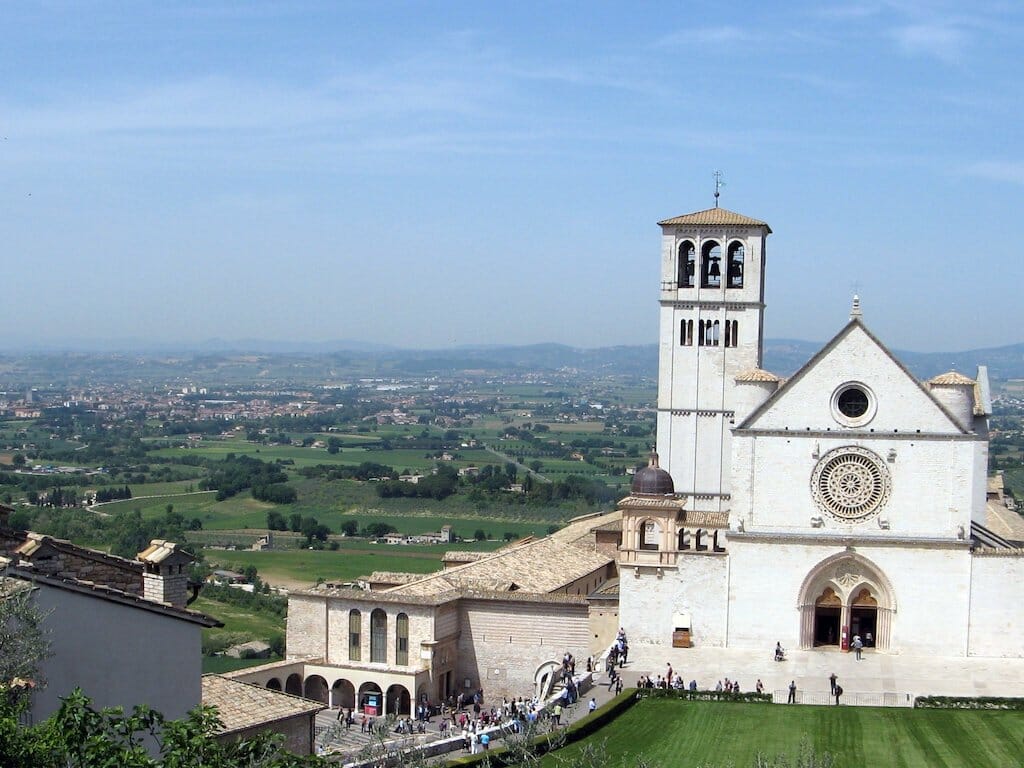
It’s hard to grasp the scale of just how big the Basilica of St. Francis is until you step inside. Photo credit: Randy Greve
Monreale Cathedral, Palermo
One of the oldest churches on the list, 12th-century Monreale Cathedral in Palermo is also the best example of Norman architecture on this list. In it’s opulent interior and vibrant mosaics you’ll see a perfect mix between Byzantine and Sicilian influence. The entire interior is covered with the aforementioned mosaics, all in gold, covering 68,220 square feet in total. It’s said they are second only to the Hagia Sophia in size, though much better preserved and much less known.
After ogling the mosaics, the biblical reliefs, and the intertwined columns in marble and tufa, note also the enormous bronze doors, some of the only in all of Europe, then climb to the terrace for a panoramic view over the sea and the bay of the Conca d’Oro .
Santa Maria Assunta, Orvieto
Orvieto might be small, but you’d never know it looking at its cathedral. Its incredible façade was created over a 200-year-period and with at least five different artists. The Romanesque-Gothic architecture glitters with gold mosaics and perfectly carved marble. A jaw-dropping stained-glass rose window dominating the center. The Duomo is filled with detailed columns and elaborate frescoes detailing the life of Mary. Truly a design exaggeration for such a small town and a beautiful sight in the Umbrian hills!
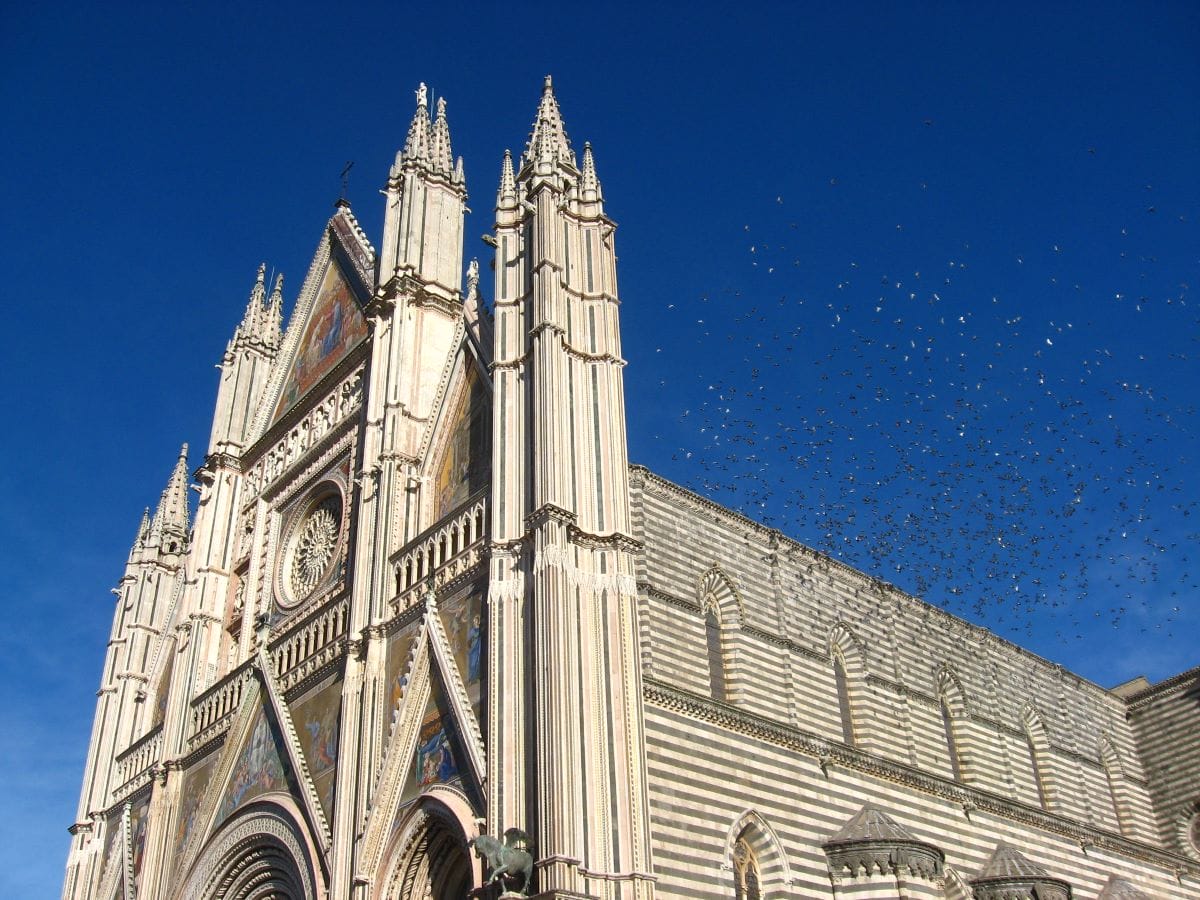
The Santa Maria Assunta, Orvieto, refers to the Cathedral of Orvieto, which is also known as the Orvieto Cathedral or the Duomo di Orvieto. Photo credit: Michela Simoncini
St. Agatha’s Cathedral, Catania
St. Agatha’s Cathedral is a testament to the determination of man in the fight against nature. Built in the 12th century, the cathedral has been destroyed several times because of earthquakes and eruptions from nearby Mount Etna . Just a little over one hundred years after its construction it was destroyed by an earthquake, a later fire was followed by another earthquake that left the church in ruins.
Since being rebuilt in 1711, the church has weathered eruptions, wars, and even more earthquakes. Still, the white church stands proud and beautiful in Catania, composed largely of volcanic stones. It also boasts the third largest bell tower in all of Italy, after St. Peter’s Basilica and the Duomo of Milan.
Basilica of San Miniato al Monte, Florence
Standing atop the only hill in Florence proper, the San Miniato al Monte Basilica lords over the city. Local and visitor alike the hike up to Piazzale Michelangelo (it takes about 20 minutes though there are buses as well) in order to enjoy one of the best views over Florence!
The Basilica is joined by an adjacent monastery on one side and a cemetery on the other. Inside, the 13th-century church has changed little over the years, and even the atmosphere feels decidedly old. At dusk, you might be able to catch the church interior illuminated by candles!
Go before closing time (around 7pm, 8pm in summer) to tour the church, then stick around to watch the sun set over Florence, and the churches below turning on their lights.
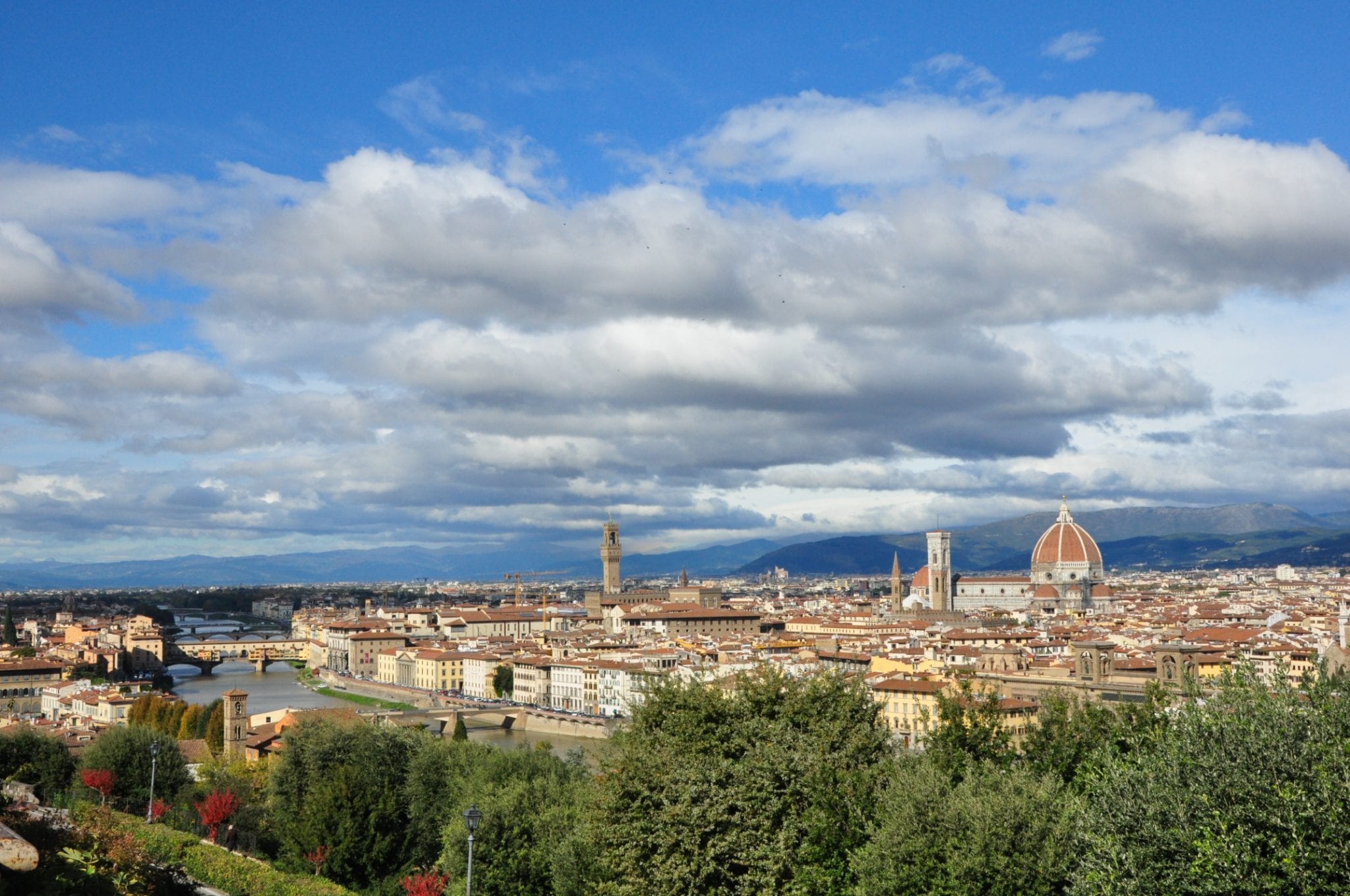
There’s nothing like the view of Florence from Piazzale Michelangelo.
Basilica della Santa Casa ( The Basilica of the Holy House of Mary), Loreto
This Basilica of the Holy House was built in the 15th century atop a small shrine that is much, much older. It’s said that this shrine is the acual house of the Virgin Mary – not only where she lived, but also where Jesus himself was conceived and raised.
Catholic belief is that this house was miraculously moved by angels from its original location in Nazareth to Croatia to protect it during attacks by the Turks in the 13th century. Three years later angels saved the house again during the Muslim invasion of Albania, moving it to a town called Recanati in the region of Le Marche.
Its third and final move, the Basilica of the Holy House eventually arrived in its present location in Loreto. Modern investigations by the church have supported the claim that the house is in fact from the Holy Land, though historians tend to refute the role of angels in favor of more quotidian crusaders and wealthy benefactors who paid for the house’s various moves. One way or another this basilica houses one of Catholicism’s most important relics, not to mention a ton of history. Its an impressive sight for Catholics and non-Catholics alike.
Insider’s tip: Find out more about the j aw-dropping properties owned by the Catholic Church .
by Gina Mussio
Book a tour.

Pristine Sistine - The Chapel at its Best
1794 reviews

Premium Colosseum Tour with Roman Forum Palatine Hill
850 reviews

Pasta-Making Class: Cook, Dine Drink Wine with a Local Chef
121 reviews

Crypts, Bones Catacombs: Underground Tour of Rome
401 reviews

VIP Doge's Palace Secret Passages Tour

Legendary Venice: St. Mark's Basilica, Terrace Doge's Palace
286 reviews
Stay up to date with travel tips, local insights and all things Italy on our social channels!
Subscribe to our Newsletter
Get curated Italy travel tips delivered to your inbox!
Your browser is out-of-date!
Update your browser to view this website correctly. Update my browser now

Explore The Amazing Catholic Sites in Rome: A Catholic Guide to Rome
Hello Mamas, are you planning a family pilgrimage to Rome but not sure what churches or holy sites to visit because of the many choices? If so, this travel guide post is for you!
Rome, often referred to as the “ Eternal City ” stands as a testament to the Catholic faith and its rich religious history. For many pilgrims, a visit to Rome is not just a journey of miles but a spiritual voyage. It’s a chance to walk in the footsteps of saints, martyrs, and popes, and to connect with the very roots of the Catholic Church.
However, with over 900 churches, visiting all the beautiful churches on a pilgrimage is impossible. Let alone if you have kids in tow, who get bored easily. So, I’m making a list of the most famous Catholic pilgrimage sites in Rome in the hope of helping you plan your future family pilgrimage to the Eternal City.
Discover the Vatican: The Spiritual Heart of Rome
When it comes to Catholic sites in Rome , the Vatican is undoubtedly the spiritual heart of the city. This small independent state, within the borders of Rome, is home to some of the most significant religious sites in the world .
The Vatican is a collection of beautiful buildings and museums, but its spiritual significance lies with the papacy. For centuries, the Vatican has been the center of the Catholic Church, and its influence extends beyond the borders of Italy.

If you’re planning a visit to the Vatican, you won’t want to miss the papal basilicas , which are some of the most stunning churches in Rome. Saint Peter’s Basilica , located within the Vatican City , is the largest and most famous of all the basilicas. This breathtaking church features works by some of the greatest artists of the Renaissance, such as Michelangelo’s “Pieta” and Bernini’s “Baldacchino.”
Exploring Vatican City is an unforgettable experience, and there’s so much to discover in this spiritual heart of Rome. Whether you’re admiring the stunning architecture, exploring the Vatican Museums, or attending a papal audience, a visit to the Vatican is an essential part of any trip to Rome.
BOOK VATICAN CITY TOURS HERE
Embark on a Pilgrimage to the Seven Pilgrim Churches of Rome
Rome is home to Seven Pilgrim Churches , which are significant religious sites for Catholics worldwide. These important churches serve as places of pilgrimage and are visited by millions of Catholics each year. The Seven Pilgrim Churches consist of:
**Note : St. Sebastian Outside-the-Walls (Minor Basilica) was replaced on the pilgrimage route by Pope John Paul II in the year 2000 with the Sanctuary of Our Lady of Divine Love.
CHECK DIFFERENT CATHOLIC TOURS IN ROME HERE
These churches are steeped in history and offer a spiritual experience like no other. Rome’s pilgrim churches are an essential part of any Catholic’s pilgrimage to the Eternal City.
The pilgrimage of the Seven Pilgrim Churches began in the 16th century to promote and encourage the Catholic faith . The seven churches were chosen due to their connection with the early Christian martyrs and their significance in the development of the Catholic Church. The pilgrimage is an opportunity for Catholics to connect with their faith and deepen their understanding of the church’s history and traditions.

Basilica of St. John Lateran : Often referred to as the “ Mother and Head of all churches in Rome and in the world “, this archbasilica is the cathedral of the Bishop of Rome, the Pope. It holds a special ecclesiastical significance as the episcopal seat of the Pope and is the oldest public church in the city.
St. Peter’s Basilica : Located in Vatican City, this iconic basilica is a central place of pilgrimage and one of the largest churches in the world. It stands over the historical site where Saint Peter, the chief apostle, was crucified and buried.
Basilica of Saint Paul Outside the Walls : This basilica was built over the burial place of Saint Paul the Apostle. It’s one of the four ancient major basilicas of Rome and is known for its stunning mosaics and the tomb of Saint Paul.
Basilica of St. Mary Major : This major papal basilica is the largest Catholic Marian church in Rome. It’s famed for its fifth-century mosaics and the relic of the Holy Crib or Sacra Culla , believed to be the manger in which Jesus was laid at his birth.

Basilica of Saint Lawrence outside the Walls : This is the burial place of Saint Lawrence, one of the first seven deacons of Rome who was martyred in 258. The church is one of the seven pilgrimage churches of Rome and is also the final resting place of Saint Stephen, the first Christian martyr.
Basilica of the Holy Cross in Jerusalem : Located within the city of Rome, this basilica houses important relics from Jerusalem, including fragments of the True Cross . It was initially the palace of Saint Helena, the mother of Emperor Constantine, who converted it into a church.
Sanctuary of Our Lady of Divine Love : This modern shrine replaced St. Sebastian Outside-the-Walls in the official list of the Seven Pilgrim Churches in 2000. It’s a place of devotion to the Virgin Mary and is known for its miraculous image of the Madonna.

A pilgrimage to the Seven Pilgrim Churches is a spiritual journey that is not to be missed. These churches offer a deep connection to the history and traditions of the Catholic faith and provide an opportunity for Catholics to connect with their faith on a profound level. Visiting these churches is a must for anyone exploring Rome’s Catholic sites and religious heritage.
Experience the Magnificence of the Four Major Basilicas in Rome
“Rome – the city of the Basilicas – is a testament to the past, present, and future of the Roman Catholic Church . The magnificent beauty and history contained within these great religious sites are a reflection of the profound spiritual journey that awaits all those who visit.”
When it comes to churches in Rome, the basilicas are a must-see for any traveler. Steeped in history and culture, these magnificent religious sites are architectural marvels that tell the story of Rome’s rich spiritual and artistic past.
St. John Lateran (Lateran Basilica) : As the cathedral of the Diocese of Rome, St. John Lateran holds a unique position as the “Mother Church of the world.” It is the episcopal seat of the Pope, the Bishop of Rome. Beyond its architectural grandeur, it’s historically significant as the oldest public church in the city of Rome and is uniquely termed an “archbasilica.”
St. Peter’s Basilica : Located in the heart of Vatican City, St. Peter’s Basilica stands as a testament to centuries of religious art, architecture, and devotion. It is built over the burial site of Saint Peter, the chief apostle, making it a major pilgrimage destination. Its magnificent dome, designed by Michelangelo, dominates the Roman skyline.
St. Paul Outside the Walls : This basilica is renowned for being constructed over the burial place of Saint Paul the Apostle. Its vast interior and beautiful mosaics make it a significant site of Christian worship and art. The cloister, with its intricate carvings and spiral columns, is a notable feature of this basilica.

St. Mary Major (Liberian Basilica) : Distinguished as the largest church in Rome dedicated to the Virgin Mary, St. Mary Major is renowned for its stunning fifth-century mosaics and the relic of the Holy Crib. According to tradition, the basilica was built after the Virgin Mary appeared in a dream to both Pope Liberius and a wealthy patron, indicating that she wanted a church dedicated to her to be built.
Visiting the basilicas in Rome is more than just admiring beautiful architecture; it’s a chance to connect with the city’s spiritual and cultural heritage. Each basilica has its unique features, providing visitors with a unique experience at every turn of their journey.
Other Catholic places in Rome Worth Visiting
In addition to the well-known churches and basilicas, Rome has many other Catholic sites that invite those who are interested in spirituality. These sites, although not always focused solely on religion, have become an important part of Rome’s Catholic history throughout the years:
- The Pantheon Originally a pagan temple dedicated to all the gods of ancient Rome, the Pantheon was converted into a Christian church in the 7th century and is now dedicated to St. Mary and the Martyrs.
- Santa Maria Sopra Minerva Situated just behind the Pantheon, this Gothic church is built over the ruins of a temple dedicated to the goddess Minerva.
- Santa Prassede A lesser-known gem, this church houses some of the most stunning Byzantine mosaics in Rome.
- Scala Sancta (Holy Stairs) These are the steps that Jesus climbed during his trial before Pontius Pilate.
- Santa Maria della Vittoria While relatively unassuming from the outside, this church houses Bernini’s masterful sculpture, “The Ecstasy of Saint Teresa.”
- Church of San Clemente A fascinating journey through time, this site offers a 12th-century basilica built over a 4th-century church.
- Gesù Church The mother church of the Jesuit order, its Baroque interiors, and the tomb of St. Ignatius of Loyola make it a significant site.
FAQs on the Amazing Catholic Sites in Rome
What are the four major basilicas in rome.
The four major basilicas in Rome are St. Peter’s Basilica, Archbasilica of St. John Lateran, St. Paul Outside the Walls, and Papal Basilica of St. Mary Major.
How do I plan my pilgrimage to the seven churches of Rome?
To plan a pilgrimage to the seven churches of Rome, start by researching each church, mapping out a route, setting aside a full day, dressing appropriately, and checking the opening hours.
What is the best time of year to embark on a pilgrimage to Rome?
The best time for a pilgrimage to Rome is during the spring and fall months for their mild temperatures and fewer crowds.
What is the significance of the Basilica of Saint Peter?
The Basilica of Saint Peter is the largest church in Rome and one of the seven pilgrimage churches in the city. It is considered the most important church in the Catholic religion and is the resting place of many important religious figures, including Pope John Paul II.
What is the Basilica of Saint Paul Outside the Walls?
The Basilica of Saint Paul Outside the Walls is one of the seven pilgrimage churches in Rome. It is the resting place of Saint Paul, one of the most important figures in early Christianity.
What is the Basilica of Santa Maria Maggiore?
The Basilica of Santa Maria Maggiore is one of the main basilicas in Rome and is dedicated to the Virgin Mary. It is known for its beautiful architecture and is a popular destination for pilgrims.
Are there any other important churches to visit in Rome?
Yes, besides the main basilicas, there are many other important churches to visit in Rome, such as Santa Maria in Trastevere, Santa Croce in Gerusalemme, and the Pantheon.
What is the significance of visiting the seven pilgrimage churches in Rome?
Visiting the seven pilgrimage churches in Rome is a tradition that dates back to ancient times. It is believed that by visiting these churches, pilgrims can receive special blessings and indulgences.
Is it easy to visit the pilgrimage churches in Rome?
Yes, visiting the pilgrimage churches in Rome is relatively easy as they are located within the city and can be reached by public transportation or even by walking, as many of the churches are located close to each other.
What can I expect to see at the basilicas in Rome?
The basilicas in Rome are architectural marvels and house religious artifacts, Catholic relics, some history of the church, and artworks.
What are some ancient Roman Christian churches in Rome?
Rome has ancient Roman Christian churches that showcase the development of Christianity. Notable examples include Basilica di San Clemente and Santa Pudenziana , which offer insights into the rich history and influence of Emperor Constantine on Christianity in Rome.
What is the significance of the Pantheon in Roman Catholicism?
The Pantheon holds religious significance as it was originally an ancient Roman temple and later converted into a Christian church. It stands as a testament to the triumph of Roman Catholicism and is a popular place of worship .
Are there pilgrim churches located outside the walls of Rome?
Yes, there are several pilgrim churches located outside the walls of Rome. Some notable ones include Saint Paul Outside the Walls , San Lorenzo Fuori le Mura , and San Sebastiano Fuori le Mura . These churches offer architectural beauty and a connection to Christianity.
What religious traditions and pilgrimages take place in Rome?
Rome is a hub for religious traditions and pilgrimages. Visitors can engage in veneration of relics, honor Christian martyrs, and participate in important feasts such as the Feast of the Seven Martyrs , the Feast of the Chair of Saint Peter, and the Feast of the Most Holy Redeemer , among others.

Final Thoughts on the Catholic Sites in Rome
Rome is indeed one of the family-friendly Catholic cities to visit in Italy because it is filled with incredible Catholic places to visit that will captivate both young and old alike. From magnificent churches and awe-inspiring basilicas to lesser-known gems steeped in centuries of Catholic history, there is something for everyone to enjoy.
Whether you’re looking to deepen your faith or simply appreciate the beauty of these sacred places, Rome’s Catholic sites are sure to leave your family in awe.
And I hope that the list of Catholic sites will make your travel to Rome easier and more meaningful. What sites will be part of your itinerary? Or if you’ve been to Rome before, what sites did you visit? Feel free to share your thoughts and experiences in the comments below.
BEFORE YOU GO…
These posts might also interest you:
19 Famous Catholic Pilgrimage Sites in Italy
Top 19 Most Visited Catholic Shrines In The World
17 Top Catholic Pilgrimage Sites In Europe
15 Most Popular Catholic Pilgrimage Sites in Spain
17 Most Popular Catholic France Pilgrimage Sites You Should Visit
CATHOLIC FAMILY TRAVEL RESOURCES
Looking to book your next family adventure? Feel free to use these resources that are tried and tested by my family.
If you book your next family, solo, or couple trip anywhere via the link below or with any of the hotel/travel links on the website, you’ll get the best deal available and I will get a small commission ( without any extra cost to you – the prices direct to the websites and via the links here are the same) which will help me in maintaining this site.
Book your accommodation: You can find the best prices on hotels with these two providers: Booking.com (my favorite) if you are located in Europe, and TripAdvisor if you are anywhere else. If you prefer apartment rentals, find the cheapest prices with VRBO .
Book your entrances: Book your tickets to museums and other attractions and avoid the long queue with Tiqets.com .
Book your excursions: Save time and enjoy a hassle-free excursion by hiring professional guides thru GetYourGuide and Viator .
Book your car: Get the best car rental deals by booking at least one month in advance with DiscoverCars .
If you have any questions, feel free to contact me .
is the mama behind Caballe Family . She is a cradle Catholic who loves learning more about the Catholic faith and she also loves visiting Catholic destinations and exploring Spain with her family. She used to be an au-pair/househelp in Europe for 12 years and now turned stay-at-home mama & wife, living with her family in a little village in sunny Barcelona, Spain.
Leave a Reply Cancel reply
Your email address will not be published. Required fields are marked *
Save my name, email, and website in this browser for the next time I comment.
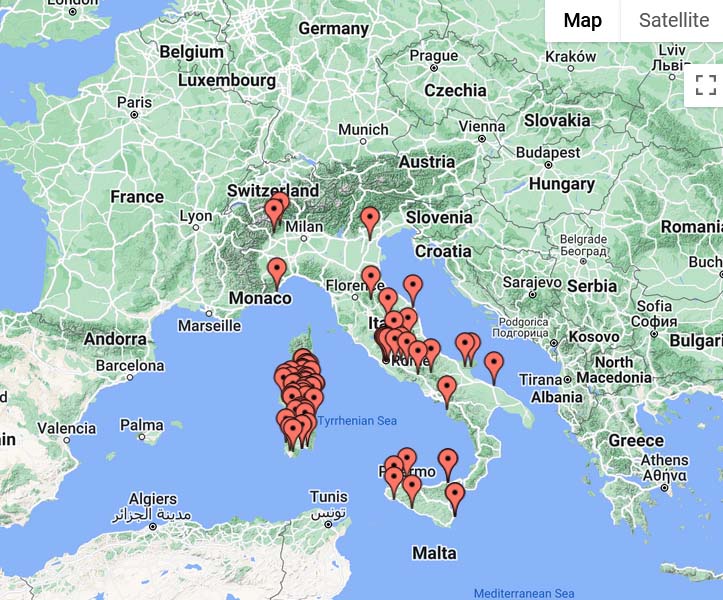
Sacred Sites of Italy
Italy travel guides.
Martin recommends these travel guides

- Global Sacred Sites List
- Introduction to Sacred Places
- New and Updated
- South Africa
- Dom. Republic
- United States
- Afghanistan
- North Korea
- Philippines
- South Korea
- Turkmenistan
- Netherlands
- Switzerland
- Saudi Arabia

- Current Edition
- Edition Archive
- Religious Travel Planning Guide
- State Guides
- Museums Guide
- Theaters Guide
- Cruise Guide
- Scenic Rail Guide
- Group Itinerary Ideas
- America 250
- Goway Travel
- Uncruise Adventures
- Broadway for Groups
- Site InSpections
- Accommodations
- History & Heritage
- Food & Beverage
- Entertainment
- Outdoor & Adventure
- Industry Events
- Expert Advice
- Industry News
- Traveling Tribes Podcast
- Traveling Tribes Book
- Subscriptions
Select Page
Top Pilgrimage Sites of Italy
Affinity Travel
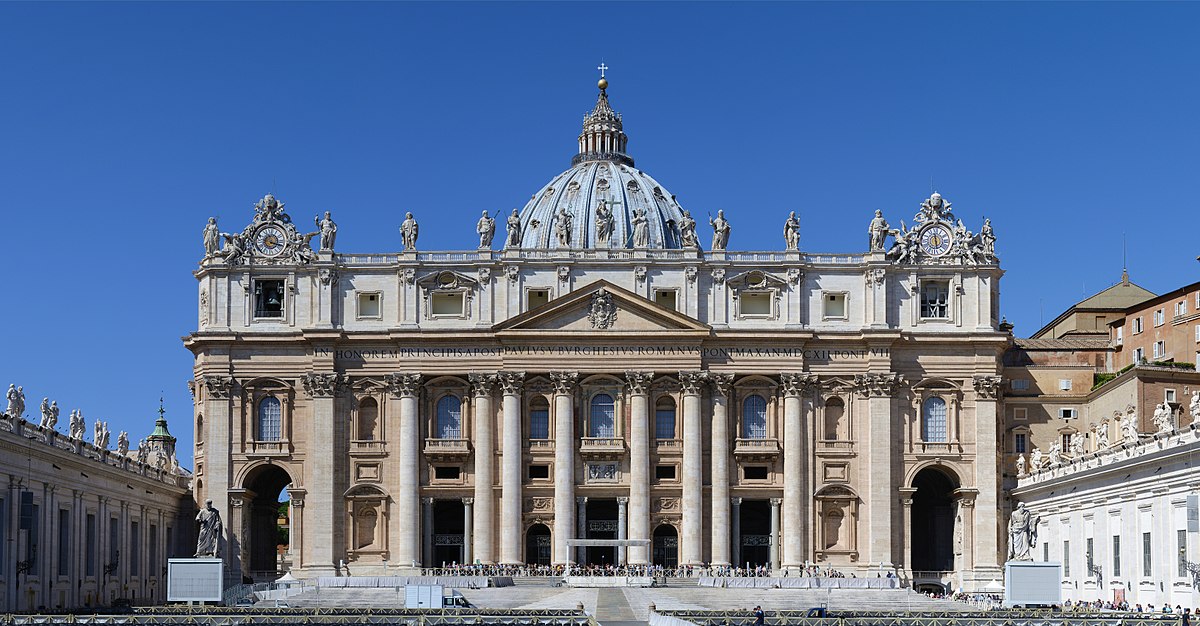
Italy offers religious groups some of Europe’s most popular pilgrimage destinations.
Every year millions of people flock to Italy to experience the food, wine, culture and beautiful coastal resorts. But Italy is also known for its religious history and is packed with religious pilgrimage sites. Home to the Pope, the country brims with opportunities for your religious group. Here are a few examples of prime destinations.
Rome Religious Sites
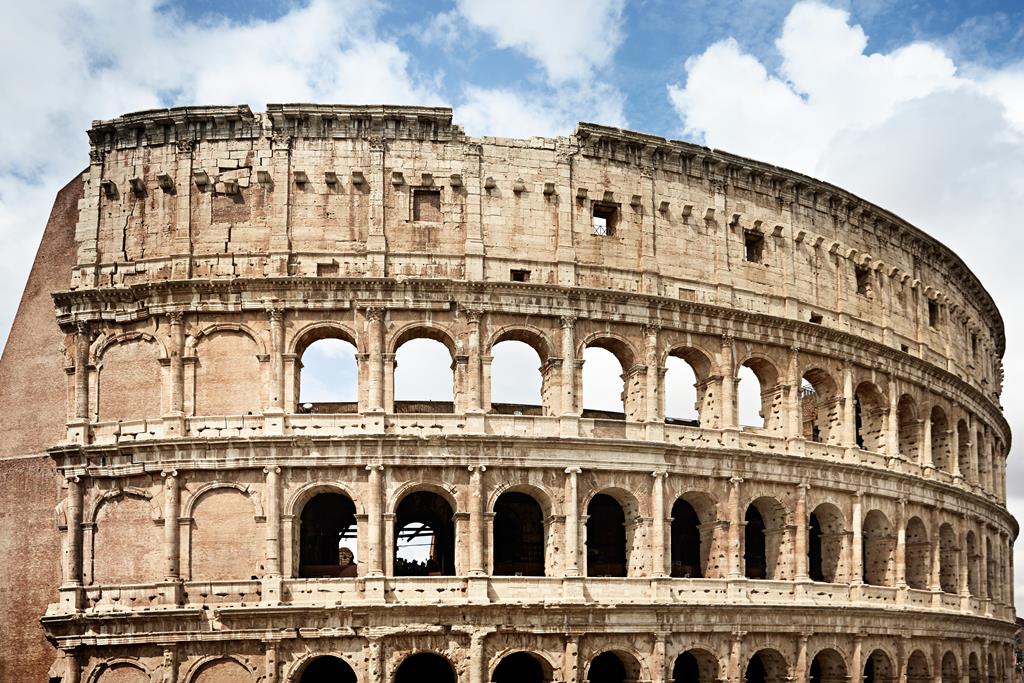
Rome is the most well-known pilgrimage site in Italy, and for obvious reason. As home of the Pope and Catholic faith, Rome offers ample opportunities for pilgrims. At St. Peter’s Basilica, the largest church in the world, the Pope leads liturgies throughout the year, attracting audiences of 15,000 to over 80,000 people. Part of the Vatican City complex, the church is dedicated to St. Peter, one of Jesus’ apostles. Catholic tradition holds that this is his burial site. The Sistine Chapel , located inside the Apostolic Palace , houses Michelangelo’s famous ceiling artwork The Last Judgment. Basilica of St. Paul Outside the Walls is another popular pilgrimage site in Rome. The basilica is dedicated to the apostle St. Paul and houses his burial site. Other notable sites are the Basilica of St. John Lateran , Basilica of St. Mary Major , Basilica of St. Lawrence Outside the Walls , Basilica of the Holy Cross in Jerusalem and Sanctuary of Our Lady of Divine Love .
Cascia (St. Rita)
Just a few hours northeast of Rome, Cascia is home to St. Rita , also known as “the Saint of the Impossible.” Rita of Cascia was born in 1381, and although she wished to join the convent, she was unable to after being married off by her parents at the age of 16. After the murder of her husband, her two sons sought revenge. She prayed that they wouldn’t seek revenge, and her prayers were answered, but not in the way that she wished. Her sons fell ill and died from the flu before they could get their revenge. Rita was also able to convince two feuding Italian families to sign an agreement, which was a huge accomplishment at the time. This is why she is referred to as “Saint of the Impossible.”
She was blessed with the Stigmata of the Lord on her forehead when she was 60 years old and bore it until the day she died at age 76. Rita was canonized by Pope Leo XIII in 1990. Her feast day is celebrated on May 22. Visitors can view St. Rita’s body in the Basilica of St. Rita , where her body remains incorrupt.
The Eucharistic Miracle of Cascia relics are also held at the Basilica of St. Rita.
St. Francis of Assisi
Assisi is home to both St. Francis and St. Clare. St. Francis of Assisi is best known as the patron saint of animals and the natural environment. Francis is recognized as one of the patron saints of Italy and is the founder of the Order of the Friars Minor , the Order of Saint Claire , the Third Order of the Saint Francis and the Custody of the Holy Land . He was canonized on July 16, 1228 by Pope Gregory IX. It has become a customary practice for churches to hold ceremonies to bless animals on his feast day of October 4.
The enormous Basilica di San Francesco d’Assisi is revered as one of the most important pilgrimage sites in Italy. The basilica contains two churches, which are known as the Upper Church and the Lower Church. It also holds the tomb of St. Francis.
St. Clare of Assisi was one of the first followers of St. Francis. St. Clare founded the Order of Poor Ladies and wrote their Rule of Life, the first set of monastic guidelines written by a woman. She was canonized on August 15, 1255 by Pope Alexander IV. Her designated feast day is August 12.
The Basilica of Santa Chiara in Assisi is dedicated to St. Clare and houses her remains. Visitors can also pray in front of the crucifix that spoke to St. Francis in San Damiano in the Basilica of Santa Chiara.
St. Gemma Galgani died in Lucca in 1903 at the young age of 25. She was canonized on May 2, 1940 by Pope Pius XII. St. Gemma was known for being a mystic, meaning she became one with God. It is said that Gemma experienced stigmata when she was 21 and claimed to have spoken to Jesus, the Virgin Mary and various saints in her state of mysticism. She is often remembered for her passion and referred to as “Passion Flower” and “Daughter of the Passion.”
There are multiple pilgrimage sites where travelers can experience the history of St. Gemma Galgani. The most popular site is St. Gemma’s Sanctuary. This is where a Passionists Monastery is dedicated to her. St. Gemma’s tomb lies under the altar. Personal items of St. Gemma’s such as clothes, shoes and books are kept here as well. Next, visitors can stop at Casa Giannini. This is where Gemma lived the last four years of her life. Guests will be able to see places in the house where Gemma worshipped. Just a short bus ride away, right outside of Lucca, is St. Gemma’s Birth House .
St. Catherine in Siena
Siena is famously the home of St. Catherine . Catherine had a great influence on the Catholic Church and was later declared a saint and a doctor of the Church. She was declared the patron saint of Italy, a titled shared with St. Francis of Assisi, in 1939. At the age of 21 Catherine experienced a “Mystical Marriage” with Jesus. Catherine devoted her life to helping the sick and poor. She became involved in politics and dedicated her life to spreading the word of God.
The home of St. Catherine, where she was born in 1347, has been turned into the Sanctuary of St. Catherine in 1464 and is a popular place of pilgrimage to this day. Nearby the sanctuary is Basilica San Domenico , where St. Catherine’s incorrupt head is kept on display. The rest of her body is kept in a tomb at Santa Maria Sopra Minerva in Rome.
The city of Siena is also home to the Eucharistic Miracle of Siena . In 1730, a ciborium that contained consecrated hosts was stolen from the Church of St. Francis. After the theft was discovered, the celebration of the Feast of Assumption was stopped. The priests asked for prayers and the town was searched for the missing ciborium. A few days later, a parishioner spotted a bright light illuminating from a collection box. The missing hosts were found covered in dirt. Since the hosts were dirty, it was decided to let them decompose naturally. But since 1730 the hosts have remained fresh. They are still preserved in the Basilica of St. Francis in Siena. They are put on display to the public on the 17 th of each month, the day they were discovered.
Venice Italy Pilgrimage Sites
Known for its gondolas and canals, Venice also holds significance in the Catholic Church. The city’s most popular church, St. Mark’s Basilica , lies on the Piazza San Marco . The body of St. Mark to whom the Gospel of Mark in the New Testament is attributed lies under the high altar. The upper part of the basilica is filled with beautiful mosaics using a background of gold glass tesserae, which creates a shimmer effect throughout the interior of the building.
Other churches of Venice include Basilica Santa Maria della Salute and Basilica Santa Maria Gloriosa dei Frari . Both are dedicated to the Virgin Mary. Basilica Santa Maria della Salute has three altars that are surrounded by paintings depicting the life of the Virgin Mary. Santa Maria Gloriosa dei Frari is famous for its beautiful altar and works of art.
Latest Traveling Tribes Podcast
Download latest issue.

Recent from Affinity Travel

Why Esports Tourism is On the Rise
According to Pew Research, the market for this spectator esports is growing rapidly, and its value is estimated to rise from $4.4 billion to $33.38 billion between by 2032.

Eat, Drink and Travel with Collette
Experience the perfect fusion of culture and cuisine with Collette. Immerse yourself in the delectable flavors of the world and discover how food unites us all.
Subscribe for Free

Best Places To Visit in Italy for Your Next Vacation

Perhaps it’s the exceptional food and wine, or maybe it’s the awe-inspiring architectural marvels that are beckoning you to visit one of the most beloved countries in Europe . Italy is a “bucket list” country for many travelers, and it’s easy to understand why. The citizens here are cheerful and personable; the landscapes stunning; the Mediterranean climate refreshing.
Whether you’ll be in Italy for a few days, a week, or a longer stretch of time, we encourage you to immerse yourself in the culture by visiting places that speak to Italy’s past, present, and future. In doing so, you’ll find yourself making memories and forming a deep appreciation for this boot-shaped country that, well, walks the walk and talks the talk when it comes to showing tourists a good time.
Here’s a list of some of our top recommendations for the best places to visit in Italy. Our intention is to help you elevate your itinerary and discover places you won’t soon forget.
Nature Explorers
If spending time in nature is on your agenda during your stay in Italy, you’ll be pleased with the country’s diverse landscapes.
Tre Cime di Lavaredo
The Dolomites (also known as the Dolomite Mountains or Dolomite Alps) are located in northeastern Italy. This mountain range is home to Tre Cime di Lavaredo , a UNESCO World Heritage site. It’s incredible to see these three magnificent, jagged peaks composed of layered limestone in-person—their height, their otherworldly appearance, and the way their silhouettes appear against the backdrop of the sky. If you prefer not to hike to these three peaks, you can visit them via car or bike. No matter how you get to Tre Cime di Lavaredo, you’ll be impressed by the panoramic views you’ll be afforded from beginning to end.
Located near the cities of Brescia and Bergamo in Italy’s picturesque Lombardy region is the smallest of Italy's Lombard Lakes. Lake Iseo is truly a sight to behold: between the dense woodlands, the gorgeous mountain peaks, and the calm waters that provide a source of entertainment and food for tourists and residents alike, this lesser-known lake should appear on your list of places to visit in Italy if you want to be surrounded by nature in a place that’s not too crowded yet still offers an abundance of things to do (markets, museums, and wineries, just to name a few).
Food Enthusiasts
From one region to the next, Italians excel at showcasing their unique takes on their favorite foods.
If you’re staying in Rome—or at least making a stop there—we encourage you to order some spaghetti. Romans serve their pasta alla carbonara, which means that your creamy pasta dish will be made with eggs, cheese (typically Pecorino Romano), cured pork (think pancetta or guanciale), and fresh black pepper. Since Rome is the birthplace of carbonara, it seems fitting to order this dish and any other traditional menu items at a restaurant of your choice in this ancient Italian city.
If you’re a fan of Parmigiano Reggiano, prosciutto di Parma, and balsamic vinegar, do yourself a favor and put Bologna on your list of places to visit in Italy. Street food stalls and trattorias are popular here, as is Grand Tour Italia , a food theme park dedicated to helping tourists learn about Italian cuisine and “traverse the entirety of Italy” by exploring the country’s agricultural, cultural, and folkloric connection to food and drink.
In many ways, Italy itself seems like a work of art—a living, breathing masterpiece that you can’t help but stare at and admire.
Add Florence to your list of places to visit in Italy if you’re captivated by the idea of standing in front of world-famous art created by Michelangelo, Botticelli, and da Vinci. Widely regarded as one of the birthplaces of Renaissance art, Florence attracts art lovers who could easily spend the day going from one museum to another (Uffizi Gallery, Accademia Gallery, Pitti Palace, Museo dell'Opera del Duomo, and Bargello Museum are all nothing short of incredible).
Naples Archeological Museum
The number of artifacts on display in the Naples Archeological Museum is simply stupendous. This museum is home to the most important collection of Roman art and artifacts in the world—from sculptures and mosaics to excavated treasures from nearby Pompeii, this museum delivers a fascinating glimpse into the daily lives, art, and culture of the ancient Romans.
If you’re traveling with infants, toddlers, young children, or teens, rest assured there are lots of places to visit and fantastic ways to spend high-quality family time in Italy.
There are more than 1,500 caves in Tuscany! If you’re traveling with children who would be mesmerized by these natural wonders, we recommend planning a visit to a cave in this region that appeals most to you and yours. Kid-friendly cave tours—such as the one at Grotta del Vento in Garfagnana—will give your family the chance to look around in awe at the stalactites and stalagmites. Children are sure to be thrilled by this mysterious underground world where the temperatures are cool, and they’ll be challenged to crawl through tight spaces and/or climb over rocks, which sets the stage for them to pretend that they are adventurers exploring a hidden cavern or spelunkers searching for a secret treasure.
Gardaland Resort
Adjacent to Lake Garda in the Verona province is a much-adored amusement park called Gardaland Resort . Known as the most famous amusement park in Italy, Gardaland invites parents and their children to enjoy numerous rides and attractions such as roller coasters, water rides, and live shows. There’s also a theatre, aquarium, and LEGOLAND water park in Gardaland, which makes it easy for parents to cater to their children’s ever-evolving whims as they make their way through the park and observe all that it has to offer.
Whether you prefer secluded beaches, or you don’t mind beaches that draw crowds, you’ll find plenty of beaches in Italy that align with your preferences.
If you love Italy’s warm Mediterranean climate and want to soak up some sun on a scenic beach, we recommend going to Sardinia . Behind Sicily, Sardinia is the second-largest island in the Mediterranean Sea, and it features coastal coves, sandy beaches, and crystal-clear waters across its coastline, which stretches more than 1,000 miles! Residents and tourists alike seem to agree that you can’t go wrong no matter which beach you select. Whether you end up at Rena Majori, Tuerredda, Cala Sisine, Portixeddu, or any other beach in this area, you’ll feel like you’re living in a postcard.
Chiaia di Luna
Chiaia di Luna charms tourists because it’s said to glow under the light of a full moon. This world-famous, crescent-shaped beach, located on the vibrant island of Ponza, stands at the foot of a volcanic rock cliff. Even though the beach itself has been closed due to rockfall and the increased risk of landslides, it should be on your list of places to visit in Italy if you want to plan a romantic sunset. You can view Chiaia di Luna from the water via boat (companies in Ponza offer cruises and boat tours) or take in its dramatic shape by visiting one of several lookout points that can be found on the island.
Summary of Places to Visit in Italy
We hope you’ll refer to this thoughtfully curated guide of places to visit in Italy when you plan your trip to Italy. We’re confident that you’ll be captivated by all the man-made amenities and natural wonders found throughout this beautiful country, and you’ll return home feeling grateful for the experiences you had and the memories you made.
Whether you’re traveling to Italy for business or pleasure—or both—we wish you safe travels and endless opportunities to discover what makes Italy a top destination for travelers of all ages.
Whenever you’re ready to book your next vacation to Italy, GOV+ makes it easy to get or renew your U.S. passport expedited in less than a week!

Get your passport without the hassle
GOV+ is the easiest and most secure way to get or renew your U.S. passport.
Related articles

© 2024 EIN Plus LLC. All rights reserved. GovPlus® is a registered trademark of EIN Plus LLC.
GovPlus® is a private online software technology company not affiliated nor endorsed by any Government or State agency. We do not charge for any forms, however, we charge for use of our software in assisting you with completing the form. We are not a financial, accounting or law firm and do not provide legal or financial advice.
Terms and conditions, features, support, pricing, and service options subject to change without notice.


12 Things Tourists Should Never Do When Visiting Italy
A nytime you visit another country, especially for the first time, there are bound to be some cultural differences. Even if the place you're visiting has a lot of familiar aspects to you, like a language, things will still be different. In a place like Italy, one of the prominent tourism hubs in Europe, that's doubly true. There are many social faux pas you'll want to be mindful of on your next adventure to Italia.
A few things on this list, like wading or touching the water at the Trevi Fountain, are actually illegal. However, the majority of these dozen societal no-nos are just uncouth. It is hard for a tourist to not look like a tourist when visiting a place, especially if you're mesmerized on your very first visit. Even so, we can do our best to be respectful visitors rather than stereotypical tourist tropes that will be dinner party conversation fodder for years.
However, don't let this list detract from the joy of traveling to Italy. Have fun, take a million pictures, and have the time of your life -- respectfully. Together, we can create a world of travelers instead of tourists!
Read more: The Best Budget-Friendly Tourist Destinations To Visit In The Mediterranean
Don't Dress Inappropriately When Visiting Sacred Sites
We get it -- if it's 90 degrees in Rome, you don't want to wear a lot of clothing. But it's important to recognize where you'll be each day when you decide on your outfit. Many churches in Italy, especially the cathedrals, have dress codes. Your skirts or shorts must go to at least your knees. You must also have covered shoulders. Otherwise, expect to pay in cash for a poncho or be denied entry. You do get to keep the poncho, though ideally, you can pack with these site visits in mind.
When visiting sacred sites, like churches still in operation, it's also essential to remember that people may be using it as such. Folks in the sanctuary might be praying or seeking spiritual refuge. Try to keep your voice down, obey any signs prohibiting photography, and be respectful. Americans have a reputation for speaking loudly, even when talking in what we believe to be a typical conversational volume. Just be aware of your conversations, or keep them to a minimum.
Also, silence your cell phones. Even a quiet ringtone can sound like a rock concert in a stunning Baroque cathedral with excellent acoustics. The name of the game for sacred sites and spaces is simply respect. So long as you keep that in mind, you should feel comfortable if you choose to visit these places.
Don't Touch The Water At Trevi Fountain
Bad behavior on social media of tourists going into the Trevi Fountain, stealing coins, or trying to take water home has caused uproar in Rome. Authorities are even considering putting up a physical barrier so that visitors can't get too close to the fountain anymore. Messing around with or getting in the water at the fountain can get you arrested and slapped with a hefty fine. Even eating or drinking on the steps leading to the fountain can incur significant fines as well.
You can still live your "Lizzie McGuire Movie" dreams and toss a coin in the fountain; don't worry about that. Just don't change your mind and try fishing it back out again. Taking money out of the fountain is also illegal. Even if it wasn't, trying to take your money back would be in poor taste, as the coins are collected and donated to different charities. The fountain's coins are a massive revenue source for those organizations.
If you're concerned about rules around places like the Trevi Fountain, just look around. Often, there are signs denoting prohibited activities. But sometimes, those signs just aren't there. An excellent way to determine if an activity is allowed is to see what others are doing. If a few tourists are doing something, but folks speaking Italian aren't doing those things, it's better not to do it. Observing locals isn't just a good way to find quality food in restaurants -- it's also a way to determine if a behavior is atypical.
Don't Forget To Validate A Train Ticket
Riding public transit in foreign countries can be intimidating, especially when you don't know all the rules. In Italy, though, it is essential to remember that you need to validate your train ticket before getting onto the train or risk a hefty fine if someone asks to see it. When you go into the train station, there is often a machine that you put the ticket into for validation. If you don't see a machine, try to ask someone. The word for "validation" in Italian is convalida.
You need to validate the ticket because it prevents it from being reused. If you don't validate the ticket, it may be viewed as you stealing train fare. The assumption will be that you want to use the ticket again for more fare later, even if you don't mean to get on the train without validating.
Sometimes, it takes work to find the validation machine. If you aren't comfortable asking someone for help, keep an eye on where folks are headed with their paper tickets. Chances are, if you see them walking around with a paper ticket, they'll likely lead you to the machine. Or someone will notice you don't know what you're doing and offer assistance. But don't count on that -- visitors look confused for many reasons, sometimes unrelated to the tickets.
Do Not Order A Latte
Before you think this is a smack in the face to anyone who doesn't like cappuccino, it's not. The word "latté" literally means "milk" in Italian. So if you ask a barista for a latte, you'll get milk or an embarrassing encounter when they ask if you mean coffee/espresso. What you actually want to ask for is a caffe latté. You can also order a latté macchiato, which is another common beverage. Between the latté macchiato and cappuccino, coffee with frothy milk drinkers will be right at home in Italia.
Cafés are everywhere in Italy. Even if you see a place that says "bar" outside, it will still serve coffee. You know that saying that you could throw a stone in any direction and you'll hit something? That's coffee spots in Italy. Italy invented espresso. It only makes sense that it is served practically everywhere.
Don't Accept Something For Free From A Stranger
Hustlers handing out "free" things to passersby is not a phenomenon original to Italy, though it is a common issue in the streets. Oftentimes, you'll be bothered by someone trying to give you a free friendship bracelet or a flower with the expectation that you'll tip them. Just ignore these folks or simply say "no, grazie" if you want to be polite. And absolutely do not make eye contact with or smile at the freebie givers -- that's an invitation for them to approach you.
Taking something for free doesn't even just refer to physical objects. Hustlers will also try to coerce you into letting them take your photo for you and then demand money for their otherwise "free" service. Some may be in costume, be overly friendly, insist that their service is free, or get pesky about getting you to cooperate. Don't be afraid to push back with a firm "no" if "no, grazie" is not a strong enough phrase.
You're especially susceptible to these freebie hustlers if you're in a large group, like a walking tour or a large group of travelers. Bonus points if you are all wearing matching tourist shirts. These rip-off artists will target you if you stand out like a sore thumb. A good tour guide will help you get rid of the street hustlers, but don't assume they'll even notice you need assistance if you're at the back of a very large group.
Avoid Pretty Gelatos
People love the look of gelato in the cooler, piled high with delectable chocolates or fruits -– but these are the ones you want to avoid in Italy. When gelato is overly bright or covered in stuff, it often shows that the gelateria is not quality. The best gelato doesn't look super beautiful, though it will taste heavenly. Overly bright gelato is riddled with artificial flavors and colors to make it look nicer, too, so it probably won't have as rich of flavor as a more natural version.
Phrases you want to look out for when shopping around for the best gelato are homemade, made in-house, or artisanal. Often, they won't be in English, so keep an eye out for gelato in casa, fatto in casa, or gelato artigianale, which are the respective translations. Like restaurants, watch for which gelateria is populated mainly by locals and not just tourists. Tourist-laden gelaterias are far less likely to have legit gelato.
Something else to consider is that a lot of gelaterias only take cash. So, if you want authentic gelato from a small shop, ensure you have cash with you since many of them will not take credit cards.
Don't Contest The Coperto Or Cover Charge
Cover charges are common at restaurants around Italy. These coperto charges cover things like linens and water for the table. They are not contestable. They're just standard practice in the country. They're also usually just one or two euros, so it isn't worth fighting the restaurant over. Coperto fees are legal, like sales tax, in most of Italy. The exception is the Lazio region, where Rome is located, because coperto charges were outlawed in the 1990s.
Even if the restaurant doesn't mention using coperto charges, they may still have an additional fee like it. In Italy, restaurants don't usually serve bread entirely for free. So you may see a small euro charge on the bill at the end for pane or pane e coperto if you are served bread with your meal. In that way, the pane fee is like a coperto charge without being called as such.
When encountering fees like this, remember that Italy's tipping culture is much different than in the United States. It isn't mandatory or expected. Coperto is not a tip for the staff by any means, though a few euros on top of your bill will still cost you less than if you tipped the standard U.S. 15-20%.
Don't Order A Cappuccino After 11 Am
In Italy, a cappuccino is considered a breakfast beverage. Obviously, you can still get them in many places after 11 a.m., but folks will be judging you for it. Cappuccinos are meant to be consumed with things like pastries, not lunchtime pasta. It's not just cappuccinos either. Any milk-based espresso is frowned upon during the afternoon because it is believed that the dairy will adversely affect your digestive system for the rest of the day.
Espresso, however, is a totally different story. Espresso can be (and is) consumed throughout the day. It is often served with a glass of water, too, to cleanse your palate before enjoying the rich flavors of Italian espresso. The barista or server will ask if you prefer liscia or frizzante/gassata water, which means still or sparkling/carbonated.
You should also know that beverage sizes aren't really a thing in Italian cafes. If you order a cappuccino, it will be about six ounces, while a caffé latte or equivalent will be about eight ounces. American coffee sizes, or size differentiations at all, are very uncommon. It goes without saying that ordering an espresso will get you a shot of espresso. If you order an espresso, it's okay to sip it -- you absolutely do not need to shoot it like a lemon drop at a dive bar.
Don't Forget To Book Site Tickets Ahead Of Time
When you visit Italy and want to see some of the most famous sites like the Vatican or the Coliseum, you should book tickets in advance. You don't have to, of course, though it will save you a lot of time and aggravation. You might not get in if you don't book ahead, especially during tourism high season. Especially if you're visiting in the summer, not booking in advance could result in waiting in line (often in the sun) for hours.
Depending on the kind of schedule you're adhering to, you may want to pay a little extra for skip-the-line tickets to spend less time in the queue and more time at the attraction or sightseeing. There are often other ways to acquire tickets, which could save you money. You could purchase a city pass or day tours that cover attraction tickets. Day tours frequently visit several sites, depending on where they are and how long they take, resulting in saving money and probably learning more about those places than you would going on your own.
When making your plans, list attractions from the must-sees to the could-skips. If you create an order to explore the sites, you can determine which attractions might be worth purchasing skip-the-line tickets for before heading to Italy. The splurge may be more worth it if there is a museum or location that's highest on your list of things to see to give you more time there. Then you can save money elsewhere .
Don't Default To English All The Time
Tourist-heavy parts of Italy like Rome or Milan will have a lot of Italians, especially in hospitality roles, that speak at least some English. Even so, you should go to Italy with a few phrases memorized so that you don't have to default to English in your daily interactions. It'll be hugely appreciated.
Statistically, only about ⅓ of Italians speak basic English. One could assume the majority of those folks who do speak basic English live in places like Rome or Milan where a lot of English-speaking visitors go. It is even more important to be able to speak a little Italian if you are spending time outside of the country's biggest tourism locales.
Besides the few phrases and words we've already shared in this piece, there are several more that you can and will use daily if you so choose. For example, Buongiorno/salve for "hello," ciao for "goodbye," and per favore for "please" will get you a long way socially. Everyone appreciates understanding one another's sentiments.
Don't Expect Dinner In The Early Evening
Compared to the rest of the world, Americans eat dinner quite early. That can be a shock when visiting a place like Italy, where dinner isn't really served until at least 7:30 p.m. Still, tourists are surprised when they can't get 5 or 6 p.m. dinner reservations -– restaurants may not even be open for dining that early.
If you're starving and it's still too early for dinner, just look around. Some restaurants and even bars may be serving an aperitivo buffet. You can head in and order a cocktail or a drink and enjoy small bites like a curated charcuterie board. That should tide you over until the dinner services begin.
Also, some restaurants offer two dinner seating options in touristy cities. They will serve an earlier dinner for tourists or early eaters and a later dinner for locals or later eaters. It just goes to show that not all hope is lost if you need an evening meal before the rest of Italy. Still, for a fuller experience, it's advised that you try and wait it out to fully enjoy the local culture.
Don't Order Food Like A Tourist
Fettuccini alfredo might be a famous dish attributed to Italy worldwide, but it isn't really served in Italy. It is served at one particular restaurant in Rome, just not anywhere else. So you can't just show up to a restaurant and ask for it, as it's not on the menu. The only place with fettuccini alfredo is ll Vero Alfredo or L'Imperatore delle Fettuccine (the Emperor of Fettuccine). There, you can taste the original recipe that people worldwide fell in love with.
Putting cheese on a fish-based dish is frowned upon, like the no milk-based beverages after 11 a.m. rule. In Italy, the flavorful nature of seafood pasta is something that should be appreciated without putting cheese on it, which masks or overpowers the subtle flavors. It is also said that combining seafood with dairy is terrible for your digestive system -- see a pattern? Keep that cheese far away from your Scialatielli Allo Scoglio.
Read the original article on Explore .


IMAGES
COMMENTS
St. Mark's Basilica is a must-visit, it is a place of great spiritual and cultural importance, and its connection to St. Mark and the Christian faith makes it a meaningful pilgrimage site in Italy for those seeking to deepen their faith and connect with the history and traditions of the Church.
Along with the Doge's Palace, St Mark's Basilica is one of Venice's must-see attractions and one of the most famous cathedrals in the world. Located in the center of the city in the Piazza San Marco and known as the "Church of Gold", this cathedral has splendid decorations that have been continually updated since the original construction in 1093.
Cosenza : Cathedral of Saint Mary of the Assumption & Shrine of Our Lady of Pilerio. Cursi: Shrine of Our Lady of Abundance. Faenza: Tomb of Saint Peter Damian in the Cathedral of Saint Peter the Apostl e. Florence: Birthplace of the Renaissance…many Catholic places to visit. Foggia: Shrine of Our Lady Mother of God.
Table of Contents. 19 Famous Catholic Pilgrimage Sites in Italy. 1. Vatican City in Rome. 2. Basilica of Saint Francis of Assisi in Perugia Province. 3. Basilica of Saint Clare in Assisi in Perugia Province. 4.
The Montecassino Abbey in Italy is a remarkable pilgrimage site steeped in centuries of profound history. Founded by St. Benedict in the 6th century, this iconic abbey is one of the oldest monasteries globally. The abbey endured many adversities. It was destroyed and rebuilt four times.
Those are only three of about a dozen religious sites in Assisi. Anyone who visits will be able to explore every step of St. Francis' life and ministry. 2. The Abbey of San Galgano in Chiusdino. Source Image. Located in Chiusdino about 20 miles from Siena, The Abbey of San Galgano houses the sword in the stone.
Together, San Giovanni and the adjacent Sancta Sanctorum, the "Holy of Holies," contain some of the holiest relics in Rome. Reliquaries include the heads of Saints Peter and Paul; the Holy Stairs (Scala Santa), taken from the palace of Pontius Pilate; and wood from the table used during the Last Supper. 03 of 10.
A word of warning about local tour guides in Rome: Some local guides are excellent and some are very poor. In addition, some can be quite anti-Catholic. Comments such as "these items were stolen from…..and brought to Rome" or the use of the word "legend" rather than "tradition" will give the traveler a biased and in-accurate ...
The "Holy House of Mary" is a work of immense artistic value as well as religious, being clad with white marble to a design by Bramante (1444-1514). In the sacristy you can see frescoes by Melozzo da Forli (1438-1494) and Luca Signorelli (1445-1523), while in the dome we have the "Four Evangelists" by Cristoforo Roncalli, known as ...
Most people associate this city with its winding canals and gondolas: Venice has about 150 canals, more than 400 bridges, and no cars, which means it is one of the worlds few pedestrian-only cities. Venice was at one time the most powerful nation-state in the region and traces of that still remain. It is also home to some magnificent Catholic ...
The St. Francis Basilica in Assisi. Contributed by Ivan from Mind The Travel. The St. Francis Basilica is one of the best destinations for the pilgrimage to Italy and to Europe in general. It is an incredible jewel in the crown of spiritual buildings in the city built in the 13th century in honor of St. Francis.
The Way of San Vili: An Italian Pilgrimage Route. The pilgrimage path I took in Italy goes by a few different names: The Way of San Vigilio. The San Vili Path. and, in Italian, the Cammino San Vili. The path follows the route of the Italian saint San Vigilio, who carried Christianity into the mountains from his home base a Bishop of Trento ...
The Holy Face has been a popular site of Catholic pilgrimage since it arrived in Lucca in the 9th Century. In fact, as one of the most mystical relics in Christendom, pilgrims have walked from as far away as Canterbury in England to visit the Holy Face for hundreds of years. The town of Lucca is also located on the Via del Volto Santo, a 200 km ...
The Basilica of The Holy Cross in Jerusalem. The Sanctuary of the Madonna of the Divine Love. The Basilica of St. Paul Outside the Walls. Bari, Italy: What To Do If You Only Have A Weekend To Visit. The Monumental Cemetery of Verano Is Another Hidden Gem In Rome. The Palatine Hill In Rome, Italy: This Is Your Guide.
by Martha Bakerjian. La Sacra di San Michele, or Saint Michael, is a stunning Abbey and monastic complex sitting atop a hill in Piemonte's Susa Valley, about midway between Mont San Michel in France and San Michele Sanctuary in Puglia. Dating from 983, it became one of Europe's most famous Benedictine monasteries from the 11th - 14th centuries.
Table of Contents. 20 Must-See Churches in Italy. Santa Maria Assunta (Duomo di Siena), Siena. Santa Maria del Fiore, Florence. St. Peter's Basilica, Vatican City. Santa Maria Nascente, Milan. Santa Maria sopra Minerva, Rome. The Pantheon, Rome. St. Mark's Basilica, Venice.
If you're planning a visit to the Vatican, you won't want to miss the papal basilicas, which are some of the most stunning churches in Rome.Saint Peter's Basilica, located within the Vatican City, is the largest and most famous of all the basilicas.This breathtaking church features works by some of the greatest artists of the Renaissance, such as Michelangelo's "Pieta" and Bernini ...
Basilica of San Giorgio in Velabro. This medieval church in Rome was almost destroyed following a terrorist attack in 1993. Assisi, Italy.
2024. 5. Duomo - Cattedrale di Santa Maria del Fiore. 29,125. Religious Sites Duomo Admission tickets from $66. By jonathancchan. Gorgeous cathedral with situated in the town square - lots of restaurants, shops, and beautiful architecture to gaze at. See ways to experience (278) 2024.
World Pilgrimage Guide by National Geographic photographer Martin Gray. Information, pictures, maps of 1500 holy places and sacred sites in 160 countries. Myth ...
The enormous Basilica di San Francesco d'Assisi is revered as one of the most important pilgrimage sites in Italy. The basilica contains two churches, which are known as the Upper Church and the Lower Church. It also holds the tomb of St. Francis. St. Clare of Assisi was one of the first followers of St. Francis. St.
What is interesting is that the ceiling has strategically placed holes near the altar played to amplify the monks' voices. This is also a good place to visit due to its serenity away from the populated tourist areas. Florence Charterhouse. Address: Via del Ponte di Certosa, 1, 50124 Firenze FI, Italy. Website: Florence Charterhouse. Price: 5 USD
Visit the Sanctuary of St. Michael the Archangel in Monte San Angelo and departure for Lanciano. Dinner and overnight in Lanciano Day 7 Lanciano-Loreto-Assisi Visit the Church of St. Legontian, where the Eucharistic Miracle took place. Departure for Loreto and visit the Holy House of Nazareth and the beautiful Madonna of Loreto.
In many ways, Italy itself seems like a work of art—a living, breathing masterpiece that you can't help but stare at and admire. Florence. Add Florence to your list of places to visit in Italy if you're captivated by the idea of standing in front of world-famous art created by Michelangelo, Botticelli, and da Vinci. Widely regarded as one ...
A nytime you visit another country, especially for the first time, there are bound to be some cultural differences. Even if the place you're visiting has a lot of familiar aspects to you, like a ...
2024-08-18 Sunday 10AM Mass